#i had no idea their architecture program was under fine arts
Text
completely folded on my 2nd choice application .. im so blown that was a waste of $70
#i had no idea their architecture program was under fine arts#i shld have checked their website before applying but on the application website there was no indication of it being in the art school or#under a fine arts degree#so now they want a portfolio and all this information on my art background#I TAKE ENGINEERING CLASSES 😭#i can’t even do art for my own enjoyment anymore and they want me to come up with TWELVE pieces by february ???? fuck that shit man#also the first time i logged into the applicant portal the to do list they have told me i completed everything i need to#so that was weird
3 notes
·
View notes
Note
Okay so I have this idea of the boys in the modern world! Like what kind of profession/ college course would Azul, Malleus, Leona, Lilia, and Idia would take? Some modern au headcanons with them please!
Curiouser and Curiouser...

Idia Shroud...
...would be an e-girl Twitch streamer that sells his bath water a famous video game let’s player or streamer, maybe even a professional gamer.
But the type that doesn’t show his face, or uses some kind of prop to censor his face whenever he happens to be on camera.
His online personality and his real life personality are so different...! Idia turns down invitations to conventions and fan meets because he worries about how his followers and fellow content creators. will perceive those very different sides to him.
He still makes bank off of his merch though.
I can see him taking college courses for tech-related things so he always has an excuse to hole up in his room and avoid normies. Computer science, video game design, etc.
He does well in school, but if he ever needs to give a speech/presentation or do a group assignment, well...Idia’s gonna bomb it. Thanks a lot, crippling social anxiety.
Disturbs his room mates and his neighbors constantly because of his video game raging late into the night.
The type to show up to lectures in his pajamas if he shows up at all.
Looks like he has gotten zero sleep all the time even if he slept for a full day and then some.
Wears headphones everywhere in public and blasts music at maximum volume so everyone around him can hear it and knows that he doesn’t want to be disturbed.
Llilia Vanrouge...
...is a child daycare worker or a teacher. On weekends, he moonlights as the lead guitarist and vocalist for a death metal band (though he never brings this up in parent-teacher conferences)
He studied history in college, but he discovered his love for childcare when he was tutoring high school students in history as part of a volunteering program...so Lilia changed career paths!
Don’t get him wrong, he still loves history and he’ll tell the little tots under his care all about the most interesting tidbits of it.
But everyone loves him, from his coworkers to the parents to the children under his care. Lilia is just loads of fun--but he knows when he needs to dial back and be serious, too.
Back in school, he was always getting into trouble for small pranks. Spooking the other students, drawing on school property with chalk, etc.--nothing that would get him expelled.
Kind of an easy-going student. If he did well, that’s great. If he did’t do well, that’s also fine! He goes with the flow and doesn’t sweat the details.
Lilia worked really hard for his degree though, especially since he changed it abruptly into something so different.
He volunteered a lot during his studies, wishing to give back to the community and to be with the children even before he had his degree.
Leona Kingscholar...
...is an unemployed rich kid living off of daddy’s money. He’s the second son to some big business or even actual real life royalty.
Have you see how lazy this man is? Of course he doesn’t have a job.
Leona only attends college because his parents threatened to completely cut him off if he didn’t. (”Your older brother Farena went to college, found himself a nice girl, and got himself a stable job that pays well; why don’t you too?”)
Probably got in on an athletic scholarship. What a chad.
He studies liberal arts, English literature, or women’s studies (because he thinks those subjects are easiest to pass with minimum effort and because he respects women).
Very sleepy boi. Falls asleep during the first few seconds of every single lecture (if he’s even there on time), and it is impossible to wake him up.
Shows up late to class. Like...five minutes before the end of class late.
He falls asleep in the most random public places all over campus.
The master at pulling all-nighters.
Most likely sleeps around (both literally and metaphorically).
Popular with the ladies, even if he doesn’t go out of his way to pursue many. Leona won’t force himself onto them, but he won’t say no if they proposition him and he’s feeling bored enough. Might as well have some fun while he’s forced to be here, right?
Has zero idea where he is going in life. Don’t we all?
Malleus Draconia...
...studies architecture, or art history.
He’s so fascinated by the design of buildings and how styles have changed so much over time.
Tends to daydream. This, paired with his resting bitch face and inimidating aura, makes everyone fear him.
Malleus likes to walk around town and the college campus just to enjoy the buildings. Because of this, his peers think of him as “the local scary-looking weirdo”.
Comments like that hurt him, but Malleus tends to bottle up his emotions and be sad about it in the comfort of his personal quarters.
Malleus tries showing up to publicized college events and every club meeting he can think of, but people tend to keep their distance from him.
Probably phones up his family every other night just to check on them and hear their voices. He’s very lonely...
Has a hard time finding a job because many people are intimidated by how he looks. Ends up overwhelming many interviewers.
Probably works part-time at a discreet WcDonald’s location. Nothing glamorous or high-paying, but Malleus doesn’t expect anything like that while he’s still a student. Plus, he is still thankful for the job experience.
Lands a job at a big building firm after college; quickly rises through the ranks and becomes the CEO. All of his haters must be jealous now, huh?
Still, Malleus feels no ill will towards them. He hopes he can be friends with them at the college reunions.
Azul Ashengrotto...
...works as a drug dealer barista and manager of a coffee shop or cafe. If you want to get darker, he runs a casino (where everything is rigged in his favor) and/or is a mafia lord (just look at Octavinelle’s aesthetic) by night.
He dual-majors in business and law because his brain is just that large.
Straight A student, in the honors program, and a teacher’s pet. Most likely a full ride scholarship as well.
Also the president of student government or the head of a club--Azul has stacked his resume with achievements and titles. Employers will be tripping over themselves to hire him.
Azul applies what he’s studying in college into his business (albeit in less-than-savory ways) to maximize his profits and to scare of unruly customers.
He has a lot of friends in college, but he’s not particularly close to any of them.
Binge eats when he’s stressed.
Do not bring up school prior to college life to him; Azul will get war flashbacks to the time when he was bullied. He refuses to talk about his past, and if you keep persisting, he will get back at you.
Despises group projects; he ends up doing all of the hard work. He’s super passive aggressive about it.
Snitches on anyone that crosses him, even slightly. Azul is very petty. Oh, you forgot to return that pencil that he so generously lent you for the exam? Well, prepare to have your embarrassing photos from that one crazy party leaked to the college newspaper.
#twst#disney twisted wonderland#twisted wonderland#Azul Ashengrotto#Leona Kingscholar#Idia Shroud#Malleus Draconia#Lilia Vanrouge#twisted wonderland headcanons#twisted wonderland imagines#twisted wonderland requests#twisted wonderland scenarios#curiouser and curiouser
441 notes
·
View notes
Photo
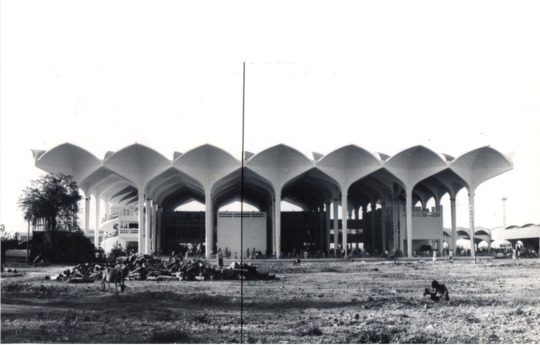
Kamalapur Railway Station in Dhaka
Architectural Optimism of Bangladesh
Saša Šimpraga, 2021.
Adnan Zillur Morshed is an architect and architectural historian with focus on history and theory of modern architecture and urbanism; global history; urban poverty and spatiality; water and architectural historiography; and ecological urbanism in developing countries. He received his Ph.D. and Master’s in architecture from MIT and completed his pre-doctoral studies at the Center for Advanced Study in the Visual Arts at the National Gallery of Art and postdoctoral under Verville Fellowship at the National Air and Space Museum in Washington, DC.
Morshed is the author of several books among other: Impossible Heights: Skyscrapers, Flight, and the Master Builder which examines the American fascination with the skyscraper and the airplane as part of a widely shared cultural phenomenon--the aesthetics of ascension--that characterized the interwar period. His books also include DAC, Dhaka through Twenty-Five Buildings.
He is a professor at the School of Architecture and Planning of the Catholic University of America in Washington, D.C.
Adnan Morshed is also involved with local and international intiatives on preservation of modernist architectural heritage of Bangladesh. We talk to him on the occasion of current international appeal to save the Kamalapur Railway Station in Dhaka from demolition.
SŠ: A gem of the Modern Movement in South Asia, The Kamalapur Railway Station in Dhaka, designed by Daniel Dunham and Robert Boughey in the 1960s is threatened due to the an urban expansion plan of the Dhaka Metro Rail's Line that includes its demolition and replacement by a new infrastructure, rather than its adaptation. What is the significance of the building and its current status?
Adnan Morshed: Kamalapur Railway Station is a rare modern train station in South Asia. It adopts an aesthetic vocabulary of tropical modernism for a public building in ways that have not been seen before in the region. The station’s modernist architecture breaks with colonial precedents both in the imperial center and on the subcontinent. In London, St. Pancras Station (1863–76) encapsulated modern values of mobility and exchange, while the Chhatrapati Shivaji Terminus (formerly Victoria Terminus; built in 1888 and now a UNESCO World Heritage) in Mumbai and Howrah Station (1906) in Kolkata functioned as symbols of imperial hegemony.
The histories of colonialism and train infrastructure are deeply intertwined in South Asia. In 1862, the Eastern Bengal Railway Company opened the first railway line in the region from which it took its name. Connecting Kolkata with the western Bangladeshi town of Kushtia, this expansion of train services signaled a new phase in the growth of East Bengal’s colonial economy. Due to geographical challenges posed by Bengal's deltaic terrain, the railway did not arrive in Dhaka until the following century, after the city’s economic profile had risen and it was subsequently made, in 1947, the provincial capital of then-East Pakistan. In 1958, the government approved the creation of a new railway depot, which was inaugurated a decade later as Kamalapur Railway Station. Not only was it one of the largest modern railway stations in South Asia, but it also embodied changing conceptions of modernity, from the bracing mobility of 19th-century railways to the soaring modernism that defined the 1960s.
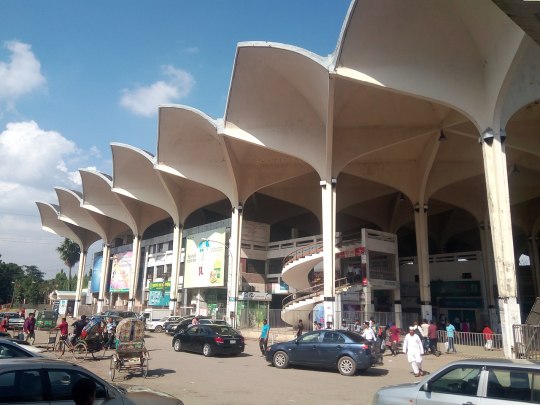
Kamalapur Railway Station, Photo by Anik Sarker/ Wikipedia
SŠ: Also in danger of demolition is the Dhaka University Teacher-Student Center Building by Greek architect Constantinos Doxiadis (the mastermind behind planning the city of Islamabad) from early 1960s. The structure exemplifies a modernist architectural sensitivity toward spatial needs for tropical climatic conditions. TSC's dome-shaped structure with empty spaces around is considered an iconic landmark not only inside Dhaka Uiversity campus, but in the broader cityscape of Dhaka. How optimistic are you about its future? And what is the general status of modernist architectural heritage of Bangladesh?
Adnan Morshed: I am concerned about the mid-20th-century buildings in Bangladesh because of the ways the notion of development is taking precedence over environment, history, and, generally, human wellbeing. Many buildings are about to face the wrecking ball. These buildings include the Teacher-Student Center or TSC. Located at the historic heart of the University of Dhaka, TSC exemplifies a type of tropical modernism that blends local architectural traditions of space-making—particularly the indoor-outdoor continuum and generation of space around courtyards—with the abstract idiom of the International Style. The complex of buildings was designed by the Greek architect, planner, and theoretician Constantinos Apostolos Doxiadis (1913–1975) in the early 1960s. This was a turbulent time marked by conflicting currents of political tension and architectural optimism in what was then East Pakistan, now Bangladesh. On the one hand, the two wings of postcolonial Pakistan were at loggerheads because of the political domination of East Pakistan by the military junta based in West Pakistan. On the other hand, many architectural opportunities arose in East Pakistan, which benefitted from American technical assistance. The United States allied with Pakistan as part of its Cold War-era foreign policy to create a geostrategic buffer against the socialist milieu of the Soviet Union–India axis in South Asia. Under the purview of a technical assistance program, the United States Agency for International Development and the Ford Foundation provided support for building educational and civic institutions in East Pakistan. Since there was a dearth of experienced architects in East Pakistan, the government sought the services of American and European architects for a host of buildings that were constructed during the 1960s. Doxiadis was among them.

TSC, Photo by Fasiha Binte Zaman/ Wikipedia
TSC is also a demonstration of Doxiadis’s idea of ekistics, by which he meant an objective, comprehensive, and integrative approach to all principles and theories of human settlements. Criticizing the top-down planning model which he viewed as a central problem associated with modernism, Doxiadis employed the notion of ekistics to promote a multidisciplinary, inclusive, and bottom-up approach. He hoped that such a method would create a synergy of local and global influences, by which one could successfully meld a data-driven theorization of planning, universal values of harmonious living, and place-based cultural inflections.
In this vein, Doxiadis aligned the TSC’s ensemble of buildings on an east-west axis, to take advantage of the prevailing breeze from the south or north. The three-story Student Union Building features a “double roof” that minimizes heat gain by allowing cool breezes to pass in between the two canopies. The ingenious solution proved to be a trendsetting feature, but it was just one of the complex’s many innovations. Doxiadis covered the auditorium with a reinforced concrete parabolic vault, a pioneering construction technique that had yet to be tested in the country. Covered walkways, supported on steel columns, weave together the major buildings and green spaces, serving as the social spine of the entire complex. In the post-Independence period, TSC became the epicenter of political agitation within Bangladesh, serving as a backdrop to political demonstrations.
SŠ: Pioneer od modernist architecture in Bangladesh, Muzharul Islam, began hes career in the 1950s. Born in 1923, he went to study architecture in the United States, and then returned to Bangladesh. Along with his teacher Louis Kahn, he also brought Paul Rudolph and Stanley Tigerman to work in Bangladesh, and three of them came to be known as the American Trio. Apart from the Trio, it was Islam's style that dominated Bangladesh architecture from 1950s onwards. What is his legacy in architectural history of Dhaka?
Adnan Morshed: Not only was architect Muzharul Islam Bangladesh's pioneering modernist architect, he was also an activist designer who viewed architecture as an effective medium for social transformation. His early work shows how architecture was deeply embedded in post-Partition politics.
Consider his “master piece,” the Faculty of Fine Arts (1953-56) at Shahbagh in Dhaka. At first encounter, the building presents the image of an international-style building, with a quiet and dignified attention to the architectural demands of tropical Bengal. Closer inspection, however, hinders the Eurocentric tendency to measure the building's “modernity” exclusively through a “Western” lens. A host of nuanced architectural modulations and environmental adaptations reveals how Muzharul Islam's work cross-pollinates a humanising, modernist architectural language with conscious considerations of climatic needs and local building materials.
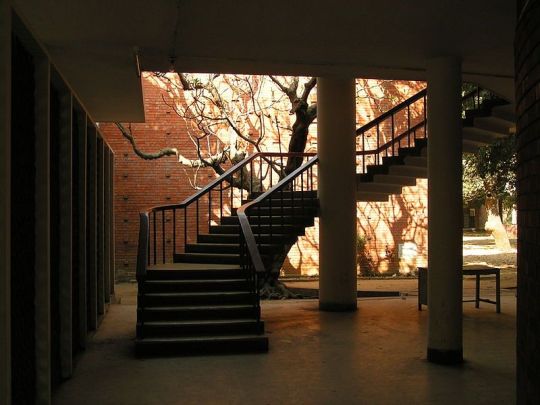
Faculty of Fine Arts, Photo by Rossi101/ Wikipedia
The literature on South Asian modern architecture usually identifies the Faculty of Fine Arts as the harbinger of a Bengali modernism, synthesising a modern architectural vocabulary with climate-responsive and site-conscious design programmes. What has not been examined in this iconic building is how Islam's work also provides a window into the ways his architectural experiments with modernist aesthetics were part of his inquiries into the ongoing politics of Bengali nationalist activism.
Muzharul Islam interpreted the prevailing political conditions in his homeland as a fateful conflict between the secular humanist ethos of Bengal and an alien Islamist identity imposed by the Urdu-speaking ruling class in West Pakistan. The turbulent politics in which he found himself influenced his worldview as well as his fledgling professional career. The young architect began his design career in a context of bitterly divided notions of national origin and destiny, and his architectural work would reflect this political debate. He felt the need to articulate his homeland's identity on ethno-cultural grounds, rather than on a supra-religious foundation, championed by West Pakistani power-wielders. Muzharul Islam's Faculty of Fine Arts embodied these beliefs.
With his iconoclastic building, Islam sought to achieve two distinctive goals. First, the building introduced the aesthetic tenets of modern architecture to East Pakistan. For many, its design signalled a radical break from the country's prevailing architectural language for civic buildings. These buildings were designed either in an architectural hybrid of Mughal and British colonial traditions, popularly known as Indo-Saracenic, or as utilitarian corridor-and-room building boxes, delivered by the provincial government's Department of Communications, Buildings, and Irrigation (CBI). The Faculty of Fine Arts was an unambiguous departure from the colonial-era Curzon Hall (1904–1908) at the Dhaka University, within walking distance of Islam's building, and the Holy Family Hospital (1953; now Holy Family Red Crescent Medical College Hospital).
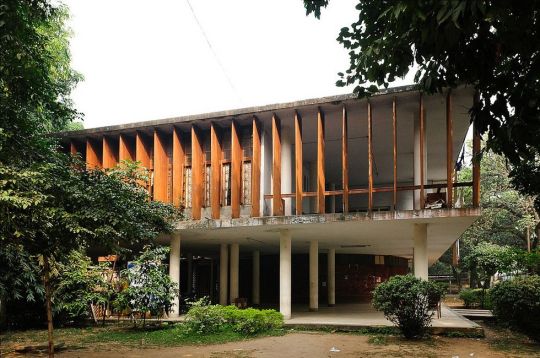
Faculty of Fine Arts, Photo: Wikipedia
Second, the Faculty of Fine Arts' modernist minimalism—rejecting all ornamental references to Mughal and Indo-Saracenic architecture—was a conscious critique of the politicised version of Islam that had become a state apparatus for fashioning a particular religion-based image of postcolonial Pakistan. By abstracting his design through a modernist visual expression, Muzharul Islam sought to purge architecture of what he viewed as the political associations of instrumental religion.
SŠ: Internationally, perhaps the most known modernist structure in Bangladesh is the National Parliament Complex, designed by Louis Kahn and associates. Its construction began in 1964, in what is now known as the Decade of Development for Bangladesh and time when Dhaka was the second capital of Pakistan. When talking about architecture in general, Muzharul Islam stated that „practical aspects of architecture are measurable – such as, the practical requirements, climatic judgments, the advantages and limitations of the site etc. – but the humanistic aspects are not measurable.“ Those aspects come when the architect leaves and building starts its life. How did that highly acclaimed complex came to be a part of the national identity and how its architecture influences culture in a broader sence?

National Parliament Complex in Dhaka, Photo: Yes, Louis Kahn
Adnan Morshed: The American architect Louis Isadore Kahn's Parliament building in Dhaka is considered one of the architectural icons of the twentieth century. Intriguingly, Kahn was not the first choice for the project. After two masters, Le Corbusier and Alvar Aalto, had turned down the invitation from the government of Pakistan, the megaproject went to the architect from Philadelphia. After multiple design iterations and many bureaucratic entanglements, the construction of the Parliament building began in October 1964, at Sher-e-Bangla Nagar.
Kahn first visited Dhaka in early March of 1963, after he had received the commission to plan the Parliament complex of East Pakistan. Five years earlier, the commander-in-chief of the Pakistani army, Mohammad Ayub Khan, took control of the government through a military coup and imposed martial law in October 1958. In 1960, the military man was “elected” to a five-year presidency. Pakistan's new constitution of 1962 called for a “democratic” election to be held in 1965. The decade of the 1960s was a politically tumultuous period in East Pakistan. Bengalis felt exploited and ignored by West Pakistan's military regime and, consequently, dreamed of independence from the doomed political geography of a nation with two units separated by over 1,000 miles. Aware of the political and economic disparity between the two halves of Pakistan and concerned about his own re-election bid, Ayub Khan's administration came up with a political strategy to mitigate the grievance of the Bengalis.

National Parliament Complex in Dhaka, Photo: Yes, Louis Kahn
The idea of a “second capital” for East Pakistan was born in this context. This showcase capital would, it was hoped, “bind East Pakistan more firmly to the nation by conducting the nation's business for half of each year.” The political drama that ensued from then on explains how the Parliament building, first conceived as a “bribe” for the Bengalis, gradually took on a whole new identity as a symbol of the people's struggle for self-rule. With rudimentary construction tools and bamboo scaffolding tied with crude jute ropes, approximately 2,000 lungi-clad construction workers erected a monumental government building. Slowly but steadily, they unwittingly portrayed the broader resilience of a nation revolting against economic and social injustice. If the Shahid Minar symbolised the language movement during the 1950s, the Parliament building portrayed the rise of the independence-minded Bengalis during the 1960s.
Kahn searched for inspirations from the Bengal delta, its rivers, green pastoral, expansive landscape, raised homesteads, and land-water geography. Soon after he had first arrived in Dhaka, he went on a boat ride on the Buriganga River and sketched scenes to understand life in this tropical land. He didn't have any problems in blending Bengali vernacular impressions with those of classical Greco-Roman and Egyptian architecture he had studied during the 1950s. As the war broke out in 1971, Kahn's field office in East Pakistan quickly closed and construction work discontinued. During the liberation war, an ironic story persisted that Pakistani pilots didn't bomb the building assuming that it was a ruin! That “ruin” eventually became an emblem of the country, adorning national currency, stamps, rickshaw decorations, advertisements, official brochures, and so on. When it was more or less completed in 1983—more than a decade after East Pakistan (later Bangladesh) emerged as a new nation-state and 9 years after Kahn's unexpected death in New York City—the Parliament complex emblematised the political odyssey of a people to statehood.

National Parliament Complex in Dhaka, Photo: Yes, Louis Kahn
Kahn searched for inspirations from the Bengal delta, its rivers, green pastoral, expansive landscape, raised homesteads, and land-water geography. Soon after he had first arrived in Dhaka, he went on a boat ride on the Buriganga River and sketched scenes to understand life in this tropical land. He didn't have any problems in blending Bengali vernacular impressions with those of classical Greco-Roman and Egyptian architecture he had studied during the 1950s. As the war broke out in 1971, Kahn's field office in East Pakistan quickly closed and construction work discontinued. During the liberation war, an ironic story persisted that Pakistani pilots didn't bomb the building assuming that it was a ruin! That “ruin” eventually became an emblem of the country, adorning national currency, stamps, rickshaw decorations, advertisements, official brochures, and so on. When it was more or less completed in 1983—more than a decade after East Pakistan (later Bangladesh) emerged as a new nation-state and 9 years after Kahn's unexpected death in New York City—the Parliament complex emblematised the political odyssey of a people to statehood.
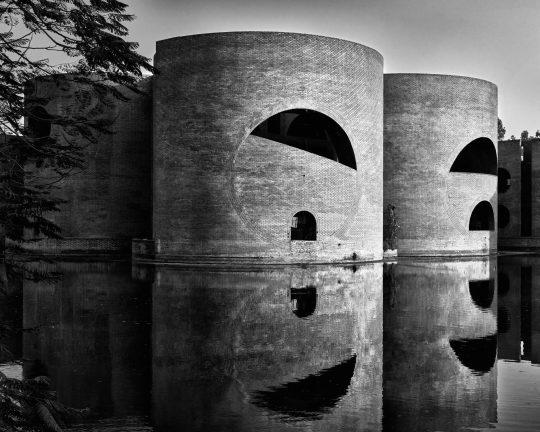
National Parliament Complex in Dhaka, Photo: Yes, Louis Kahn
SŠ: Transformation of Dhaka today is intensive. What would be some of the significant architectural achievements in contemporary Dhaka and Bangladesh?
Adnan Morshed: The architectural scene in Bangladesh has been thriving with a “new” energy over the past two decades or so. Bangladeshi architects have been experimenting with form, material, aesthetics, and, most importantly, the idea of how architecture relates to history, society, and the land. Their various experiments bring to the fore a collective feeling that something has been going on in this crowded South Asian country. One is not quite sure about what drives this restless energy! Is it the growing economy? The rise of a new middle class with deeper pockets? Is it an aesthetic expression of a society in transition? Is it aesthetics meeting the politics of development?
Whatever it is, an engaged observer may call this an open-ended search for some kind of “local” modernity. Bangladeshi architects have been winning architectural accolades from around the world for a variety of architectural projects. High-profile national architectural competitions have created a new type of design entrepreneurship, yielding intriguing edifices. Architects have also been expanding the notion of architectural practice by engaging with low-income communities and producing cost-effective shelters for the disenfranchised. Traditionally trained to design stand-alone buildings, architects seem increasingly concerned with the challenges of creating liveable cities.
No doubt it is an exciting time in Bangladesh, architecturally speaking, even if the roads in the country's big cities are paralysed by traffic congestion and a pervasive atmosphere of urban chaos. In the midst of infernal urbanisation across the country, an architectural culture has been taking roots with both promises and perils, introducing contentious debates about its origin, nature, and future.
Architecturally, the 1980s was an interesting time, as divergent ideas began to permeate architectural thinking in the country. Three stories should be mentioned. An “avant-garde” architectural study group named Chetona (meaning awareness) sought to introduce critical thinking as an essential part of architectural practice. Many architects, senior and junior— disillusioned with the prevalent role of architecture as primarily a professional practice without broader social visions and engagement with history and culture—gravitated toward Chetona, meeting at Muzharul Islam's architectural office, Bastukalabid, at Poribagh. The iconoclasm of the study group revolved around reading critical writings in architecture, criticism of current methods of architectural pedagogy, and reasoned questioning of architecture as a technical discipline. The group's reading list ranged from Rabindranath Tagore to the Franco-Swiss architect Le Corbusier to the Norwegian architectural theorist Christian Norberg-Schulz.
The influence of the Aga Khan Award for Architecture (AKAA), an architectural prize established by Aga Khan IV in 1977, was also felt strongly during the 1980s. The award sought to champion regional, place-based and culture-sensitive architectural impetuses in Islamic societies. Awardees included projects in contemporary design, social housing, community development, restoration, adaptive reuse, and landscape design. Architects were inspired to look for a “spirit of place.” Regionalism was in vogue.
The Aga Khan Award for Architecture's flagship magazine, Mimar: Architecture in Development, first published in 1981, influenced many Bangladeshi architects and architecture students in thinking beyond western modernism and the aesthetic conventions it allegedly created. At its inception, Mimar was the sole international architecture magazine focusing on architecture in the developing world. In many ways, the magazine's celebration of “local” expanded the scope of architectural practice in the country and gave rise to new aspirations among architects, who were willing to search for organic roots in architecture.
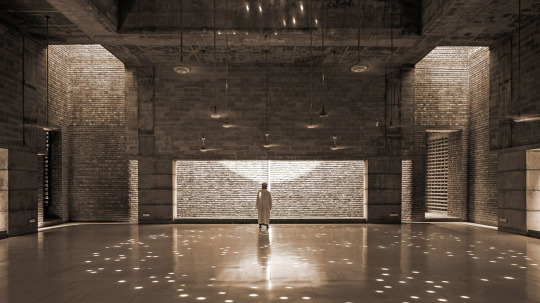
Bait Ur Rouf Mosque in Dhaka by Marina Tabassum, 2016 Aga Khan Award Recipient
The new architectural aspirations coincided with the rapid urbanisation of Bangladesh and the rise of an urban middle class that spawned a flourishing culture of architectural patronage. A historically agrarian country, Bangladesh began to urbanise rapidly from the late 1980s. The country's total urban population rose from a modest 7.7 percent in 1970 to 31.1 percent in 2010. Impoverished rural migrants began to flock to major cities, particularly the capital, Dhaka, in search of employment and better lives. Its population skyrocketed from 1.8 million in 1974 to more than 6 million in 1991 and to nearly 18 million today. The capital city's massive population boom created an unsustainable demand on urban land, and in return, land values increased.
During this transitional period, real estate developers emerged as powerful economic actors in Dhaka and beyond, playing a key role in replacing traditional single-family houses with multi-story apartment complexes. Meanwhile, public-sector housing failed to meet the demand, and in this vacuum, private real estate companies flourished rapidly. As private developers became key actors in the city's housing market, a trade association was needed to regulate the real estate sector and to ensure fair competition among its members. The stratospheric rise of private real-estate developers suggested that there was a robust market for high-density, multifamily apartments, even though affordability remained a major hurdle. Many architects experimented with material, form, spatial organisation, construction, aesthetic expression, and the individual plot's urban relationship to the neighbourhood.
A burgeoning class of urban entrepreneurs—who made their fortunes in the country's export-oriented ready-made garments industry, manufacturing and transportation sectors, construction industry, and consumer market—emerged as a new generation of architectural patrons, investing hefty amounts of money to build their signature single-family houses and other projects, including apartment complexes, hospitals, shopping malls, private schools and universities, factories, spaces of worship, etc.
And, happily, architects began to find work abundantly from the mid-1990s. Design consultancy until the early 1990s was limited to a handful of architectural firms. But soon thereafter new, smaller firms, run by younger architects, began to reshape the traditional methods of architectural design practice in the country.
The liberalisation of the market, the emergence of a strong private sector, and rapid urbanisation resulted in the need for a range of building typologies and related architectural design services. In the public sector, government organisations began to evaluate the social and commercial value of aesthetic expression and hired architectural firms to compete in the building market. All of these developments ushered in a vibrant and dynamic opportunity for architectural experiments. The last two decades in Bangladesh witnessed an intense battle of architectural ideas. The earlier attitudes to orthodox modernism or regionalism in architecture dispersed into a more nuanced landscape of aesthetic abstraction.
SŠ: „For most of modern history, cities grew out of wealth. Even in more recently developed countries, such as China and Korea, the flight towards cities has largely been in line with income growth. But recent decades have brought a global trend for “poor-country urbanisation”, in the words of Harvard University economist Edward Glaeser, with the proliferation of low-income megacities.“ Dhaka is an example of such a city that has outpaced develepoment and has grown tremendously. Can planned urbanisation even tackle such a huge task in given circumstaces?
Adnan Morshed: While architecture rose and prospered as individual plot-based or stand-alone practices, cities—Dhaka as a glaring example—as a whole descended into unbearable chaos. In extreme cases, Taj Mahals coexisted with overflowing dumpsters. Private oases and sumptuous cafes overlooked the ghettoised world of slums. While architects searched for Bengali roots and global gravitas in their work, they mostly failed to promote an “ethical” view of how city should function and treat all its citizens.
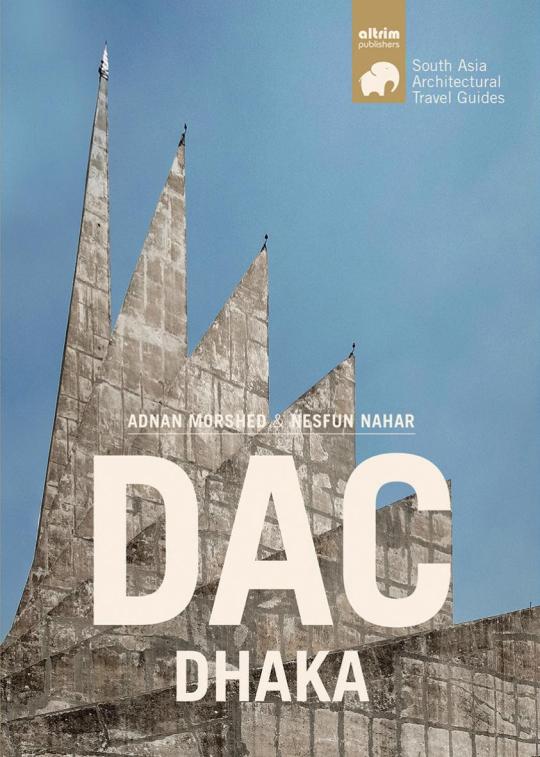

While globalisation went on with a cutthroat consumerist and neoliberal agenda, and architecture patronage benefitting from it, social inequality grew manifold. Architects seemed confused as to how architecture could or should also play mitigating roles in addressing the issues of social justice. Slums burned and architects rushed to the site with naïve, superficial aesthetic solutions without trying to understand the exploitative economic and political systems that blight society in the first place. The feeling that “architecture is great but the city rots” sometimes seems overwhelming.
Walking in some of Dhaka's walkable streets fronted with exclusive-looking buildings, an observer might wonder how architecture could showcase the rising stature of a developing country, while failing to play a role in making it socially just.
_
In Croatian: https://vizkultura.hr/intervju-adnan-morshed/
_
Projekt Motel Trogir u 2021. godini podržan je od Ministarstva kulture i medija Republike Hrvatske i Zaklade Kultura nova.


10 notes
·
View notes
Photo


Queen Noor Interview with Prestige issue 34, March 1996
Interviewed in Amman by CHRISTIANE Obeid | © Prestige / Bassam Lahoud
She captivates you with the strength of her charisma. Fascinates you by the scale of her projects. Meeting with Her Majesty in Jerash.
Amman Airport. Literally a welcoming committee, two people waiting, sent by the Royal Palace of Ma’wa, a third one by the Lebanese Embassy in Jordan. A first impression of Jordan: courtesy, discretion. Outside, the lights of a city that does not sleep. Alive. With white stone houses, architectural treasures. No skyscrapers but a latent desire for immensity. The next day, the same person, taciturn and kind, leads us to our first stop: Iraq Al Amir. An archaeological reconstructed village, restored, half an hour from Amman but already deeply immersed in tradition.
We have not yet met the Queen, but her work is marked everywhere. (Source)
Inside each house, a beehive of activity and a delicious freshness. Our mentor: Awni Quandour graduate of States and director of the center. Here, we weave with happiness, the millenary production of parchment paper is recovered…
Ramadan does not slow the activity of nawls under the impetus of the gay village girls. The presence of computers seems incongruous at first, but the tradition and modernity go together well. Our meeting with Jordan’s heritage extends to Jordan Design and Trade Center (JDTC). «Our goal is to continue to create, create every day, something different.» Statement of the director Claude Zumot, also a graduate in management from the States. And the designers of the Centre do not lack ideas. Originality of modern notes intended to complement the heritage of ancestors. Mosaic patterns on multiple works, delicately aesthetic convolutions of a glass, traced vows on Salsal ceramics. We learn, with difficulty, to recognize the different bsat and call them by name because they have a name like any piece of art. From the peasants of Iraq Al Amir to Husseiniyé Bedouins, Jordan awakes to crafts, culture. Who gave the impetus? A queen so dedicated to her work that she offered us, instead of a traditional interview, to accompany her to Jerash. Historic city that has a large craft center. Departure from the Royal Palace of Ma ‘awa, on the hill of Nuzha.
At Jerash, in groups in front and inside of the Town Hall, the crowd waiting for their queen, their benefactress. It is there, fascinated, that we understand the scale of the project, the strength of her charisma, the extent of her love for Jordan, her commitment to the people that came to pay tribute to her.
Majesty, you are an architect; what is the contribution of your major in the successful implementation of your projects? I chose a major in Architecture and Urban Planning at the University of Princeton because it included several disciplines that were later a great asset to my work in Jordan. I discovered that in order to build for an individual or a community, we should understand their physical, social and spiritual needs and try to find solutions to those needs. In a sense, you can say that my major at the university helped me to become a «social architect».
«The woman can become a real economical force in her own community».
What distinguishes the Jordanian crafts from other countries? Jordanian designs reflect the richness of our history and are inspired by many ancient and contemporary cultures that flourished in Jordan. For example, the Nabataeans were famous for their fine ceramics they exported across the East. We produce Nabataean pottery style craft at the center of Salt that can be sold to tourists today.
On the other hand, the Bedouin style is very special because it produces «smooth-faced» because dense carpet; their texture is different from other styles. Our designers have also introduced for carpets and ceramic patterns inspired from mosaics. Embroidery items are typically Jordanian, eg Ma’ani point that had almost disappeared until the day the JDTC incorporated it again in its products. Another practice been forgotten and that we have revived the wheat wicker baskets woven by hand. Better, we established at Mukhaibeh a profitable project for the work of wicker wheat, palm leaves and banana …. On the other hand, the foundation provided women with new looms and spinning wheels to increase productivity. We have imposed a strict quality control from raw material to final product.
What are the main lines of craft projects? I would mainly say weaving and embroidery and ceramics, gems and paper.
Is there a contribution of the younger generation of the royal family to the revival of heritage? Several young members of the family support national programs for the preservation and promotion of the Jordanian heritage especially in the Jerash festival for art and culture and the National Music conservatory and projects for the Environment.
Majesty, what is the contribution of craft centers for the protection of historical monuments? Over the past decade, I have encouraged the development of these highly skilled centers in Jordan historic towns of archaeological sites to promote handicrafts and integrate the socio-economic development to tourism. In Iraq Al Amir you visited yesterday, a site dating from BC 2nd century, the Noor Al Hussein Foundation has renovated two farms and began the restoration of ten others. She plans to turn these farms in a craft village that preserve the cultural heritage of the region and would be linked to Hellenistic palace, which will encourage tourism and increase the economic benefit of the community. The foundation aims primarily to improve the quality of life of rural and urban poor communities through Jordan establishing intensive programs in the context of health, education, heritage, environment, volunteering and community involvement. I also encouraged the restoration of historic villages nearby archaeological sites such as Taybat Zaman, ten minutes from Petra. The Foundation and the Ministry of Tourism are working together for the upgrading of craft shops and tourist information centers.
As part of the craft revival, how do you assess environmental issues and what are your achievements in this area? I already mentioned the Mukhaibeh braiding project that symbolizes the effort deployed by the Foundation for integrating environmental issues into development projects. Before the Foundation initiated the project, the farmers there cut down and uprooted their palms, exploring other cultures. We have created a demand and as a result, farmers planted more palm trees! On the other hand, the JDTC working on water recycling project to reuse the water in the wool processing centers and dyeing south of Jordan. The JDTC also initiated profitable projects to the Dana Nature Reserve, in an abandoned village in the south. The historic stone houses have been restored and activities implemented. Currently the JDTC sells jewelry made in Dana, from semi-precious stones in the region.
Have most of the artistic and cultural projects been realized? Has the Foundation Noor AL Hussein realized its initial aspirations? Yes, the cultural activity of the Foundation is in full swing. Just after my marriage, I started with the invaluable help of Jordanian volunteers, the first Jerash Festival, today internationally recognized as a crossroads exchanges which contributed to the rebirth and revitalization of the cultural and artistic heritage. I also began during the early years of my marriage the Arab Children’s Congress, which brings together children from all parts of the Arab world in a climate of understanding, tolerance and solidarity. The National Conservatory of Music “founded in 1986, is the only one to have a children orchestra. Its annual program includes concerts, workshops and conferences as well as recitals that feature local and international musicians. Development project of the National Handicrafts, the JDTC and training center in Salt are three programs of the Noor Al Hussein Foundation. They were able to stimulate the revival of the craft heritage. Another project affiliated with the Foundation: the first Museum of Science for children, which helps them understand the ecological and scientific cycles of life. Children can touch and handle the exhibits to learn more on the development of Man through the ages, the natural history, geography, science, the environment, space and cultures in the world. We have also set up a museum of science, mobile, for children in rural areas. It focuses on health and hygiene, Science and Environmental Protection and the History of Jordan.
Your Majesty was there a few months ago at an international conference in Paris. How does the Foundation works as an intermediary between international and Jordanian institutions? We are associated with many UN and other organizations in the fields of education, the development of women and the community, the health, well-being of children, culture and heritage. The Foundation works with 30 different national and international non-governmental organizations to help them develop their plans, assist in attracting international funds and put their products on the market, especially abroad. Any foreign funding received by the Foundation is paid to the organization to which this fund is for.
At international carpet competition, a Jordanian rug Hweitat won first prize
Does the JDTC take part in major international exhibitions? Yes, the JDTC has exhibited its products in Europe, Paris and Frankfurt, and exposes once a year in Atlanta where one Hweitat rug has won the first prize at the International rug Competition. And twice a year in High Point, North Carolina, the largest furniture and decoration market of the United States.
Will handicraft be able one day to become a self-sufficient industry that will promote Jordanian art in the world? Craft centers are already self-sufficient. In addition, through its international exhibitions and marketing, JDTC has already introduced the Jordanian crafts in the world. The JDTC is primarily a national design and trade center that is not charged solely to promote the foundation products but also the works of various craft projects throughout the country.
Who oversees these centers? What is the common denominator? Is there not a danger of competition between different centers? Jordan is fortunate to have a wide variety of public and private craft centers with which JDTC works closely, either from a training perspective and product development or local or international marketing. The JDTC deploys every effort to reserve the rights to create products and designs to protect artisans. As for the craft centers of the Foundation, all of their directors are men or women from the same region, that the JDTC has recruited and trained to manage these centers. Those tend to specialize in different product lines at a time when the JDTC is creating «model centers».
To be engaged, should women initially have some skill? How the proposed development of the woman makes her a decision-maker? If a woman already has skills, it is more an asset but it is not a prerequisite for recruitment. The most important quality is the commitment, motivation. In addition, JDTC provides the necessary training, technical or managerial, and in that sense, the approach of the Foundation differs from the traditional and often ineffective approach, which merely provides material assistance to women.
The introduction of cost-effective programs, geared toward local and international markets, allows women to become a real economic force in the community. Her status and influence increase as well as the overall quality of life of the community, because a woman will often communicate her knowledge to her family. The training of women is therefore the fastest way to achieve positive change in development.
How are workers paid? Most artisans are paid according to the piece they realized, weavers are paid by meter and embroiderers per piece. As for center directors and some workers, they receive a monthly salary.
Which project of JDTC won the most of success? The projects of Nurha and Rimoun employing between 150 and 200 people are probably the most successful because both are completely independent. The JDTC initiated projects from scratch, providing all the training.
At present, the centers are self-managed and operated. Nurha, an embroidery center, has three other centers under its supervision. As the center of Rùnoun, it was established by the JDTC to help these women to acquire the skills and improve their standard of living while revitalizing the Jordanian crafts. The JDTC has also introduced an innovation: a 2 meters long loom which produces carpets covering a room previously almost non-existent in the Jordanian market.
How many people work at JDTC? Since its founding in 1990, 3,000 women and their families have benefited.
Do you have a special program for young people even not gifted in rural areas? Is university free of charge in Jordan? University is not free in Jordan, but the school is free up to college. The project that is particularly dear to me is the Jubilee School, high school for scholars from all parts of the country, particularly disadvantaged. It is dedicated to the development of intellectual potential of Jordanian students by providing a unique study method and curriculum based on their own needs, abilities and experiences. This school, in collaboration with private and public institutions, sponsors several courses and workshops for teachers and students throughout the country. Another project I have already mentioned is that of Salt which offers free training for three years in weaving, pottery and ceramics production, silk weaving, decoration and refresher courses for trainers. On the other hand, the SOS homes for boys and girls offer Vocation courses for children and, in collaboration with the SOS villages in Amman and Aqaba, creating a warm family atmosphere for orphans and abandoned children.
«My studies at Princeton University helped me to become a social architect»
Regarding the educational projects for children in rural areas, in addition to the mobile museum that I have already mentioned, the Foundation works closely in partnership with local authorities and private voluntary groups to establish clubs for children across Jordan. They meet the recreational, cultural, artistic needs of the younger. The Foundation also supports the creation of child care centers and nursery in the villages where these «quality of life» projects are implemented.
Majesty, your dream is the children’s hospital. What steps have been taken for its realization? The National Hospital for Children is a project that the people of Jordan have long dreamed of. Once completed, we hope that this hospital will be the first of the Kingdom to provide for tertiary medical care, secondary and some primary care for children aged 0 to 16 years. This establishment will be accessible to all economic classes of the population. The hospital will not only be a pediatric center but also an educational center for pediatric, surgical, dental hygiene and combined scientific disciplines. It will also include a center for the evaluation of child development and treatment of cerebral palsy and also present an extensive program guide for the family. The Institute for Health and Child Development is the first and only local specialized in assessing and monitoring the growth and development of the child. It will be affiliated with the hospital and serve the local community.
Majesty, you like to photograph. Have you organized an exhibition of your work? Unfortunately not, but this is a project that deserves reflection!
9 notes
·
View notes
Text
Pluralistic, your daily link-dose: 28 Feb 2020

Today's links
Clearview AI's customer database leaks: Sic semper grifter.
The Internet of Anal Things: Recreating Stelarc's "Amplified Body" with an IoT butt-plug.
Oakland's vintage Space Burger/Giant Burger building needs a home! Adopt a googie today.
Fan-made reproduction of the Tower of Terror: Even has a deepfaked Serling.
Drawing the Simpsons with pure CSS: Impractical, but so impressive.
Let's Encrypt issues its billionth cert: 89% of the web is now encrypted.
AI Dungeon Master: A work in progress, for sure.
How to lie with (coronavirus) maps: Lies, damned lies, and epidemiological data-visualizations.
This day in history: 2019, 2015
Colophon: Recent publications, current writing projects, upcoming appearances, current reading

Clearview AI's customer database leaks (permalink)
Clearview is the grifty facial recognition startup that created a database by scraping social media and now offers cops secretive deals on its semi-magic, never-peer-reviewed technology. The company became notorious in January after the NYT did a deep dive into its secretive deals and its weird, Trump-adjascent ex-male-model founder.
(the Times piece was superbly researched but terribly credulous about Clearview's marketing claims)
https://www.nytimes.com/2020/01/18/technology/clearview-privacy-facial-recognition.html
Yesterday, Clearview warned its customers that it had been hacked and lost its customer database. Today, that customer database was published.
https://www.buzzfeednews.com/article/ryanmac/clearview-ai-fbi-ice-global-law-enforcement
It seems that the NYT weren't the only ones to take Clearview's marketing claims at face value. Its client list includes the DoJ, ICE, Macy's, Walmart, and the NBA. All in all the dump includes more than 2,200 users, including "law enforcement agencies, companies, and individuals around the world."
Included: state AGs, university rent-a-cops, and clients in Saudi Arabia.
"BuzzFeed News authenticated the logs, which list about 2,900 institutions and include details such as the number of log-ins, the number of searches, and the date of the last search."
What does Clearview, a sercurity company, say about this ghastly security breach? "Unfortunately, data breaches are part of life in the 21st century."
Big shrug energy.
"Government agents should not be running our faces against a shadily assembled database of billions of our photos in secret and with no safeguards against abuse," ACLU attorney Nathan Freed Wessler, said to BuzzFeed News.
It is amazing that this needs to be said.
"More than 50 educational institutions across 24 states named in the log. Among them are two high schools."
They are:
Central Montco Technical High School in Pennsylvania
Somerset Berkley Regional High School in Massachusetts
The log also has an entry for Interpol.
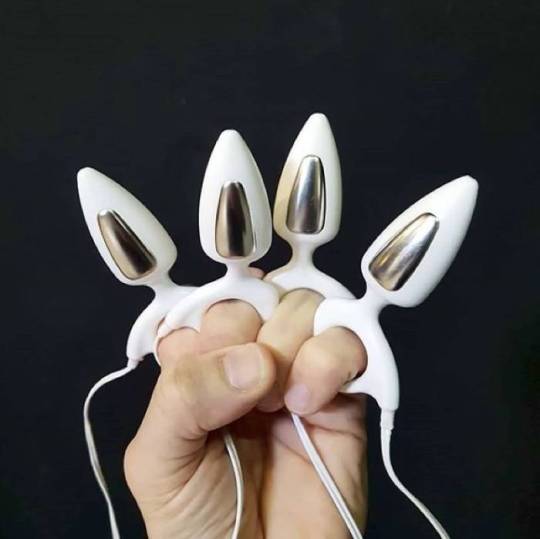
The Internet of Anal Things (permalink)
In 1994, the notorious/celebrated electronic artist Stelarc did a performance called "Amplified Body" in which he "controlled robots, cameras and other instruments by tensing and releasing his muscles"
https://web.archive.org/web/20120712181429/https://v2.nl/events/amplified-body
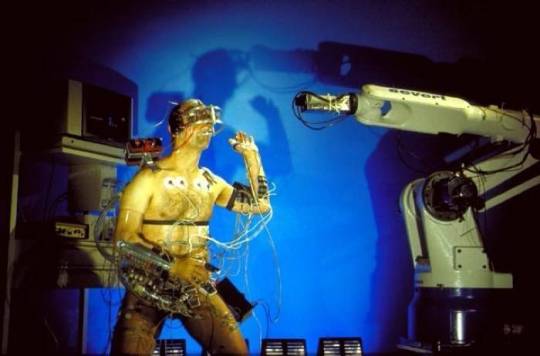
Now, artist/critic Dani Ploeger has revisited Amplified Body with his own performance, which is very similar to Stelarc's, except all the peripherals are controlled by Ploeger tensing and releasing his anal sphincters around a smart butt-plug.
https://www.daniploeger.org/amplified-body
He calls it "B-hind" and it's a ha-ha-only-serious. The buttplug is "an anal electrode with EMG sensor for domestic treatment of faecal incontinence," and the accompanying text is a kind of art-speak parody of IoT biz-speak.
https://we-make-money-not-art.com/b-hind-celebrating-the-internet-of-anal-things
"B-hind offers a unique IoT solution to fully integrate your sphincter muscle in everyday living. The revolutionary anal electrode-powered interface system replaces conventional hand/voice-based interaction, enabling advanced digital control rooted in your body's interior. Celebrating the abject and the grotesque, B‒hind facilitates simple, plug-and-play access to a holistic body experience in the age of networked society."
B-hind was produced in collaboration with V2_, the Lab for the Unstable Media in Rotterdam, and In4Art.
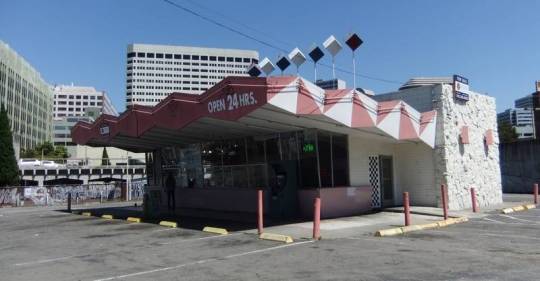
Oakland's vintage Space Burger/Giant Burger building needs a home! (permalink)
Giant Burger was once an East Bay institution, known for its burgers and its gorgeous googie architecture.
https://localwiki.org/oakland/Giant_Burger
One of the very last Giant Burger buildings is now under threat. Though the Telegraph Ave location was rescued in 2015 and converted to a "Space Burger," it's now seeking a new home because it is in the path of the Eastline project.
https://insidescoopsf.sfgate.com/blog/2015/02/24/space-burger-launches-in-uptown-oakland/
The Oakland Heritage Alliance is hoping someone will rescue and move the building: " Do you have an idea for a new location for this mid-century icon? Please contact [email protected] if you know of an appropriate lot, project, or site, preferably downtown."
(Image CC BY-SA, Our Oakland)

Fan-made reproduction of the Tower of Terror (permalink)
Orangele set out to re-create the Walt Disney World Twilight Zone Tower of Terror elevator loading zone in the entry area to their home theater. He's not only done an impressive re-make of the set, but he's also augmented it with FANTASTIC gimmicks.
https://www.hometheaterforum.com/community/threads/the-tower-of-terror-theater.365747/
It's not merely that's he's created a rain, thunder and lightning effect outside the patio doors…
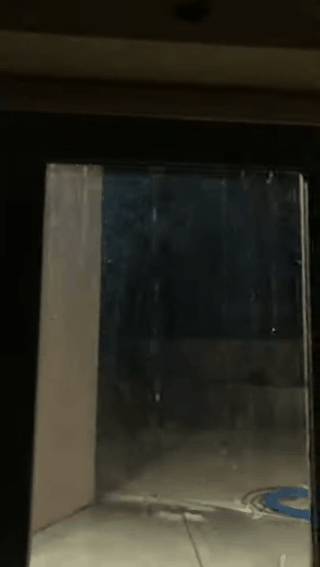
https://www.youtube.com/watch?v=4QMzN0v4mJQ
Nor has he merely created props like this gimmicked side table that flips over at the press of a button.
https://www.youtube.com/watch?v=kY7gQLMnbeA

He's also created HIS OWN ROD SERLING DEEPFAKE.
https://www.youtube.com/watch?time_continue=2&v=MIsjYJwOXSU
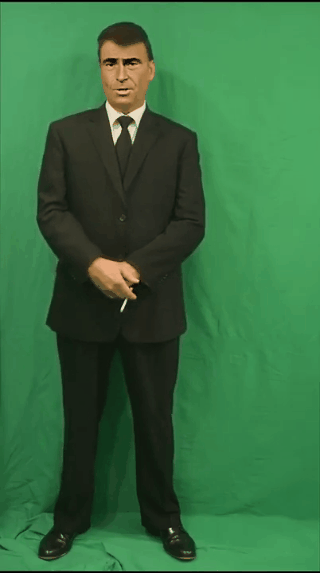
I kinda seriously love that he left Rod's cigarette in. The Disney version looks…uncanny.
Not shown: "exploding fuse box with simulated smoke and fire, motorized lighted elevator dial, motorized/lighted pressure gauge, video monitor playing Tower of Terror ride sequence seen through the elevator door wrap, motorized "elevator door'"
He notes, "I was once married, but now as a single person, I can do whatever I want, haha. NEVER getting married again."
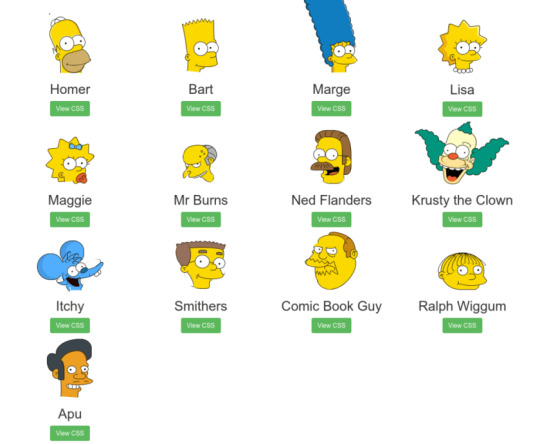
Drawing the Simpsons with pure CSS (permalink)
Implementing animated Simpsons illustrations in CSS isn't the most practical web-coding demo I've seen, but it's among the most impressive. Bravo, Chris Pattle!
(not shown: the eyes animate and blink!)
https://pattle.github.io/simpsons-in-css/
#bart .head .hair1 { top: 22px; left: 0px; width: 6px; height: 7px; -webkit-transform: rotate(-22deg) skew(-7deg, 51deg); -ms-transform: rotate(-22deg) skew(-7deg, 51deg); transform: rotate(-22deg) skew(-7deg, 51deg); }
I especially love the quick-reference buttons to see the raw CSS. It reminds me of nothing so much as the incredibly complex Logo programs I used to write on my Apple ][+ in the 1980s, drawing very complicated, vector-based sprites and glyphs.
https://github.com/pattle/simpsons-in-css/blob/master/css/bart.css
Most interesting is the way that this modular approach to graphics allows for this kind of simple, in-browser transformation.


Let's Encrypt issues its billionth cert (permalink)
When the AT&T whistleblower Mark Klein walked into EFF's offices in 2005 to reveal that his employers had ordered him to help the NSA spy on the entire internet, it was a bombshell.
https://www.eff.org/tags/mark-klein
The Snowden papers revealed the scope of the surveillance in fine and alarming detail. According to his memoir, Snowden was motivated to blow the whistle when he witnessed then-NSA Director James Clapper lie to Senator Ron Wyden about the Klein matter.
Since that day in 2005, privacy advocates have been fretting about just how EASY it was to spy on the whole internet. So much of that was down to the fact that the net wasn't encrypted by default.
This was especially keen for @EFF. After all, we made our bones by suing the NSA in the 90s and winning the right for civilians to access working cryptography (we did it by establishing that "Code is speech" for the purposes of the First Amendment).
https://www.eff.org/deeplinks/2015/04/remembering-case-established-code-speech
Crypto had been legal since 1992, but by Klein's 2005 disclosures, it was still a rarity. 8 years later — at the Snowden moment — the web was STILL mostly plaintext. How could we encrypt the web to save it from mass surveillance?
So in 2014, we joined forces with Mozilla, the University of Michigan and Akamai to create Let's Encrypt, a project to give anyone and everyone free TLS certificates, the key component needed to encrypt the requests your web-server exchanges with your readers.
https://en.wikipedia.org/wiki/Let%27s_Encrypt
Encrypting the web was an uphill climb: by 2017, Let's Encrypt had issued 100m certificates, tipping the web over so that the majority of traffic (58%) was encrypted. Today, Let's Encrypt has issued ONE BILLION certs, and 81% of pageloads use HTTPS (in the USA, it's 91%)! This is astonishing, bordering on miraculous. If this had been the situation back in 2005, there would have been no NSA mass surveillance.
Even more astonishing: there are only 11 full-timers on the Let's Encrypt team, plus a few outside contractors and part-timers. A group of people who could fit in a minibus managed to encrypt virtually the entire internet.
https://letsencrypt.org/2020/02/27/one-billion-certs.html
There are lots of reasons to factor technology (and technologists) in any plan for social change, but this illustrates one of the primary tactical considerations. "Architecture is Politics" (as Mitch Kapor said when he co-founded EFF), and the architectural choices that small groups of skilled people make can reach all the way around the world.
This kind of breathtaking power is what inspires so many people to become technologists: the force-multiplier effect of networked code can imbue your work with global salience (for good or ill). It's why we should be so glad of the burgeoning tech and ethics movement, from Tech Won't Build It to the Googler Uprising. And it's especially why we should be excited about the proliferation of open syllabi for teaching tech and ethics.
https://docs.google.com/spreadsheets/d/1jWIrA8jHz5fYAW4h9CkUD8gKS5V98PDJDymRf8d9vKI/edit#gid=0
It's also the reason I'm so humbled and thrilled when I hear from technologists that their path into the field started with my novel Little Brother, whose message isn't "Tech is terrible," but, "This will all be so great, if we don't screw it up."
https://craphound.com/littlebrother
(and I should probably mention here that the third Little Brother book, Attack Surface, comes out in October and explicitly wrestles with the question of ethics, agency, and allyship in tech).
https://us.macmillan.com/books/9781250757531
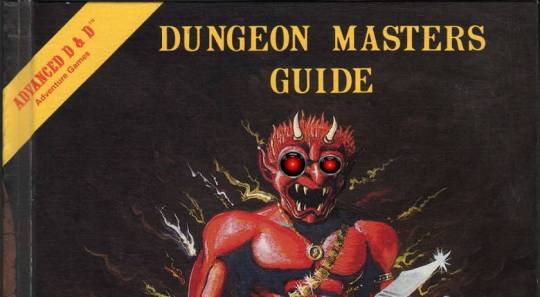
AI Dungeon Master (permalink)
Since 2018, Lara martin has been using machine learning to augment the job of the Dungeon Master, with the goal of someday building a fully autonomous, robotic DM.
https://laramartin.net/
AI Dungeon Master is a blend of ML techniques and "old-fashioned rule-based features" to create a centaur DM that augments a human DM's imagination with the power of ML, natural language processing, and related techniques.
She's co-author of a new paper about the effort, "Story Realization: Expanding Plot Events into Sentences" which "describes a way algorithms to use "events," consisting of a subject, verb, object, and other elements, to make a coherent narrative."
https://aaai.org/Papers/AAAI/2020GB/AAAI-AmmanabroluP.6647.pdf
The system uses training data (plots from Doctor Who, Futurama, and X-Files) to expand text-snippets into plotlines that continue the action. It's a bit of a dancing bear, though, an impressive achievement that's not quite ready for primetime ("We're nowhere close to this being a reality yet").
https://www.wired.com/story/forget-chess-real-challenge-teaching-ai-play-dandd/
This may bring to mind AI Dungeon, the viral GPT-2-generated dungeon crawler from December.
https://aidungeon.io/
As Will Knight writes, "Playing AI Dungeon often feels more like a maddening improv session than a text adventure."
Knight proposes that "AI DM" might be the next big symbolic challenge for machine learning, the 2020s equivalent to "AI Go player" or "AI chess master."

How to lie with (coronavirus) maps (permalink)
The media around the coronavirus outbreak is like a masterclass in the classic "How to Lie With Maps."
https://www.press.uchicago.edu/ucp/books/book/chicago/H/bo27400568.html
Self-described "cartonerd" Kenneth Field's prescriptions for mapmakers wanting to illustrate the spread of coronavirus is a superb read about data visualization, responsibility, and clarity.
https://www.esri.com/arcgis-blog/products/product/mapping/mapping-coronavirus-responsibly/
Both of these images are representing the same data. Look at the map and you might get the impression that coronavirus infections are at high levels across all of China's provinces. Look at the bar-chart and you'll see that it's almost entire Hubei.

Here's a proposed way to represent the same data on a map without misleading people.

Another point that jumped out: stop coloring maps in red!
"We're mapping a human health tragedy that may get way worse before it subsides. Do we really want the map to be screaming bright red? Red can connotate death, still statistically extremely rare for coronavirus."
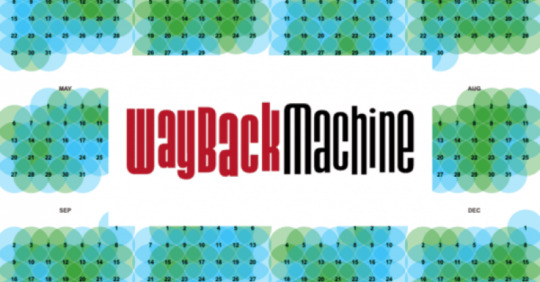
This day in history (permalink)
#5yrsago Ad-hoc museums of a failing utopia: photos of Soviet shop-windows https://boingboing.net/2015/02/28/ad-hoc-museums-of-a-failing-ut.html
#5yrsago First-hand reports of torture from Homan Square, Chicago PD's "black site" https://www.theguardian.com/us-news/2015/feb/27/chicago-abusive-confinment-homan-square
#1yrago EFF's roadmap for a 21st Century antitrust doctrine https://www.eff.org/deeplinks/2019/02/antitrust-enforcement-needs-evolve-21st-century
#1yrago Yet another study shows that the most effective "anti-piracy" strategy is good products at a fair price https://www.vice.com/en_us/article/3kg7pv/studies-keep-showing-that-the-best-way-to-stop-piracy-is-to-offer-cheaper-better-alternatives
#1yrago London's awful estate agents are cratering, warning of a "prolonged downturn" in the housing market https://www.bbc.com/news/business-47389160
#1yrago Bad security design made it easy to spy on video from Ring doorbells and insert fake video into their feeds https://web.archive.org/web/20190411195308/https://dojo.bullguard.com/dojo-by-bullguard/blog/ring/
#1yrago Amazon killed Seattle's homelessness-relief tax by threatening not to move into a massive new building, then they canceled the move anyway https://www.seattletimes.com/business/amazon/huge-downtown-seattle-office-space-that-amazon-had-leased-is-reportedly-put-on-market/
#1yrago The "Reputation Management" industry continues to depend on forged legal documents https://www.techdirt.com/articles/20190216/15544941616/pissed-consumer-exposes-new-york-luxury-car-dealers-use-bogus-notarized-letters-to-remove-critical-reviews.shtml

Colophon (permalink)
Today's top sources: Allegra of Oakland Heritage Alliance, Waxy (https://waxy.org/), We Make Money Not Art (https://we-make-money-not-art.com/), Sam Posten (https://twitter.com/Navesink), Slashdot (https://slashdot.org), Kottke (https://kottke.org) and Four Short Links (https://www.oreilly.com/feed/four-short-links).
Hugo nominators! My story "Unauthorized Bread" is eligible in the Novella category and you can read it free on Ars Technica: https://arstechnica.com/gaming/2020/01/unauthorized-bread-a-near-future-tale-of-refugees-and-sinister-iot-appliances/
Upcoming appearances:
Canada Reads Kelowna: March 5, 6PM, Kelowna Library, 1380 Ellis Street, with CBC's Sarah Penton https://www.eventbrite.ca/e/cbc-radio-presents-in-conversation-with-cory-doctorow-tickets-96154415445
Currently writing: I just finished a short story, "The Canadian Miracle," for MIT Tech Review. It's a story set in the world of my next novel, "The Lost Cause," a post-GND novel about truth and reconciliation. I'm getting geared up to start work on the novel now, though the timing is going to depend on another pending commission (I've been solicited by an NGO) to write a short story set in the world's prehistory.
Currently reading: Just started Lauren Beukes's forthcoming Afterland: it's Y the Last Man plus plus, and two chapters in, it's amazeballs. Last week, I finished Andrea Bernstein's "American Oligarchs" this week; it's a magnificent history of the Kushner and Trump families, showing how they cheated, stole and lied their way into power. I'm getting really into Anna Weiner's memoir about tech, "Uncanny Valley." I just loaded Matt Stoller's "Goliath" onto my underwater MP3 player and I'm listening to it as I swim laps.
Latest podcast: Gopher: When Adversarial Interoperability Burrowed Under the Gatekeepers' Fortresses: https://craphound.com/podcast/2020/02/24/gopher-when-adversarial-interoperability-burrowed-under-the-gatekeepers-fortresses/
Upcoming books: "Poesy the Monster Slayer" (Jul 2020), a picture book about monsters, bedtime, gender, and kicking ass. Pre-order here: https://us.macmillan.com/books/9781626723627?utm_source=socialmedia&utm_medium=socialpost&utm_term=na-poesycorypreorder&utm_content=na-preorder-buynow&utm_campaign=9781626723627
(we're having a launch for it in Burbank on July 11 at Dark Delicacies and you can get me AND Poesy to sign it and Dark Del will ship it to the monster kids in your life in time for the release date).
"Attack Surface": The third Little Brother book, Oct 20, 2020.
"Little Brother/Homeland": A reissue omnibus edition with a very special, s00per s33kr1t intro.
7 notes
·
View notes
Text
claws my way out of the dirt like the goblin i am ..... hello thots, its nora, once again bringing you a revamped version of a muse i played yonks ago n some of u may have even written against... here is her pinterest.....

this is margaret greta, she’s a whole can of trauma spaghetti plastered over with a toothy grin and a lot of dad jokes. the only reason she’s in gifford really is bcos shes been put there as part of a witness protection program cos lots of police r monitoring livingstone so its deemed relatively safe.... haha... anyway she changes major all the time. she started off doing fine art but since then she’s done modules in architecture, film, bio-chemistry and is now dabbling in medicine.
CIS-FEMALE — ever hear people say GRETA O’DRISCOLL looks a lot like DIANA SILVERS? I think SHE is about 21, so it doesn’t really work. The MEDICINE major is a SOPHOMORE that is from DEADWOOD, SOUTH DAKOTA. They can be +CHARMING, but they can also be -EVASIVE. I think GEE might be SHEEP. They are living in YATES. ( nora. 23. gmt. she/her )
this bitch is the most restless creature u ever seen. before she came to livingstone, she’d lived in 8 different cities in 3 years.
was adopted as an infant. had two foster moms and two older sisters so always surrounded by women. lived in a boarding house, very much like the one in 20th century women, with lodgers coming in and out all the time, mostly artsy young women because her gay moms were both high school teachers trying to set up their own arts collective. one of her moms left when she was 4, n she doesn’t really remember her.
while living with entirely women made her super into catlin moran and the guilty feminist, as a teenager she often let boys walk all over her bc she just craved male attention jst bcos she’d never really experienced it. saw it as something aspirational, like sitting in the back of chad’s second-hand truck while he drove you to macdonalds and offered you and his five friends with identical haircuts weed was the height of being cool to greta, she wanted to be their dream girl, even if it meant compromising her beliefs
bubbly bitch but also massive snake. metaphorically and literally, always shedding her skin. loyal to few, ruled by none, out for herself, babey!! every place she goes, she becomes a new character, someone who’s a figment of her imagination, as if each city is repertory theatre and she’s a character actress, so as a result som ppl think she’s called rita, some ppl know her as margot, she just flicks through identities like nobodies business.
goes through phases of being intensely feminist and tweeting “men are trash i don’t need them” before flipping into being lonely and needy n wanting male attention again. tends to gravitate towards men who are just pieces of shit tbh like her friends are always like hun.... pick a nice boy..... but no.... she’ll go for the boxer with several arrest records for gbh or the small-town drug dealer just trying to hook her onto pills for a little extra cash, or the reformed sinner who thinks he’s being protective by reading all her texts and always knowing where she is..... n she always finds a way to spin it so that they Just Care About Her and aren’t a p.o.s
left school at 18 n didn’t go to uni, moved in w her boyfriend of the time instead, but soon got bored, n then went backpacking around the states making money in the casinos by being a shot girl (yeehaw) and trying to make it as a mysterious 1920s widow with a smoky voice, a dark secret n a heart of gold, looking for love in the big city. all she found was producers and acting agents who’d promise her stardom n actually just fuck her in a motel n then ignore her calls.
TW domestic violence, TW gun, her watershed moment came when she met luke in sioux falls while she was playing bass for a country n blues band. he was a few years older and had a car, and they kind of went from seeing each other to being that super intense couple who are just necking all the time.
they got engaged like 3 months after they met n rented a flat together, much to her family’s annoyance but she was 19 so there wasn’t much they could do. their relationship was super super intense though, often really heightened and when they fought it could become quite violent, but she’d pass it off as just him being really passionate.
one of their fights got really heated and greta threatened him with the gun he kept in the glove box of his vauxhall corsa, but the safety was off and she accidentally shot him. she pleaded self defence in the trial n cos of the amount of times she’d been hospitalised for various concussions n things like ‘fallling down the stairs’ the police were like yea... pretty watertight evidence that he was a bastard who [chicago voice] had it coming..... also this happened in 2017, he was mixed race and greta is white so naturally the police totally took her side. she’s now under witness protection, rehoused in livingstone as a sports-scholarship student, due to the amount of police involvement in the area, it would mean should one of luke’s family members try to track her down, she’d be relatively safe
massive sports fanatic. plays tennis. on the cheer team. was a track superstar in her high school. honestly just that sporty bitch, you’ll see her doing lines at a party at half four and then on your way to your 9am lecture you see her running across the park like a fresh fucking daisy who is this bitch
pretty easy to get along with (provided you don’t anger, provoke or question her too much) because she WANTS your character to be enthralled by her and will do whatever it takes to win them over. she wants everyone to love her
is That Girl who always knows where the parties are, and is always there, on the sofa, talking about institutionalised racism and trying to coerce you into a game of beer pong that she’ll definitely win. doesn’t really have one solid group of friends, just kind of on good terms with everyone and social butterflies about
has changed her major so many times. decision? who is she. currently studying medicine, but doesn’t rlly enjoy it. she’s very unmotivated and lazy and probably wouldn’t ahve bothered going to uni if she hadn’t been placed in one by a witness protection program. will probably change on to history or gender studies soon n just make up the extra credits by volunteering
massive feminist. low key quite scared of powerful men bcos of her ex. wants to start a female only lesbian commune bc she misses her childhood in a south dakota boarding house and has endless support for women. honestly annoyed that she is attracted to men, would so be 100% gay if it was a choice. cuffs her jeans and can’t drive. is That bisexual. skateboards. wears backwards caps. i hate her
plays bass guitar, has a teal green fender and it is her BABY. it’s covered in stickers about saving the planet and ending fracking and going vegan. she’s in an all-female punk band w agnes (n mayb jade i think) n they play gigs every now n then in grotty club basements full of druggy sweaty college kids
PERSONALITY: easy-going, sociable, observant, blunt, amiable, nihilistic, self-serving, laid back, independent, unmotivated, charming, lazy, impulsive, alluring. ESTP and a leo
LIKES: art, music, john wayne movies, black mirror, philosophy, cowboy chic culture, DC comics, arcade games, candyfloss, deep red lipstick, marijuana, dogs, karaoke, Kate Moss, late-night strolls, zip-lining, chemistry, suspenders, cigarettes, herbal tea, gallows humour, cold coffee, long showers, brown eyes, tchaikovsky, dr. seuss, boiler house DJ sets, magnolias, decorative lamps, worn-out furniture, twangy electric guitars.
DISLIKES: bananas, coffee, Woody Allen, mental mathematics, children, Trump, institutionalised misogyny, the imaginary future, french literature, Wes Anderson films, spoken word poetry, the general mentality of cheerleading squads (despite being on one)
aesthetics:
a bubble of pink gum on chapped lips, mom jeans, a beaten up pair of adidas, denim jackets, strawberry laces, knee-highs, chapped lips, peeling sticky plasters, split knuckles, bruises you try to cover with concealer, stick and poke tattoos, hot coffee, sleep caught in your eyes on a lazy afternoon, kissing girls, cigarette smoke shrouding you like a veil, alien conspiracy theories and sci-fi paperbacks, doc martens with fraying laces, the red string of a thong peaking out purposely from jeans, leonine arch of your back and that stellar smile that says ‘you have no idea who you’re dealing with’, a rucksack permanently packed for the move, a streak of red across your lips, roller blades, cut knees, not eating your greens, smiling with a mouthful of blood, and piercing your own ears with a safety pin when your mom wouldn’t take you, kate moss posters lining the walls of a teenage bedroom, his name scrawled in rage across the pages of a diary, thumb holes poked through the cuffs of your sleeves, a tennis racket you punched through in a fit of temper, feet pounding the earth until your soles bleed crimson, sleeping in a cherry lip balm and scrunchies to keep the wild locks from your eyes.
wanted plots: since greta literally can’t differentiate between romantic and platonic love, she’s got off with so many of her mates, so i want awkward friendships where they nearly dated, or exes that have now just turned into weird friendships, and girls from the cheer team who she’s like, weirdly intimate with like the shower together but its not a Thing cos the other girls straight, and I want like, fellow medicine students who are like?? how is this bitch still passing?? i swear she goes out every night?? she works part time at a fast food restaurant, i want a mate that just goes and sits in there talking to her until her manager gets angry. ppl she did a few modules with before changing course and somehow sort of remaining in touch with, like she did a few art modules, a bit of film, n some architecture before switching to medicine, though she’ll probs switch course again soon. ppl who she runs track with. someone she’s trying to make a zine with. here’s a list of plots on her old blog if u want any of them w her.
would love plots of any type, throw them all at me please, i cnt wait to interact w all of u. like this if u want me to message you about connections / plots! xo
full biography if u can be bothered
trigger warnings: drugs, domestic abuse, gun.
you never meant for it to happen. you’d heard the stories, of girls who let their man walk all over them, and thought to yourself “i’ll never be one of those girls…” the kind that eat low-fat yoghurt and drink slim fast to shred a few extra pounds because he said she was getting round in the tummy, or the ones who spent their evenings tied to a kitchen sink drinking wine while him and the boys played poker, wishing god, if only I could get out of here. not you, not you raised by strong women, four bright shining beacons. single mother with her hard-as-nails attitude and her stony glares, elder sisters (twins) one ginger, one blonde, one doctor, one lawyer, both determined to take a bullet to the brain and a hammer to the patriarchy before they let a man touch them without asking. you were always so inferior, so insecure and small, like a bird (like a sparrow) with blonde plaits down your back sucking tropicana whilst your busom buds sucked dick, their lips permanently ripe with stories of their sexual exploits, fake tan and glittered nails whilst you sat in the unbroken egg of virginity wondering what it was like to be loved. one day you found out.
lily milligan’s parents gone and a free house for the night, bottles of ouzo and tequila swiped from your mother’s liquor cabinet thinking she wouldn’t know (she always knew) your legs, hardened from pep squad, slut dropping on a kitchen table because the boys thought it would be fun to get the quiet girl drunk. you’d never had a sip before that night. band t-shirts, denim shorts and the split soles of rotten converse that you refuse to let go of, you still clutched with both hands to your youth, but in a tube top now (borrowed from alice carmichael who had a sister in college) and a short tennis skirt, your feet not in trainers but in thigh-high boots. uncomfy as hell but lily said you needed to look sexy. you didn’t know if you wanted to be sexy. you didn’t know what kind of girl you were, if you were even a girl at all. but robbie looked at you like he knew exactly who you were, like he knew you better than you knew yourself, and his lips had the pink cupid’s bow of a movie star, and his hair was dark locks, curling like a mane. his hands were soft, and suddenly on your waist, and after three more shots his lips were on yours and his name was the only sound in your head and on your lips as you lost it in lily’s college sister’s bedroom beneath the glare of a T-Pain poster. you bled for what seemed like hours, his hand still in yours, kissing on the sofa as truth tellers and dare devils continued to spin a bottle of unprecedented youth. you thought it was love. robbie was the one. he loved you, you knew it, how else could someone be so soft? but soon he grew bored, scrunched up your paper heart and set it alight. then came the tears, the hatred, the ‘fuck robbie, in fact, fuck all boys.’ and that you did.
you were known for being easy. any boy could be yours for a night, as long as he promised to love you for those few short breaths and pants before you cried yourself to sleep. you felt poisoned, but poisonous as well, as if by ensnaring these young boys you were gaining power over them, and not the other way around. soon it started to work. they’d want more, but you’d deny them it, sick of sucking off silly schoolboys, they’d call you a tease, a vixen. maybe you were, but you couldn’t help but want older men. you got the history teacher first time, him bending you over his desk to sneak a hand up your tennis skirt as the after-school clubs carried on next door, unawares. love didn’t exist, not for you. it was nothing but a game for pretty young girls to play, bubble gum in their canines and a hand tugging at the hem of their cheer skirt.
there was so much anger inside of your small body, ‘beware of boys and their hook-like words’. hockey helped. there was something formidable about the feeling of a stick like a weapon in your hands and the thwack it made against thighs in the heat of a scrum - “slipped, sorry!” - you’d utter with a snakeskin smile, millicent quinn knowing that you’d hit her on purpose because she shagged robbie at that party last week. she couldn’t prove it, cobbled acne on her forehead turning green with disgust. ben came into your life like a car crash. two years your senior, with a baseball jacket and shoulders like a god. he became your personal hero. on the pitch, he was lethal. together, you could bring anyone to their ruin. each day after last period he’d be waiting in his car. you’d leap into his arms like a girl-half starved, love me, love me, love me, your heated kisses the envy of every junior girl. he was yours for three blissful years, utterly yours, and you were his, his star-spangled girl, and he was your knight - you were both the same, playing games, always difficult to predict. it was a shock to all when he proposed, high-school sweethearts find love in south dakota.
the engagement was a bittersweet affair; three months – you barely out of your gingham print skirts and into a graduation gown, him, a surly quarterback towering above your sisters, cigarette at his lips and a scowl like a fart in a lift. they hated him. so did you. but you were eighteen and in love, and he fitted the cookie cutter mould. everyone wanted him, and you had him. you had him and you were happy, happy, happy, and he loved you. he said he’d give you the world, anything you wanted hand-picked and given to you. instead, he gave you a jack russell terrier and a flat you couldn’t swing a cat in, wallpaper peeling like the rotten bits inside of you, the bits that only he knew. and you got tireder and tireder of the sad excuse of a life he’d picked out for you, him out doing god knows what to pay the bills, and you dancing on tables to pave your way to stardom, and this was love, this was real, until the shine wore off and your fresh-faced, dimple-cheeked cheerleader facade faded and the ugliness started to reveal itself, the whining, the petulance, the sharp-tempered cruelty, the mind games, the need to always win, win, win. he was dull, he was boring, he was nothing like the boy the girls had said he was and no chiselled six pack could hide his lack of anything remotely interesting, your patience wearing thin until it snapped like rubber, a rucksack on your back, running shoes on your feet and the joint bank account emptied into your eighth grade birthday wallet.
you built your small fortunes working the casinos of sioux falls, a crimson dress and an attitude to match. bookish archie with his little dipper freckles was fun for a month, before he became just as dull and dreary as the rest. a three hour bus and you were in minneapolis, bright eyed and bushy tailed, fresh meat ready for the pickings. a hostel here, a friendly co-worker’s sofa there as you made what you could by taking off your clothes and shaking your ass like you were back in pep squad, doing what you did best. you met your fair share of creeps, and soon it was back on the road to escape a wide-eyed stalker and a restless itch for more. milwaukee, chicago, you made the roads your own. log cabins and lodgings, and the occasional motel, a beaten up pick up truck purchased at a scrap merchants – you got a few miles out of it before it bit the dust, and when you finally set it alight after nights spent lounging across the driver’s seat, a parka tucked over you as a duvet, you were sad to see it go. you’re nomadic by fault, never attaching to place, people or things, creating a new personality in every place you go like a character actress; each town is a different repertory theatre, and you’re the star. a compulsive liar, you even fib about your own name, to some you’re ellen, nineteen, bookish, a law student who likes smoking and cosmos. to someone else you’re rita, you’re twenty five and look young for your age, like smoking, comics and fucking in public places.
in the bright lights of michigan, you found charlie, sweet charlie, too good for you, though you let him spoil you while he thought you were the small town girl of his dreams. next came abigail, who was fun until the jealously kicked in, and then luke, gorgeous luke, dangerous, exciting, who despite his temper, despite the fights, despite bruises down your spine and your teeth marks on his arms, loved you with the strength of a wild fire. there was destruction in your wishbones, a savageness from the field, from the pitch and now somehow in his arms, you were godly. he was cruel, he was careless, and he refused to fall at your feet like so many other boys had, which only you made you want him all the more. you were rage incarnate. you hated him so fiercely you thought you might kill him, so he played the only card you wouldn’t predict; proposed.
the house you shared was a backstreet flat in detroit, you making your name as a downtown singer while he footed the bill with pills. they had a drug for anything these days, to dull the senses, to pick them up, to drive you to insanity or pull you out of the madness hole. the two of you lived like criminals on the run (you never told him that you were, living out your days as the enigma he wanted you to be), you with your voice like caramel and fishnet legs. you were his and his alone until his hand was at your throat and the gun was in your hands screaming at him to stop, stop, stop, until a bullet stoppered his brain, crimson staining linoleum as you cast yourself out like lucifer. self defence was decreed the moment they saw your violet neck, black tears and headlight eyes and mind screaming red, red, red like the pom-poms you shook so willingly in school and the insides of his skull. you were gone, and “you” was born, renamed “greta”, boxed, shipped-out, and next-day delivered to livingstone where under witness protection you were a student, blank slate, fresh-faced in a place where no one knew your name, doing what you always did and starting again.
#livingintro#this is such a long boi....... waht the fuck.... u dont need to read the bio the summary notes are long enough fuking hell
13 notes
·
View notes
Photo



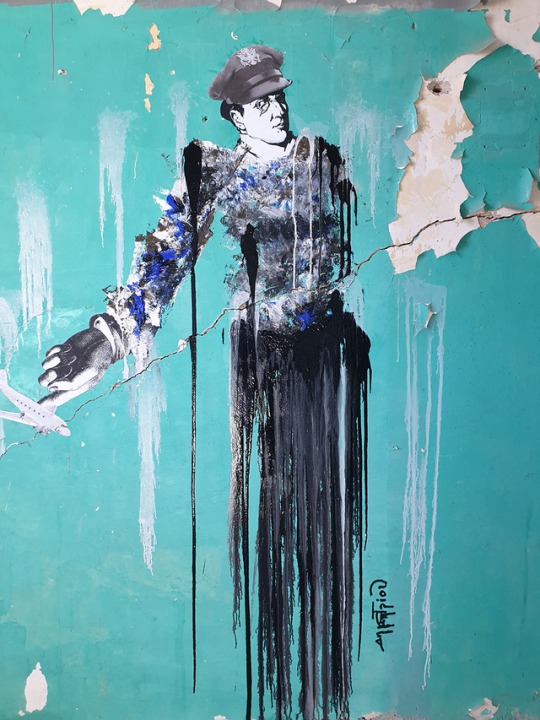
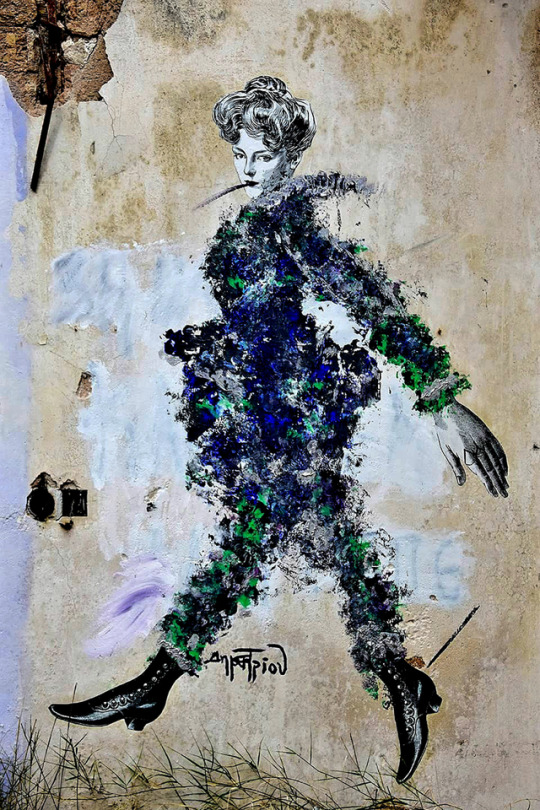
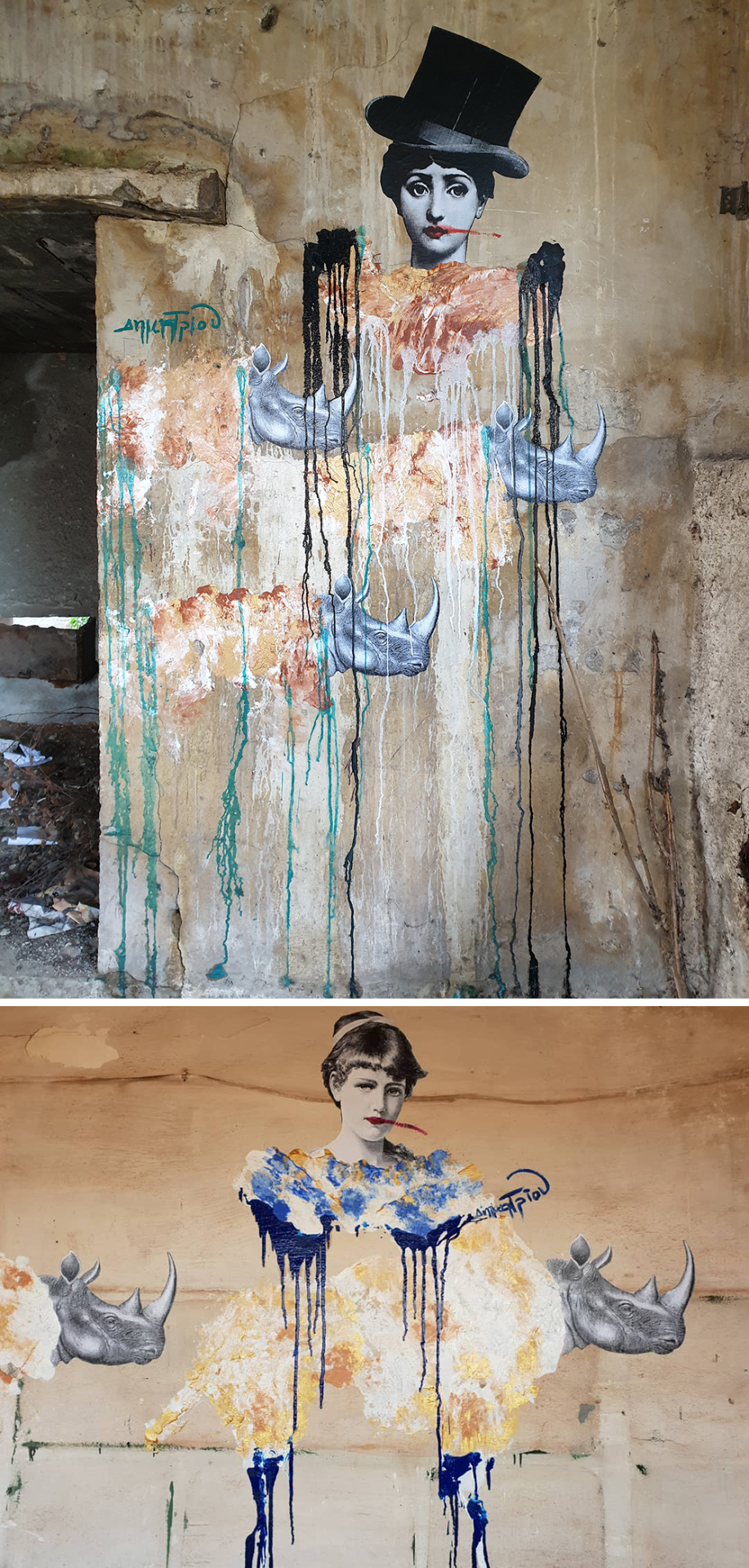
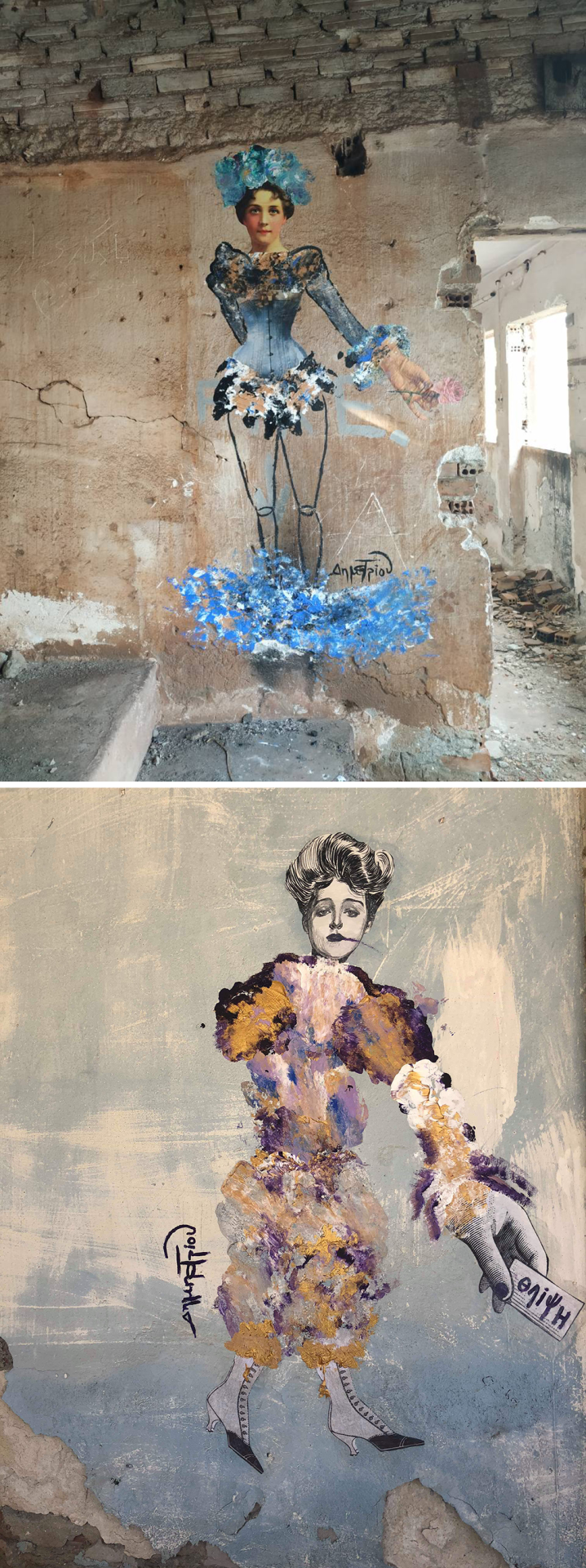



Anna Dimitriou
Director - collage artist, Anna Dimitriou begins to create in public space after the persistent urge of her friends. Her work is special and consists of paper vintage figures found on the internet and color on all kinds of surfaces. This month we’re talking to her and get know her a little bit better.
What have you studied, how does your relationship with visual arts begins?
I graduated from Stavrakos school. I’m a director. I work on Alpha as a trailer director. I’ve also studied theater and journalism. I’ve always been an artistic and independent nature, ever since I can remember myself. In 2006 I started digital collage and so I joined the art field in which I stayed for 12 years.
Tell us a few words about your technique and your main influences.
It's not graffiti, I’d like to say that. It’s a category on its own. My technique is simple and complex at the same time. Paste up and acrylic. I pick up vintage and antique forms, edges and accessories, with starting point at the beginning of the century, and I print them on paper. Then I check if the composition looks like a collage. Dissimilar elements that produce a surreal effect. I paste the papers on wall surfaces with paper glue and I create the body with the Décalcomanie technique, which of course I process with brushes and extra techniques and patents to shape the body. Influences from Toulouse Lotreck, Daddyism and the entire surrealist movement.
What was the cause for creating in the urban landscape? Which was the uncovered need in you now that is now covered with street art?
If I told you it started by chance would you believe me? I'm a new kid on the block, big story. Since 2006 I’ve been dealing with digital collage. Group and solo exhibitions, installations, covers of CDs and magazines only as a collage maker. Then a very sad event happened in my life which gave me this idea, to go out and capture in a perfectly visual way all this pain and anger I had inside me. Then personal anger got wider and became anger for everything out there. The political situation, the sudden deaths of famous personalities I grew up through their art, the ruthless state in which we live, the neglected architectural diamonds that are rotting all over Greece. It was a need for expression, α relief from all that darkness. My strength if you may. In the time, when I saw that I had this impact, these three others elements were added, ambition, self-esteem and a great amount of generosity to everyone.
Tell us about your impressions when you saw some of your artworks interacting with the world. Either from close or via social media.
Great joy and gratitude, firstly because the world recognizes me and secondly because all this is turning into something.
What are your favorite places to create and why do you do it? Is there a basic idea you want to communicate?
Main places are all the abandoned factories, hotels, and houses of historical and architectural significance of the whole Greece that are being ruined and not being exploited. How did all this started? It was 2 years ago when we learned that my father is sick. My father was a part of this old world that I didn’t want to be demolished, to be gone. That's how I started a personal protest. I thought to start from the abandoned Xenia, the well-known hotels of our childhood years, and by marking them with my art to make an artistic protest in order to try and give back the life that they were once promised. My father's life. Xenia Hotels was part of a State Program which aimed at the development of tourism throughout Greece, under the supervision of the GNTO (Greek National Tourism Organization). It was put into operation from 1953 to 1974 as one of the main priorities for the recovery of the economy. In the late 90's the XENIA took the path of misery and abandonment. Currently, the NBG counts 44 hotel units of the "XENIA" type, of which only 11 are leased and some others have been partially or totally assigned. I chose to confront these buildings as architectural masterpieces and elements of organization and shaping space and not as obstacles to development plans. I decided to leave my art without a price to be worn on them and decay, like any form of art will if it won’t be conserved. I want to draw the attention of some people who while have the knowledge and the money, don’t do anything. Scorn devastate architectural diamonds and the architectural historical past of Greece itself. So I started researching, I found their first maquettes, the first comments, some old photos and started the hard work. It became my purpose, something like my destiny. To put it more simply, I believe in the love and kindness of people. And I know I can do it. Because, what’s meant to be, it will find its way to be done.
Essentially, you learn the Greek street art and its exponents by being on the road. What difficulties do you face?
No difficulty. I joined all those who pre - existed under the status of the so-called Democracy, to expose my art. I don’t recall anything that made it hard for me. And if I do it would be of little importance. The crowd accepted me very warmly. Almost with open arms. I think this was because my art is about a big part of this world.
In a relatively male-dominated field, you seem to be doing just fine. What are your impressions of the Greek scene?
Many people at first thought I was a man. Demetrius. After learning that I was a woman I went through a lot roller coasters. Some older people of the field, great and well-known, advised me nicely and gave me credits, but most of them ignore me. I don’t think that the graffiti artists in Athens like my art. Firstly, because I don’t use sprays, so I don’t graffiti, so it’s not something they’ll embrace, secondly it comes from a woman out of nowhere (we know there is racism in Greece). The truth is it's not out of nowhere though. I started in 2006 with digital collage and I made many magazine covers and CDs and many solo exhibitions with great success. I’ve been known from before. I was in the field for 12 years as a collage artist. The road came up as an evolution of my art. So I'm not that much out of the blue. I can understand all this though. It’s not easy to understand and enjoy all forms of art. Particularly the incompatible ones.
Your job being recognized at least by the people that are into this art field almost immediately. Why do you think this happened?
Because people have taste (*laughing*) and because they connect with what they see somehow. It’s very special and unusual as a style. They like it. I think it's simple.
Your favorite collaborations? Which Greek street artist do you admire and haven’t yet worked with but you’d like to?
I don’t think there’s any interest in collaboration. Perhaps some except from lack of imagination, they consider my style completely different. I’ve spoken to many whose work I admire incredibly, some of them have ignored me and didn’t even bother to answer me, others have told me they aren’t interested. Nevertheless, I admire everybody because I consider their works to be pure art.
In ten years from now?
Best case scenario, all the walls in the world will have a work of mine, worst case, I leave a stigma and a story passing from mouth to mouth…
Follow Anna Dimitriou
Website \ Instagram \ Fb Page
_
Σκηνοθέτης - collage artist, η Άννα Δημητρίου ξεκινάει να δημιουργεί στον δημόσιο χώρο μετά την επίμονη παρότρυνση των φίλων της. Η δουλειά της είναι ξεχωριστή και αποτελείται από χάρτινες vintage φιγούρες που βρίσκει στο internet και χρώμα σε όλων των ειδών τις επιφάνειες. Αυτό τον μήνα μιλάμε μαζί της και την γνωρίζουμε λίγο καλύτερα.
Τι έχεις σπουδάσει, πως ξεκινάει η σχέση σου με τα εικαστικά;
Τελείωσα την μεγάλη του γένους σχόλη Σταυράκου. Είμαι σκηνοθέτης. Δουλεύω στον Alpha ως σκηνοθέτης τρέιλερ. Έχω σπουδάσει επίσης θέατρο και δημοσιογραφία. Ήμουν πάντα φύση καλλιτεχνική και ανέντακτη από τότε που θυμάμαι τον εαυτό μου. Το 2006 ξεκίνησα το ψηφιακό κολάζ Μπήκα έτσι στο χώρο της τέχνης και έμεινα σε αυτό τον τομέα 12 χρόνια.
Πες μας λίγα λόγια για την τεχνική σου και τις κυριότερες επιρροές σου.
Δεν είναι graffiti, θέλω να το πω αυτό. Είναι κάτι που αποτελεί από μόνο του μια κατηγορία. Η τεχνική μου είναι απλή και σύνθετη μαζί. Paste up και ακρυλικά. Διαλέγω vintage και antique μορφές , άκρα και αξεσουάρ, με σημείο εκκίνησης τις αρχές του αιώνα, και τα τυπώνω σε χαρτί. Έπειτα κοιτάω η σύνθεση να παραπέμπει σε κολάζ. Ετερόκλητα στοιχεία που βγάζουν ένα σουρεάλ αποτέλεσμα. Τα χαρτιά τα κολλάω στις επιφάνειες των τοίχων με κόλλα χαρτιού και φτιάχνω το σώμα με την τεχνική της Décalcomanie, που φυσικά επεξεργάζομαι με πινέλα και έξτρα τεχνικές και πατέντες αν θες , έτσι ώστε να διαμορφώσω το σώμα. Επιρροές από Τουλούζ Λωτρέκ, Ντανταϊσμό και όλο το κίνημα των σουρεαλιστών.
Ποια ήταν η αφορμή για να δημιουργήσεις στο αστικό τοπίο και ποια η ανάγκη; Τι δεν καλύπτονταν μέσα σου που καλύπτεται τώρα με την street art;
Αν σου πω τυχαία θα το πιστέψεις; Είμαι new kid on the block, μεγάλη ιστορία. Από το 2006 ασχολούμουν με το ψηφιακό κολλάζ. Εκθέσεις ομαδικές, ατομικές, εγκαταστάσεις, εξώφυλλα CD και περιοδικών μόνο ως κολαζίστρια. Έπειτα συνέβη ένα πολύ άσχημο γεγονός στην ζωή μου το οποίο μου έδωσε την ιδέα αυτή. Να βγω παραέξω και να αποτυπώσω με ένα τελείως εικαστικό τρόπο όλο αυτόν τον πόνο και τον θυμό που είχα μέσα μου. Έπειτα ο προσωπικός θυμός πήρε εύρος και έγινε θυμός για όλα εκεί έξω. Την πολιτική κατάσταση, τους ξαφνικούς θανάτους γνωστών προσωπικοτήτων που μεγάλωσα μέσα από την τέχνη τους, για το αδίστακτο κράτος στο οποίο ζούμε, για τα παρατημένα αρχιτεκτονικά διαμάντια που σαπίζουν σε όλη την Ελλάδα. Ήταν ανάγκη έκφρασης, εκτόνωσης από όλο αυτό το σκότος. Η πύκνωση μου αν θες. Με τον καιρό όταν είδα ότι είχα αυτό το impact προστεθήκαν και αυτά τα υπόλοιπα τρία, φιλοδοξία, αυταρέσκεια και μια μεγάλη τζούρα γενναιοδωρίας προς όλους.
Πες μας τις εντυπώσεις σου όταν πια έβλεπες κάποια κομμάτια σου να αλληλεπιδρούν με τον κόσμο. Είτε από κοντά, είτε στα social media.
Μεγάλη χαρά και ευγνωμοσύνη, πρώτον γιατί ο κόσμος με αναγνωρίζει πια και δεύτερον γιατί όλο αυτό πιάνει τόπο.
Ποιοι είναι οι αγαπημένοι σου χώροι για να δημιουργείς και γιατί το κάνεις; Υπάρχει κάποια βασική ιδέα που θέλεις να επικοινωνήσεις;
Βασικοί χώροι είναι όλα τα εγκαταλελειμμένα εργοστάσια, ξενοδοχεία, και σπίτια ιστορικής και αρχιτεκτονικής σημασίας ολόκληρης της Ελλάδας που ρημάζουν και δεν αξιοποιούνται. Πως ξεκίνησε όλο αυτό; Ξεκίνησε πριν 2 χρόνια. Όταν μάθαμε ότι ο πατέρας μου είναι άρρωστος. Ο πατέρας μου ήταν ένα κομμάτι από τον παλιό αυτό κόσμο που ήθελα να μην κατεδαφιστεί, να μην χαθεί. Κάπως έτσι ξεκίνησα λοιπόν μια προσωπική διαμαρτυρία. Σκέφτηκα να ξεκινήσω από τα εγκαταλελειμμένα Ξενία, τα γνωστά σε όλους μας ξενοδοχεία των παιδικών μας χρόνων, και σημαδεύοντας τα με την τέχνη μου να κάνω μια καλλιτεχνική διαμαρτυρία για να προσπαθήσω να δώσω πίσω την ζωή που τους υποσχεθήκαν κάποτε. Την ζωή του πατερά μου. Τα Ξενοδοχεία «Ξενία» (Xenia Hotels) ήταν μέρος ενός Κρατικού Προγράμματος το οποίο στόχευε την ανάπτυξη του τουρισμού σε όλη την Ελλάδα, υπό την εποπτεία του Ε.Ο.Τ. Είχε τεθεί σε λειτουργία από το 1953 έως το 1974, ως μια από τις βασικές προτεραιότητες για την ανάκαμψη της οικονομίας. Τέλη της δεκαετίας του 90′ τα ΞΕΝΙΑ πήραν το δρόμο της μιζέριας και της εγκατάλειψης. Σήμερα η Ε.Τ.Α μετράει 44 ξενοδοχειακές μονάδες τύπου «ΞΕΝΙΑ», από τα οποία μόνο τα 11 είναι μισθωμένα και κάποια άλλα έχουν εν μέρει ή εν συνόλω παραχωρηθεί.Επέλεξα να αντιμετωπίσω αυτά τα κτίρια, σαν αρχιτεκτονικά αριστουργήματα, και στοιχεία οργάνωσης και μορφοποίησης χώρου και όχι σαν εμπόδια σε σχέδια ανάπτυξης. Αποφάσισα να αφήσω χωρίς χρηματικό κόστος την τέχνη μου πάνω τους να φθαρεί και να σαπίσει, όπως κάθε μορφή τέχνης άλλωστε που αν δεν συντηρηθεί θα ρημάξει. Θέλω να τραβήξω έτσι την προσοχή κάποιων ανθρώπων που, ενώ έχουν την γνώση και το χρήμα, δεν κάνουν κάτι. Η περιφρόνηση αφανίζει αρχιτεκτονικά διαμάντια μα και το ίδιο το αρχιτεκτονικό και ιστορικό παρελθόν της Ελλάδας. Άρχισα λοιπόν έρευνα, βρήκα τις πρώτες μακέτες τους, τα πρώτα σχόλια, κάποιες παλιές φωτογραφίες και ξεκίνησα να παίρνω σβάρνα όσα μπορούσα. Έγινε σκοπός μου κάτι σαν πεπρωμένο μου. Για να σας το πω και πιο απλά, πιστεύω στην αγάπη και στην καλοσύνη των ανθρώπων. Και ξέρω ότι θα τα καταφέρω. Γιατί ο, τι είναι γραμμένο να γίνει θα βρει τον τρόπο να γίνει.
Στην ουσία μαθαίνεις την ελληνική street art και τους εκφραστές της ούσα πια στον δρόμο. Ποιες οι δυσκολίες;
Καμία δυσκολία. Μπήκα και εγώ μαζί με όλος αυτούς που προϋπήρχαν κάτω από το καθεστώς της λεγόμενης Δημοκρατίας, να εκθέσω την τέχνη μου. Να βγω προς τα έξω. Δεν θυμάμαι κάτι να με δυσκόλεψε. Και αν θυμάμαι θα είναι μηδαμινής σημασίας. Ο κόσμος έξω με δέχτηκε πάρα πολύ θερμά. Σχεδόν με ανοιχτές αγκάλες. Νομίζω ότι αυτό έγινε επειδή η τέχνη μου αφορά ένα μεγάλο κομμάτι αυτού του κόσμου.
Σε έναν σχετικά ανδροκρατούμενο χώρο φαίνεται να τα καταφέρνεις μια χαρά. Ποιες οι εντυπώσεις σου από την ελληνική σκηνή;
Πολύς κόσμος στην αρχή νόμιζε ότι ήμουν άντρας. Ο Δημητρίου. Μετά που μαθεύτηκε ότι ήμουν γυναίκα πέρασα από πολλά rollercoasters. Κάποιοι παλαιότεροι του χώρου μεγάλοι και πολύ γνωστοί, με συμβουλέψανε όμορφα και μου δώσανε credits, αλλά οι περισσότεροι νομίζω με αγνοούν επιδεικτικά ή με έχουν στην μπούκα. Δεν νομίζω να αρέσει στους γκραφιτάδες της Αθήνας η τέχνη μου. Πρώτον γιατί δεν χρησιμοποιώ σπρέι, άρα δεν κάνω γκράφιτι, άρα δεν είναι κάτι που θα αγκαλιάσουν, δεύτερον έρχεται από μια γυναίκα και μάλιστα από το πουθενά (ξέρουμε ότι υπάρχει ρατσισμός στην Ελλάδα). Η αλήθεια είναι ότι δεν είναι από το πουθενά. Ξεκίνησα το 2006 με ψηφιακό κολλάζ και έκανα πολλά εξώφυλλα περιοδικών και CD και πάρα πολλές ατομικές εκθέσεις με μεγάλη επιτυχία. Υπήρξα γνωστή από πριν λοιπόν. Ήμουν στο χώρο ήδη 12 χρόνια σαν collage artist. Ο δρόμος πρόεκυψε σαν εξέλιξη της τέχνης μου. Άρα δεν είμαι και πολύ out of the blue. Αλλά μπορώ και το κατανοώ όλο αυτό. Δεν είναι εύκολο να καταλάβεις και να σου αρέσουν όλες οι μορφές τέχνης. Ιδίως οι ανένταχτες.
Η δουλειά σου αναγνωρίζεται τουλάχιστον από τον κόσμο που ασχολείται με αυτά σχεδόν αμέσως. Γιατί πιστεύεις ότι έγινε αυτό;
Γιατί ο κόσμος έχει γούστο (γέλια) και γιατί τον αφορά προφανώς με κάποιο τρόπο όλο αυτό που βλέπει. Είναι πολύ ιδιαίτερο και ασυνήθιστο σαν στυλ. Του αρέσει. Νομίζω είναι απλό.
Αγαπημένες σου συνεργασίες; Ποιον έλληνα street artist θαυμάζεις και δεν έχει τύχει ακόμα να συνεργαστείτε αλλά θα ήθελες;
Δεν νομίζω ότι υπάρχει ενδιαφέρον για συνεργασία. Ίσως κάποιοι περά από έλλειψη φαντασίας, θεωρούν παράταιρο εντελώς το στυλ μου. Έχω μιλήσει με πολλούς που θαυμάζω την δουλεία τους απίστευτα, κάποιοι με αγνόησαν, ούτε καν μπήκαν στον κόπο να μου απαντήσουν, κάποιοι άλλοι μου είπαν ότι δεν ενδιαφέρονται. Παρ όλα αυτά εγώ θαυμάζω τους πάντες γιατί θεωρώ τα έργα τους καθαρή τέχνη.
Σε δέκα χρόνια από τώρα;
Στην καλύτερη, όλοι οι τοίχοι του κόσμου να έχουν και από ένα έργο μου, στην χειρότερη να αφήσω ένα στίγμα και μια ιστορία που να μπορεί να λέει για μένα ο κόσμος από στόμα σε στόμα.
#greek street art#street art#street#art#anna dimitriou#collage#abandoned#WHEAT PASTE#paste up#Athens#city#greece#greek artists#walls#outdoors#public art#street art europe#urban culture#γρεεκζ#γρεεκ ποστς
3 notes
·
View notes
Photo
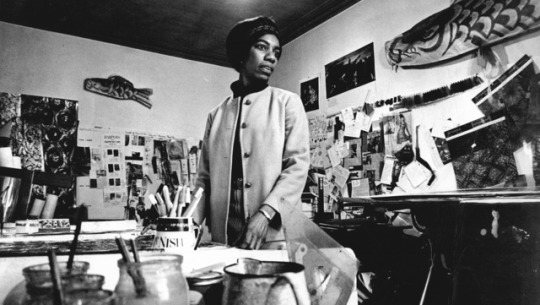
Althea McNish
by Libby Sellers
“London, is the place for me,” extolled Lord Kitchener, one of Trinidad’s top calypsonians, as he disembarked the Empire Windrush at Tilbury docks in 1948. As part of a wave of colonial artists drawn to the “mother country” in search of London’s intellectual and creative center, Kitchener captured the optimism and joy the migrants brought with them. That this optimism infiltrated all corners of British life, and specifically the furnishing and fashion fabrics of homes from north to south, east, and west, owes much to Althea McNish. Born in Trinidad’s capital, Port of Spain, and living in London since 1951, within her textiles McNish “tropicalized” the gray British landscape with all the warmth, sunshine and vibrancy of fellow Trinidadian Lord Kitchener. Yet, in comparison with her textile contemporaries, McNish’s contributions to the transformation of postwar Britain have only recently begun to be acknowledged in her adopted country.
Descended from the Meriken settlers (former African American slaves who had fought for the British during the War of 1812), her father was the writer and publisher Joseph Claude McNish, and her mother, a well-regarded dressmaker. She grew up in a world of words, ideas, and fabrics that, from as young as three, she rendered through her passion for painting and drawing. Trinidad at the time was undergoing a cultural renaissance, inspired by the growing demands for independence and the consequent need of its people to forge their own national and cultural identity. As a junior member of the Trinidad Arts Society, McNish was at the center of this thriving scene, staging her first exhibition in her teens and receiving encouragement from her elders including Sibyl Atteck, M. P. Alladin, and Boscoe Holder. Despite her prodigious fine-art talent (she later worked as a cartographer and entomological illustrator with the British government in Trinidad), she dreamed of construction and engineering, studying architecture with a local town planner and taking a particularly unusual interest in septic tanks (developing blueprints for a homemade tank in the family’s backyard).
It was on the back of this fascination that she applied for a scholarship, earning a place at the Architectural Association School in London’s Bedford Square in 1951. She had a seven-year course ahead of her and a grant to last the duration, though dreading the cold, gray British winters McNish transferred to the (shorter) undergraduate courses at the London School of Printing and Graphic Arts. Her interest in textiles was awakened by a visit to an exhibition of student works at the Central School of Art, where British artist Eduardo Paolozzi taught textile design. Through her print studies at the London School of Printing, evening classes at Central, and then postgraduate degree at the Royal College of Art (RCA) she mastered the medium, learning how to develop colorways, create repeats, and prepare her artwork for production as well as learning the production process itself. This relatively rare understanding of both the design and production sides offered McNish inventive freedom, but it also safeguarded her inventiveness. Her ability to speak the printers’ language enabled her to “preserve the integrity of her chosen colors.” McNish added, “Whenever printers told me it couldn’t be done, I would show them how to do it. Before long, the impossible became possible.” At the time, the RCA’s studios were located within the Victoria and Albert Museum. That McNish had chosen to develop her artistic vocabulary surrounded by the museum’s collections, historically garnered from Britain’s Empire, was an awkward oxymoron she claims not to have noticed. Yet McNish is not easily discouraged; her forceful colors are demonstrative of an equally forceful will.
Her most celebrated design was inspired by a weekend visit to the home of her RCA tutors, Edward and Charlotte Bawden, in Great Bardfield, Essex. Sketchbook in hand, she was drawn to the sight of the sun glistening over the fields. As she said of the moment, “In Trinidad, I used to walk through sugar plantations and rice fields and now I was walking through a wheat field. It was a glorious experience.” Through her colorful lens, this bucolic English idyll was transposed, resulting in the design for Golden Harvest (1959). The design and its various colorways were later purchased by Hull Traders, who, through its continued patronage, were to become an important client for McNish, producing short runs of her avant-garde designs.
Her impressionistic lines and blaze of colors burned bright at the 1957 RCA degree show. Pat Bishop, the Trinidadian artist, described how, "Swinging London was on its way...McNish was there to satisfy that need with her big, beautiful splashy prints of every kind of flower and tropical pattern imaginable." Within a day of graduation, she was called to the offices of Arthur Stewart-Liberty, of the eponymous London department store. McNish recalls of the meeting, “He thought Britain was ready for color,” and through such designs as Cebollas (1958) and Hibiscus (1958), he made sure Britain could buy it through him. While her near contemporaries Lucienne Day (1917–2010), Jacqueline Groag (1903–1986), and Marian Mahler (1911–1983) were bringing much needed cheerfulness to the drab days of postwar Britain, McNish’s riot of color was like a volcano erupting through the center of conservative British modernism. “Color was mine,” she declared. Though Day, Groag, and Mahler were to be given more credit.
After their successful 1957 meeting, Stewart-Liberty sent McNish by taxi directly to Zika Ascher, the producer and retailer of extravagant and experimental textiles to the fashion industry. With clients including Cardin, Dior, Schiaparelli, Givenchy, and Lanvin, it was not long before McNish prints such as Tropic and Giselle of 1959 were gracing European fashion magazines. In 1966, when Queen Elizabeth II visited Trinidad in the early days of post-Independence, McNish designed fabrics for her high-profile, official wardrobe.
In her public and professional engagements, she was, as the author Alan Rice suggested, “a rare black and female presence.” Committed to developing her industry and offering a role model for future generations, McNish taught extensively and was a prominent member of various arts councils and bodies. As a founder member of the highly influential Caribbean Arts Movement (CAM) in the mid-1960s, she did much to promote Caribbean artists to the British public, including organizing works by herself and her peers for the 1973 BBC TV magazine program Full House, produced by John La Rose. Her position as the first black British textile designer of repute is something she shrugs off, claiming she never suffered any discrimination due to either her race or gender: “I was so rare, they were dumbfounded.”
In the 1960s, as textile manufacturing declined in the UK, giving rise to the import of plain cotton cloth, the demand for designers to produce patterns for the consumer boom grew. By offering complex patterns that she alone could achieve with the printers, McNish secured contracts with most of the UK’s leading firms, including Cavendish Textiles, Danasco, Heals, and the Wallpaper Manufactures Ltd. (for which she designed the Crystalline print for their Palladio range of 1960). On a 1963 Cotton Board scholarship she traveled to Europe investigating the state of British exports. It was not long before she was selling designs directly to upmarket European firms including Bucol in Lyon and Fede Cheti in Milan among others. Britain’s most successful postwar design consultancy, Design Research Unit, commissioned McNish to design murals for their public and corporate clients including British Rail and the Orient Steam Navigation Company. When the SS Oriana launched in 1959, she sailed McNish’s laminate panels, Rayflowers and Pineapples and Pomegranates, around the world on the walls of its restaurants.
While she effectively retired from textiles in the late 1980s, throughout the intervening years her works have been included in a growing number of exhibitions exploring the under-recognized influence of artists from the African diaspora within British art. Within this context, McNish’s “tiny flowers picked from the British hedgerow transformed into tropical exuberance” take on an entirely new significance, both for the history of postwar textile design and British modernism in general.
Libby Sellers is a design historian, consultant, and curator based in London. The above chapter is an excerpt from her book Women Design, which was published by Frances Lincoln in June 2018.
47 notes
·
View notes
Text
Planning A Class Reunion In 75 Days (Part One)
Planning A Class Reunion In 75 Days (Part One)
Mission Statement: The mission of the Frazier School District is to empower students to take ownership of their learning. As a high school coach there is a lot more time to help players develop than AAU coaches have. Charles Darwin struggled his lifetime to reconcile religious beliefs of his day with his theory of evolution. Edmonds Community College has organized the international high school program since 1993. In the early morning hours of February 14, 1981, two disgruntled Kurs za autolimara students set the school's buildings on fire. Elective classes that do not allow a student to earn a 5.0 will bring down a student's overall GPA, even if the student earns all A's. Students from every classroom along the hall fill the empty corridor, all heading to the Wildcats game. Currently, I am working with students in the virtual world and discovering how to assist them in the online classroom. Teachers in private schools do not need to meet state requirements.
I would greatly appreciate any update on the students on the video clip: Barkede Kulumundere Dedebe and Olijaholi Gnamanitakuy. However, if you loved high school and feel it would be worth paying good money to see people from your past then, by all means, please go. However, I feel there are more economical and practical ways to stay in contact with high school friends rather than paying to see them at an overpriced party. Personally, Kurs za varioca AP classes are a godsend that allow me to be in intelligent classes where I am challenged and can learn new things. It has also been determined that high school students had more positive attitudes, that is, had a more mature was of expressing themselves than the elementary school children. I thought we'd be going into our senior year as the best of friends and create a lifetime of fun, positive memories together.
James didn't need college but a host of others do. Even Bryant averaged less than 8 points and 2 rebounds a game as a rookie and shot under 42%-that's okay, but he was no savior coming out of high school. Free printable diplomas for students completing preschool through high school grades, plus GED or to note general educational achievement. Sometimes the high school cheer leader does not live happily ever after, and being a nerd might be a srednja skola bravar blessing in disguise. Even if the college you plan on attending doesn't accept AP credit, they still look at the rigor of your classes, your academic work ethic, and how well you do on standardized tests. Comics as Spanish projects for high school students are a good idea for the ones in your class who enjoy drawing. They determined that it was better for their own product to prohibit players from applying for the draft out of high school.
These lesson plans serve as guides and ready-made formulas to help teachers bring authentic, inquiry-based learning experiences to their students. I am certainly not opposed to players who are good enough to contribute to an NBA team going pro, whether they are high school kids or college juniors. Rationalizing that they were doing their own applications or had family commitments, I decided to let it play out and talk at school the next vanredno skolovanje 4. stepen day. AP tests are exams for high school courses that cover college level material. Used in high schools and higher education, Sophomore refers to the 2nd year of study. Roma: Most high schools will not let you retake a class unless you failed it originally. All of the backpacks listed on this page are highly recommended by consumers and will provide a comfortable fit, durability, and optimal utility, especially for high school students.
Join over 60,000 students like you, who choose Penn Foster to earn an accredited high school diploma online, on their terms. Just started teaching a Sunday School class last weekend :) I'm excited to incorporate this in my lesson plan. In some private schools, such as Catholic schools , theology is required before a student graduates. Auditions on the middle and high school level should be fun, Srednja elektrotehnicka skola beograd unintimidating, and accessible for all interested students. In the United States , a high school is a school that students go to usually for grades 9 through 12, from the ages of about 14-15 to about 17-18. Whether it's by earning college credit or strengthening artistic or professional skills in an intensive non-credit offering, students will experience college and city life, first hand.
I communicate to students that the purpose of call backs is for me to see individuals and combinations of students who I didn't see enough of the first time around. Students complete lab activities in Computer Engineering, Chemical Engineering, Electrical Engineering, Material Science, Civil Engineering, Robotics, and Mechanical Engineering. The programs that require a co-op experience include the College of Engineering and Applied Sciences, Upis u srednje skole College of Design, Architecture, Art and Planning, and the IT major in the College of Education, Criminal Justice, and Human services. AP classes will improve and fine-tune these abilities at a faster rate than college preparation or honors courses by sheer quantity of information and higher expectations. When students first begin a personal journal or writing notebook they will spend a lot of time staring at a blank screen.
We frequently recommend this software to parents of upper-elementary to high school students because it is so user-friendly and because it makes the writing process much less daunting. It is hard to believe it has been twenty years, but I am so thankful for the education and teachers I had during that time. I had a small group of friends that I still talk to and see today, which means Redovno skolovanje life is continuous high school reunion. I am wondering if I should do a written explanation at some point soon, just so that all students have an opportunity to share their idea and then I can consolidate results and show them how many different methods were used and how many people chose each method. When I post the cast list, I tend to do it during a time when students are in class.
15 notes
·
View notes
Text
Anonymous Butterfly Soup asks, batch 6

IT’S RIGHT NEXT TO THE BIG TOBLERONE I’M ALIVE
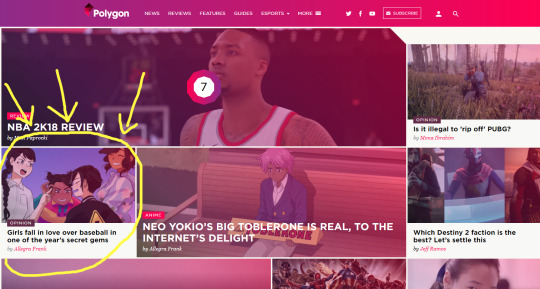
Being covered by a big gaming news site was one of my fantasies, so I’m elated this happened. The article is here, for anyone curious!
More asks under the cut!!
A note before I start -- if you submitted a bug, I saw it!! Thank you for reporting them!

Yes, she did! Her Facebook profile pic is her posing in front of a store at the mall, and you can see Jun’s reflection taking the pic in the store window

Akarsha didn’t realize, but Noelle totally heard it. Noelle kind of had a sense of what was up already, but actually hearing it worried her. She was debating whether or not to intervene when Min showed up.
On a small note, Min trying to cheer Akarsha up slightly improved Noelle’s opinion of Min (even though Min and Akarsha almost end up fist fighting again afterward).

Min plays video games too, imagine them playing Team Fortress 2 and later Overwatch together... Diya, Min, and Noelle have all seen some basic anime like Pokemon, Digimon, and Yugioh, but Akarsha’s the only real hardcore anime fan. I’m glad she met “Sakura”, “Yuki”, and Ester through the baseball club, because now she has weeb friends to talk about that stuff too.
(Ester is less obvious about liking anime than “Sakura” and “Yuki”, but you can still tell by her outfit’s style. Lowkey but not lowkey enough)

I can totally relate to all of them, but I’d say Diya!

Yes, they grow close over the course of the year and Noelle has to try really hard not to cry LMAO They still keep in touch afterward.

Yep, they both feel this huge gulf between themselves and their parents due to cultural differences. Many Asian immigrant parents are extremely conservative so it feels like they’re on a completely different wavelength from you, and at the same time they have complete power over you. It’s kind of a bad feeling.
...Also, shadowing their faces saved me the work of drawing their different facial expressions.

Min was actually out of town when the fire happened, so Diya had to call her and tell her what happened :( Diya (and eventually Min) sleeps on Noelle’s couch for a bit. Noelle and Akarsha aren’t living together at the time and Noelle has the nicer/cleaner apartment
It sounds really miserable, but they’re ok in the end

Noelle's passion is math and science, so she definitely ends up doing something in STEM that she likes, just not what her parents were expecting. Akarsha is similar and becomes a software engineer -- They’re actually both naturally interested in those subjects, which says a lot about how bad the parental pressure really is.
I like to think Diya and Min actually manage to break into minor league baseball and eventually MLB

Most of my outfit inspiration comes from my tumblr/twitter feeds. I wish I could recommend you fashion blogs, but I’m not following any?! They’re all just fandom mutuals who randomly reblog cool clothes sometimes.
I used to have trouble deciding what clothes characters should wear, so every time I see an image of a cool outfit I save it for reference. After doing this since high school I now have...uh...

And those are just the unorganized ones, the ones i have in folders are like...

Now if I’m stumped for what a character should wear, I just browse these massive folders for inspiration. I can actually pinpoint the omocat jacket that gave me the idea for Min’s:
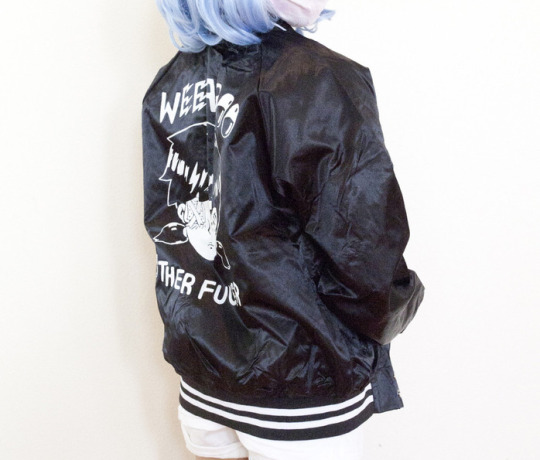
I thought, “it should be a warning: high voltage sign on the back!”, and then I just went on Google images and looked them up.
Sorry if this isn’t helpful!

I don’t think Min really minds, but The Squad is even better! Deke squad

Yeah, Akarsha’s parents wouldn’t approve either. Out of the main four, Diya is actually the only one whose parents are fine with it

Ooh thank you this is an awesome compliment to receive!!

I REALLY want to make merch some day! I’ve never made physical merch before and I’m a bit intimidated not knowing where to start/how to handle shipping, so it may take a while, though :(

I didn’t give anyone last names and I doubt I ever will, sorry! Feel free to give them your own if you want

This was intentional, but at the same time I can’t believe everyone IMMEDIATELY noticed. You guys are so in tune with 4/20


Diya and Akarsha are Indian, Min-seo is Korean, Noelle is Taiwanese, Chryssa is black, Liz is…mostly Irish, I think? “Sakura” is Pakistani, “Yuki” is Filipino. I’ve heard a lot of guesses for Ester, but she’s half black and half Chinese!

i got u son!!

Thank you, I really love hearing this because the feeling that this narrative was missing was what made me want to make this game in the first place!

you might feel a bit more sympathetic to min when you reach her part of the story! Your mileage may vary, though


If you want to make a game like Butterfly Soup, try the program Renpy! It doesn’t require programming experience to use and there’s a lot of guides online on how to use it.
My NUMBER ONE BIG ADVICE IS MAKE A REALLY, REALLY SMALL GAME FIRST. My first game, Pom Gets Wi-Fi, was only 30-45 minutes long. If you make it any bigger than that, you almost guaranteed will never finish it.
The dream game that you want to make is probably longer than that, so don’t make your dream game first! That’s kind of why I was so alarmed when Pom Gets Wi-Fi took off -- I’m very proud of that game and still love it, but it was like my test for the games I dreamed of making like Butterfly Soup.
(Also, 17 is a great age to start making games, good for you!)
Other stuff I’ve learned:
Programming: I mostly learned super specific things that can’t be easily applied to other situations. If you want to know how I did a specific thing in Renpy, message me!
Writing: If you’re struggling to write something, it might be for a good reason. Maybe the scene is unnecessary or boring, your mental image of the scene doesn’t translate well to the format of your work, or the character motivations aren’t convincing enough. Deleting a scene altogether isn’t defeat, sometimes it’s the best path forward! Give up more!
Artwise: Drawing for non-pixel art games takes FOREVER. The sheer amount of time it’d take to draw all the characters and backgrounds was so demoralizing that I found myself procrastinating because I didn’t want to tackle it. Not only did I have a large cast of characters (9 in the baseball club alone), but because of flashbacks, I had to draw half of them again as kids!
To anyone thinking about making a game by themselves, SERIOUSLY consider making it a pixel art game. If you’re that set on making a non-pixel art game, SEVERELY limit the number of characters and backgrounds you have to draw!! I’m begging u...learn from my mistakes...

You’re welcome!!! :>

I loved USC! The Interactive Media major was cool and fun -- I met a lot of good friends through the program! It was probably the best few years of my life.
Unfortunately...I felt like it did nothing to prepare me for finding a job. There are very few classes for aspiring game artists and game writers. There wasn’t a single professor who worked as an artist at a triple A studio while I was there, and only one who was a major writer. I get that you gotta be self motivated, but I wish I had someone in the faculty I felt comfortable discussing my career path with. Some of the professors had clear favorite students and if you weren’t one of them, they’d make very little effort to reach out to you or interact with you. I know I'm introverted, but I never got this feeling with my general elective classes -- I had plenty of chances to talk to my writing professor, architecture lab professor, art teacher, etc., yet I came out of a lot of my Interactive Media classes wondering if my professors even remembered me.
If you want to be a game designer or maybe a writer, and are really focused/outgoing with your professors, it could be the major for you, but if you want to be a game artist I’m not sure it’s the best place to be.

I was actually crazy stressed out when it came out, so nope! It’s happening this weekend

I was super nervous right after it came out because I was worried people wouldn’t like it! I put a lot into it, and actually teared up writing parts of it, so it was a ridiculous relief to see that people were touched by it. I’m really happy now and really want to make a sequel.
Also, I’m beyond grateful to my friends/mutuals/fans spreading the word and tweeting/posting about the game and making fancontent ;~; I really owe everything to them!
A few people wondered about how I was holding up attention-wise, and actually...as a fanartist I sort of thrive on this, haha. Also, this is much less intense than when I released Pom Gets Wi-Fi. For perspective, it took Butterfly Soup a week to reach the number of downloads Pom got in one day.

Good!!! You’re welcome!

you’re welcome!!!
241 notes
·
View notes
Text
quantum mechanics, smirks, and other complications of the universe (Pidge/Lance)
Summary: It’s the littlest things that are hardest to measure. Pidge tries anyways.
A/N: birthday fic for @flusteredkeith !!! you know how much I love you and basically every other fic I write ends up dedicated to you anyways but here’s a lil something short and sweet set in the canon universe <3 have a beautiful day~~
A/N2: partially inspired by this art by @shiros-sugar !
[Read and review on Ao3] or continue under the cut.
The Heisenberg Uncertainty Principle says this: the more you know about the position of a particle, the less you can know about its momentum, and vice versa.
Pidge’s Field Guide to Her Friends (Version 2.0, after extensive beta testing) says this: in precisely ten ticks, Lance will approach the tall, four-eyed, four-armed alien with a wink and a pick-up line.
Sure enough, the experiment begins right on time. Lance saunters over, all long limbs and diamond-edged smile, leaning casually against the pillar to deliver his pièce de résistance: “Are you from space? Because your body’s out of this world.”
Based on Pidge’s calculations (after all, a scientist is only as good as the notes she keeps), this line has a 67% success rate.
The alien looks at Lance, all four eyes staring at him blankly, before excusing itself from the conversation. Pidge turns around to hide her snicker, taking out her palm pad so that she can update her data. The column keeping track of “overtures made” goes up from 27 to 28.
“What are you doing?” Hunk appears at her shoulder.
“Testing a hypothesis. Have you ever thought about how Lance is kind of like Schrodinger’s Cat?”
Hunk strokes his chin. “Not really. Explain.”
“The cat is both dead and alive until you open the box. Lance is both charming and not until he opens his mouth, and then he’s just… not.”
“Hey!” This comes from over her left shoulder; Pidge nearly jumps out of her skin upon realizing that the topic of their conversation has… decided to join the conversation.
“How long have you been standing there?”
“Long enough to hear you talking about me behind my back,” Lance pouts. “Not cool, Pidge. I thought we had something.”
“Sorry, I’m taken by science.”
Lance snorts and rolls his eyes, bumping her on the shoulder before his attention gets caught by the arrival of a new prospect. In no time, he’s jumped right back in, and Pidge wonders, briefly, what that must feel like. To throw yourself into something without any idea of where the chips will fall.
Out of the corner of her eye, she catches Hunk smirking at her.
“What?”
The grin widens. “You think he’s charming.”
*
“Psst, Pidge!” Lance accosts her on the couch, draping himself over the back of it to speak right in her ear. “I need your help.”
At this point, Pidge is proud to say that she’s gotten better at managing her reactions to Lance sneaking up at her. Coolly, she closes her laptop, turning over her shoulder to ask: “With what?”
Lance shoots her a cryptic smile, shoving his hands in his pockets as he moves around the couch to stand in front of her. “Come with me and you’ll see.”
Several scenarios flash through her mind. 1) Prank—a bucket rigged to spill on her head. 2) Surprise—Lance is a generous person, after all, and he did joke once that he was going to knit her a sweater. 3) Lance actually needs help.
Statistically speaking, it’s probably option three.
Sighing, Pidge gets to her feet and follows him out of the room. Lance whistles, hands braced behind his head and elbows jutting out in the air as he leads them, cheerfully, through the halls. They come to a stop in front of a set of doors, the scent of manure hitting her as they slide open, a low moo echoing from inside.
“Kaltenecker,” Pidge gasps, feeling immediately guilty. “I forgot.”
Lance has already crossed the room in a few quick, easy strides, bringing a hand to Kaltenecker’s flank. She moos again, turning toward him slightly; Lance raises an eyebrow at Pidge, gesturing her over with a slight tilt of his head.
So Pidge goes. It makes her feel bad, wondering if Lance has been checking up on Kaltenecker all this time without her. Cautiously, she reaches toward the cow; Kaltenecker nudges against her palm gently, nostrils puffing warm air, nose slightly wet.
“There, see?” Lance is saying, stroking Kaltenecker’s side. “Mom didn’t forget about you, she was just busy.”
It takes a beat for the words to hit. “Mom?”
Lance scratches the back of his neck, looking sheepish. “I mean, it felt weird to refer to myself as just the owner—that’s so cold, you know? I figured we’re basically like Kaltenecker’s parents, so you’re Mom and I’m Dad—” Halfway through, Lance breaks off. “Okay, now that I’m saying that out loud and to your face, it sounds pretty weird.”
“A little.”
“I mean, if you have an alternative…”
Pidge purses her lips. “Why am I the mom, anyways? Why can’t you be the mom and I be the dad?”
“Fine, I’m the mom,” Lance says, not missing a beat. They hold each other’s gaze for a solid ten seconds before a laugh bubbles up Pidge’s throat, and then she’s snorting into the back of her hand while Lance snickers.
“Who gets custody if we fight?” she asks.
“Hunk.”
“That’s actually what I was thinking, too.”
“Good to know we’re on the same wavelength.” Lance grins.
Kaltenecker snuffles against her hand again, and Pidge says: “Lance?”
He pauses his motions, tilting his head. “Hm?”
“We should do this more often.”
Lance’s brow furrows. “The accidentally adopting a cow part, or the taking care of Kaltenecker?”
“Just—hanging out,” Pidge says, and she doesn’t know why those two words summon a burst of heat to her face, but she turns away slightly to hide it, not wanting Lance to get the wrong idea.
“Yeah,” Lance says, maybe a touch too quickly. “Yeah, of course.”
*
“Lance. Laaaaance.”
“What—dammit, Pidge!” says Lance, scowling as he turns his face straight into the finger Pidge has poised by his cheek. “I can’t believe I fell for that.”
In the aftermath of their bout of Killbot Phantasm 1, Pidge sets her controller down and sprawls out on her back, the metal flooring cool against the base of her head. There are a host of things to attend to: checking up on Green, helping Hunk in the kitchen, trying to advance another level in the Altean language training program. But, for whatever reason, she wants to prolong this moment.
“You’re just a sucker,” she teases, folding her hands on her stomach.
Lance joins her after a beat. The hair on her scalp prickles at his nearness. “Enjoying the view?”
There’s nothing much to look at, just the cavernous arches of the ceiling. Pidge traces a beam with her eyes, wondering briefly about what the rest of Altea’s architecture must have looked like, before she asks: “Lance, were you any good at spotting constellations?”
Matt had been good at it. She remembers lying on a picnic blanket, sandwiched between him and her dad. The stars glimmering to life one by one, the strength of their light growing as the night wore on, deepening. Making a game of who could find Orion or Perseus first.
“Not really,” Lance admits. “I could basically just find the Big Dipper and…that one swan one.”
“Cygnus?”
“Yeah.” Lance is quiet for a beat, and then he adds: “It makes sense that you’d be good at them.”
Pidge frowns. “What makes you say that?”
“I was just thinking of what you did with your Galra finder—”
“Technically, it wasn’t made to find them, just to predict their most likely locations—”
“Okay, predictor, whatever,” Lance says, nudging her slightly with his elbow. “But that’s the point, right? You find patterns. You connect the dots.”
This last part is said…differently, somehow, and Pidge turns her head, startled to find Lance already looking at her instead of the ceiling. His face is frighteningly close, lashes dark against the smooth, tan skin of his cheek. For the first time, Pidge notices the gentle slope of his nose, how it would only take a few inches for her to bump against it, to touch foreheads. A small adjustment.
Lance’s lips part slightly. To take a breath, or say something else. Something that’ll ruin this between them, whatever this is, and Pidge can’t take it, would rather not have her hypothesis confirmed. (I think of you like—)
She jolts away. Sits up. Something flashes across Lance’s face, too quick to catch.
“I forgot—I promised Hunk I’d help try to translate some of the Altean ingredients in the kitchen today.”
“Yeah.” Lance doesn’t miss a beat. “Yeah, you should go.”
At the doorway, Pidge pauses.
A theory: it will hurt if she looks back.
It’ll hurt more if she doesn’t.
She risks a glance over her shoulder. Lance is still lying on the floor, hands braced behind his head, now, staring up at the ceiling. His cowlick is more evident from this angle, like a little sprout. She imagines squashing it flat with her hand, then squashes that desire, too.
*
The quandary of quantum mechanics: when you get down to the tiniest level, the very act of measurement affects what you’re trying to measure. Hence the inability to know for certain both things at once—momentum and position, for instance.
Memory is a little like that, too. Pidge has read about it—how every act of recollection alters it, slightly. And with the number of times she’s replayed certain moments—a joke made over their communications line, but just for her ears; a brush of fingers; the upward tick of Lance’s eyebrow; a razor-thin smirk shot across the dinner table—well, her data’s skewed now, isn’t it?
Some things don’t make any more sense under a microscope. You can spend all night turning them over in your head, and the harder you look, the more they seem to shift, made inscrutable. It’s the difference between observing things and actually living them, maybe. The risk of getting too close.
*
Pidge excuses herself from the celebration after a few rounds of mingling. She’ll dive back in later, but it’s looking to be a long night and she needs to recharge. Some people draw their energy from others; Pidge, on the other hand, has always preferred programming to people.
Jespora’s two moons are bright, the stars scattered between them like tiny jewels on black velvet. There aren’t any constellations that Pidge can recognize, here, so she entertains herself with drawing some of her own. The quiet reminds her of sneaking out onto the roof of the Garrison, tuning in to the chatter of the universe. Ears straining for answers, Matt and Dad somewhere out there, still. Send me a sign.
“So, you come out here to rock out?”
The voice is right in her ear. Pidge flails, and it really is like they’re back on the Garrison roof—Lance crouched over her, a single eyebrow raised. The only difference is that they’re both wearing formal wear, this time, and the collar of her suit suddenly feels too constricting.
“Something on your mind, Pidge?” Lance presses, settling down next to her. He stretches his legs out, leaning back on his hands. No hesitant “Can I sit here?” Lance just slots himself into place, buoyed by an easy self-assurance that Pidge envies, sometimes.
Pidge eyes him warily, reorganizing her body into her earlier cross-legged position. Careful not to accidentally brush against him with her knee. She’s not used to being this aware of her limbs around Lance; yet another thing that snuck up on her, before she knew what to do with it.
“I just needed some space,” she admits. “Sometimes it feels like…like there are too many people to keep up with.”
Lance reaches over, gently fixing the tassel of one of her epaulettes. “Yeah, I get it.”
“You’re good at this stuff, though,” Pidge says, forcing herself to be still under his attention. “Talking to people, making them laugh…” She trails off, hugging her knees to her chest. “Why’d you come out here, anyways?”
At her shoulder, Lance’s fingers pause. “Honestly? There’s this girl I wanted to hang out with, but she bailed.”
Pidge snorts. “Typical,” she says, proud that her voice comes out with its usual blend of sarcasm and annoyance. Green with envy. Never have her paladin colors been more apt. But Lance is never going to get a read on her, not if she can help it.
She can still feel his attention on her face, though, which is all wrong. Pidge is the one who keeps track of everyone, categorizes strengths and weaknesses, takes notes. Lance’s job is to crack jokes and come up with dumb team slogans and—
Lance sighs. It’s the heavy, long-suffering sound of someone giving up. Giving in.
“You have no idea who I’m talking about.”
“Um, no, was I supposed to be keeping track?” Pidge retorts. Rhetorical question, since she does. Keep track. Not that Lance has to know. Pidge pulls her bottom lip between her teeth, wondering if it was the tall alien lady with the pink eyes and blue hair buns. Probably.
“It’s you, Pidge.”
The ground tilts, just a fraction, beneath her. This isn’t part of any mathematical model she could fit to their interactions, not something she could have predicted.
“What?” she says, a little shrill.
“It’s you,” Lance repeats, blue eyes boring into her, and she wants to ask him about what that means. If he has some sort of plan in his head for where to go from here. If it’s just a spur of the moment thing, a whim that’ll fall, unspoken, through the cracks, forgotten by morning. Pidge thinks all this but doesn’t have the right words to formulate around them. Just sits.
It’s such a Lance thing to do. Offer up vulnerability without any meditation on what it might cost him. Say something simple and leave her spinning, still caught up in the uncertainty of it all.
In the end, though, it comes down to a simple truth. Like wave-particle duality or the law of universal gravitation, this is what Pidge knows: Lance will do his best to catch her as she falls.
“So what do you say, Pidge?” Lance gets to his feet, offers a hand. “It takes two to tango.”
“You’re so weird,” she finally manages, wrinkling her nose, but she lets him pull her up, lets him spin her out with a flourish, connected by their hands, until somehow they end up pressed close in the moonlight, her head resting against his chest.
She can hear his heartbeat, thumping just a tick too fast. Unexpected, but right, somehow. She swallows.
“Interesting.”
“Good interesting?” asks Lance, vulnerable beneath his teasing. Both smug and uncertain, as only Lance can be.
“Unclear,” Pidge considers, tilting her head to blink up at him. “Needs more data.”
Lance chuckles and hugs her tighter, her chin digging into the knobby bone of his sternum, and Pidge smiles, too, a particle firing in the dark—unsure of when this feeling started or how fast she’s been barreling into it but knowing, down to the electron, that her heart is exactly where it should be.
#plance#pidgance#flirtyrobot#pidge#lance#voltron#my writing#ff: voltron#fanfiction#otp: teenage dream meme team
160 notes
·
View notes
Photo

Innerview: Sonya Baughman / Review Magazine
July 2008
Image: DJG's "Live & Let Die" Record by Paul McCartney & Wings
Note: Interview for a magazine feature.
01) Where did you grow up and where do you live now?
My young cloth diapers treaded a lot of dirt, dead animal and doggy acres in the North Central stick regions of Missouri, Mid-West, USA. Currently, adult plastic diapers drag and sag me in mid-town Kansas City, MO. The first six years had me bucking bales, falling off hay wagons, piercing my cheek on a hay bale stinger, assisting with the old cow stuck in the mud, designing elaborate tunnels and forts from tomato cages, watching “The Muppets” and “Star Wars” a lot, hearing scary stories of Leopard Man, posing for many pictures with dead and live animals, rocking out in cowboy boots to “Live & Let Die” on my Papa Smurf guitar, and crying at night to my raccoon wallpaper…among many other early formative brain tattoos. Act Two had many dry summers and the bank repossessing the farm and moving us to the home and acres where my Dad grew up. The new place had a blacktop in front of it and a gravel lane with a bridge/creek. The blacktop was a reservoir for leaving behind summertime shoe and bike impressions and for popping tar bubbles in the blistering heat. I also was of age to really explore and build many forts and treehouses in the ditches, barns and woods. Also, I started to go hunting and spend time in the fields with my Dad. We never had a shortage of animals and pets too. A lot of spare time was also spent in the sandbox or in the bedroom designing and building things based on what I saw and experienced. There was also a massive in-take of drawing and pop-culture from comics, books, music, television and movies. There wasn’t much of a cap on what my siblings and I could devour. Oh, and loads of sugary sweets and cereals. Go through the yearly motions and I end up at Southwest Missouri State University in Springfield, MO. There I got some very formal education and incredible interaction with students and design professors from the great making thing ways of Eastern Europe and Russia. I pretty much maxed out my art and design class card and was even making a ton of design work on the side for musicians. I then received a higher calling to drop out of school and make my guts out in Kansas City, MO which is where I’ve flopped around now for the past seven years.
02) Talk a little about your artistic background. Are you self-taught, did you go to college for art (if so, where)?
My background is painted with loads of pop-culture from the 1980s and ’90s mixed in with the soil of farm life. I also designed and built many elaborate tree houses and forts up until the age of eighteen and spent most any spare minute in the sandbox or locked in my room drawing, reading, studying, video game playing, movie watching and just playing in general. I’ve never understood people’s ability to get bored or to not use the creation within them to ooze life out. I’ve enjoyed drawing comics, sports mascots and WWII battle scenes with my Dad at a young age that involved aircraft carriers, tanks and flags of those involved in conflict. My older brother would also draw a lot with me. He was better though. My younger sister and brother were pretty solid too. We have no idea where our creativity came from other than a great uncle, maybe? Also in my youth I would make giant collages out of magazine clippings and lots of mix tapes of Dr. Demento’s bizarre radio program and recorded and memorized many a variety of cartoon episodes and cool shows like Pee-wee’s Playhouse. I’ve also been a constant collector all my life. Back in the day I was all about the whole spectrum of toys, comics, ball cards, cereal boxes and loads of other junk…even kept dead animal parts under my bed. In the fifth grade I won a county wide logo contest for a skating and bowling fun center and it was the first time I realized disappointment with design as my logo was butchered by those higher-up. In middle-school up until my junior year of high school I studied more comics, logos, sports architecture and wanted desperately to design new-vintage baseball stadiums until the realization of my poor math skills hit like a ton of collapsed buildings. I even won a Kansas City Royals baseball essay contest. Getting made fun of daily in high school stunk, but it really fueled my work ethic, dreams and caused me to lock up in my bedroom at night. Though, I still wish I would have worked harder in my youth. I still really enjoy working hard and being alone to this day. In the summer of 1996 I was selected to attend the first ever Missouri Fine Arts Academy and learned that I had more to offer with my insides and got a chance to interact with more likeminded minds. I came back to my senior year of high school with notebooks of typographic graffiti designs and a whole new language of what I thought was the art world. There was also a new art teacher at my school and he was serious and seriously cool and recognized that I had something to offer. I also came back to my senior year with more confidence in expressing myself and decided to dive into the world of graphic design for my post-high school studies. I had no idea what I was going to really do with it, but I knew I just wanted to use my gift of making stuff for the rest of my life. And graphic design somehow promised a bit more security in money than going the fine art route. Though, I’ve now managed to merge the two and to still not make any money. My high school scores had me at number 12 out of 24 in my class and I scraped the bottom of the test barrels to get me into college. Southwest Missouri State University in Springfield, MO said I could come and so I did. They were the only institution I applied for and I had liked it from my three week stay at Fine Arts Academy the previous year. College was great, but I could tell quickly that I wasn’t a top art pup like I was in my small school way back down the line. I was with the bigger dogs now. I struggled with drawing classes because I realized that I wasn’t as good as I had been told I was for the previous eighteen years. That was a set-back and I still wish to this day I would have worked harder at drawing. But, mostly I have trouble drawing in a cramped room with a ton of people breathing down my neck and at certain times of the day. The introduction and foundation art classes were more my calling and I could take the stuff home and work alone and all night. Most of my friends complained because they couldn’t wait until sophomore year when we would be on the computer for design. I didn’t really understand what I was getting into with graphic design. In fact, one day I exclaimed to my friends that I was taking the graphic design route that didn’t use computers and was entirely hands-on. They thought I was pretty insane for saying that and pretty much called me a fool. It’s kind of funny now though. I was so naïve at 18 and 19 to what the formal graphic design world was and I think I still am ten years later. Back when I was more bushy-tailed, I just wanted to make things and cut stuff out and not chain up to a computer…and I guess I’m still bushy-tailed, though I have a computer and use it mostly as a tool. When I finally did get placed in front of a computer, it was a struggle and I just couldn’t get into it and past the screen barrier. It almost stopped me from majoring in graphic design. But, we weren’t on the computer all the time as we were taught to conceptualize and to think and to be hands-on too. But, we needed to know the computer too. I just couldn’t get along with the computer for the longest time. Of course, the computer whiz kids just couldn’t wait for the next semester that involved a wordy world called typography. Which, naively enough I thought was about the art of map making. I liked maps, so I was excited too. But, I soon found out it was a whole new world that would poison the ABCs in me forever…good and bad. At least in type class we were still taught to think and do things by hand before messing with computer fonts. That first year or two of official design school was just terrible for me as I felt I wasn’t really “getting” it and didn’t think I would be happy as a graphic designer. I was just fulfilling project requirements and with zero heart or much care. It wasn’t until I haphazardly signed up to duel major in illustration that things started to make music inside of me. I began to really pour myself out and realize that I could approach things in a similar light as to when I was a child and be happy. Illustration saved me and I found my voice with it and my classmates and instructors started noticing. The energy there was great and everybody fed off of each other and helped each other see in new light(s). I also began to understand the valuable importance of the experience of my schooling as the instructors not only had a unique style of teaching, but they also had interesting backgrounds and culture from Eastern Europe and Russia. I could mildly relate to them as I was a transplant from the foreign farm world of North Missouri. After many design trips to studios I began to feel a very empty feeling with the profession I had chosen to represent my working life. It was not what I wanted to do with a “career”, or my time. I didn’t wish to work in a factory of fried monitor goo-lash. I wanted to just make stuff and at my own pace and pleasure. I was also very protective of my work and wanted parental rights and not for it to belong to another man’s name or dream. My love for music started to fuse with design and I began to start making many things on the side for musicians, which spread to other types of word-of-mouth work for me. An eye-popping lecture by modern rock poster designer Art Chantry sealed my personal deal for wanting to do my own thing. Shortly after that I decided I needed to change many gears in my life and secretly drop out of school following my final design class in the fall of 2001 and live with a band (and some) in a big old dilapidated orange house behind the original Lamar’s Donuts in Kansas City, MO. While some senior students had trouble looking for one real world client to work with for their final projects, I had close to 10 off the top of my head and whole bunch of future blank pages to fill.
03) During the time you have been making art have you always been drawn to this type of graphic expression? Did you “find” a style or did a style find you?
I’d say a bit of both. I’ve never really gone for a set “style”. I’m sure that I’ve got one that has become recognizable to my thumb prints. Honestly, I never really think too hard about what I’m making or the why or how of the making until I have to answer questions like this. Then I start to over-think things. Also, whenever I’m told that I’m a good collagist or good at hand type or so-and-so rendering, then that is the only time I really make an effort to switch gears. I have boiled the majority of my output to be relational to the immediacy of my moods, thoughts, tickles, inclination and whatevers. Though, sometimes life can get in the way and I’ll have to slide down a small sliver of time and energy depletion, like I am with trying to get this writing out on time! But, I’m a big fan of cranking stuff out no matter what. Life is pretty darn short to sit on my hands. It seems that style can be a bit of a drag for some people and/or a hole. I’ve always been more in-tune to the folks who just follow what their gut, heart, hands and eyes speak instead of creating a set template. Some people never stray too far from that and only a few can truly get away with it. Edward Gorey is perhaps one of the few who could really make it work for me. I would certainly love to draw and think as well as he did, but I might be quite miserable doing the same thing over and over even if I was able to do it for a living. I think that a lot of people get confused and think they need to have a style and either invent one or pick other people’s noses instead of sniffing what they’ve been wearing all their life. Style to me is a lot like decorating or something. Though, at the same time that decoration might marriage perfectly to what somebody thinks they need. I don’t know though. Sometimes I think it’s funny when we as people think we need something to look or feel a certain way that’s already been communicated or visualized. I think that sometimes we are too caught up in what’s done before instead of thinking for ourselves. I’m guilty too. What’s really confusing to me, on a personal level, is when I get a request like, “We like all your work so make whatever you want!” and then the client ends up being really disappointed because it wasn’t in their “style” and then it’s awkward. Style is just an odd thing to me. But, most things are. I try to just trust my gutty heart and just make.
04) Do you see your work as communicating your identity or as helping to communicate the identity and message of others? … or both?
I see it as me communicating what I’ve gathered from being on the Earth for 29 ½ years and spreading that manure the best I can. It’s a heaping helping to tell the story of others by telling my story. Most of my work fits into fine art and design, at least I’m always told that. I’m not really sure. Of late I’ve been pushing into more of the fine art bin. But, I’m not a big fan of labeling things and I would like to do many things with this thing I do. With design, one does have a role to play with helping somebody else tell their story, and at times, sell their story. There is also a responsibility to the venue the product is in or where it will eventually end up, whether a fine package on a shelf or a poster in the gutter. I feel it can be easy for a designer to lose perspective of the role playing. With leaving behind an identity…well, I like the idea of a paper trail, time-line and bruising thumb prints on this life. However, I don’t necessarily have the intent to say “Hey, look at me.” I am just another human, and one who happens to make things. If the work speaks or inspires (probably frightens and confuses on occasion), then that means a lot to me, especially in these fast-paced and flashy “everyone’s a designer-decorator” times with millions of images and advertisements everywhere. I think it’s great to recognize and at times celebrate gifts and achievement. But, I feel there needs to be a healthy balance. It can be a dangerous thing to play with at times. Some artists I feel become the work of art themselves and end up playing God with the gift and this saddens me as it usually ruins them in the long run.
05) Is there anything about your geographic location that has given you a unique perspective on design and the art you create?
Certainly, growing up country might have my visions at a stranger advantage, and a howling merge to that with the city life now. You might see a lot of wonderfully strange things on the streets of the city due to the amount of activity by varieties of people and culture. But, only in small town Missouri do the deer pile up outside the meat locker and blood runs next door to the Baptist church as the high school band splash-marches through it. Growing up it was easy to take my lifestyle for granted. I enjoyed it immensely, but when I was 15 to 18 I wanted to get out a bit more. I was hungry to explore, and not just the many acres we lived on. I wanted the rest of the world. I became a little disgruntled with growing up country and I think that there is a certain stereotype placed upon people anywhere they are, but country folk get it pretty bad. I definitely ate from both sides of the fence, but also didn’t want to be hung up in it for a living. As I grow older I appreciate my roots a lot more and celebrate them and am very thankful. I enjoy going back home. And some day I’d like to move outside of the city to a small plot of land with a making things shack out back. But, my family home isn’t too far down the road for a getaway weekend visit to sit with the stars, coyote yips and fish.
06) What do you consider influences on your art? (this can be other artists, music, philosophy, nature – anything. this question is not just limited to “I’m a big fan of Banksy”)
First thing, I believe in the compiling of all days in life to influence an artist’s output (horse apples or clean streets). Our walks tell a lot about who we are in the present prints. I feel that one would be lying to me if what they created was not in their full vision. But, I too think that we all wear and share influences as witnesses to what we’ve seen and where we’ve been. We all help shape each other. I’ve rattled off my early influences of popular culture. I think I’m more in-tune with my child’s self now than I was then as I sit alone and make things and pull from all my days. It’s also easy to feel that I was really moving and discovering more back then with naïve, childlike faith that I’m trying to get back now. I have some good days though and mostly when I’m not thinking too much. I’m still a fan of absorbing lots of things and from many angles. Of course I have my artistic influences. One of my big influences as a child was my Grandma Gibson. She is from the old school of the country and a very hands-on person with making many things like clothing, dead animal backpacks, blankets, pillows, fridge magnets and game board pieces. I still have a lot of the things from those years. I think a lot of my approach to making things came from her. My “professional” art world as a kid had an outside knowledge from trips to museums and PBS specials, though I felt a little detached from that world and still kind of do. My heroes were at the movies because they were more immediate to me, guys like Jim Henson, Stan Winston, Dr. Indiana Jones, Rambo and Han Solo. But, it was Henson’s world that opened me up to the first idea of an artist’s legacy, vision and spirit and glimpse of another world. Something big-time ached in my decade old gut the day I found out he passed away. Musically speaking I was very much a child of my Mom’s Beatles records, “oldies” music and a ton of television theme songs, novelty sing-alongs and old church songs. I still put a lot through my ears now and my biggest influences in music in my older years are Bruce Springsteen, Jeff Buckley, Elliott Smith and Bob Dylan. Also, I am still a big fan of tons of picture books and just anything really. I just know that I’ve never had bare space on the walls and shelves of my home and head. Oh, and wherever I am I’m usually distracted by the stuff on the ground. I’m a big collector of found notes, writings, scribbles, addresses, children’s drawings and good-bad-silly-stupid-smart designs. I like to collect ‘em all. I’ve also collected stamps since I was 10. I’m a big nerd. Here’s a listing of some names in the art and design canon who have made things that either attracted, influenced or moved me in some ways (in no particular order): Saul Steinberg, Seymour Chwast and Push Pin, Lester Beall, Edward Gorey, Ray Johnson, Art Chantry, Henryk Tomaszewski, Vaughn Olver and V23, Raymond Pettibon, Paul Klee, Stanley Donwood, Stefan Sagmeister, Cy Twombly, Saul Bass, Ivan Chermayeff, Ralph Steadman, Robert Rauschenberg, Jean Michel-Basquiat…most anybody who has something to say and develops a bad back carving out their paper trail. Movies are also a giant influence on my work and I study them almost daily. Some of the filmmakers who capture a certain craft of unique spirit that I enjoy include P.T. Anderson, Wes Anderson, Michel Gondry and the Coen Brothers. Folk Art is another big mind-blow and one of my favorite areas to study and get ticked by the of-the-moment heart, purity and passion. I love the idea of somebody just up and making something for the heck of it and not for art’s or ego’s sake. That’s the childlike thing I miss the most. The makers and shakers that move me the most from the folk art movement are Henry Darger, Bill Traylor and Robert E. Smith. And sometimes I get more out of the work on display in county and state fairs by everyday arts and crafters than so-called “professional” art and design work.
07) What is your perspective on the place of poster art here in the Midwest (or KC specifically) as it interacts with the rest of the art community and how the poster art coming out of this community may be perceived on a more national level? I’m curious about this because of the recognition Kansas City artists in general have been receiving lately on a national and international scale and how the art world tends to waffle between interest and disinterest in artists in this region.
The music scene here is very interesting to me and a lot of times I think that it is just like 20 people all making it happen. Though, there is a lot of talent, diversity and genre-bending for a small town like this. There are a lot of groups making a mark here and down the highways, same with the people making stuff for them. Though, I get a little strange sometimes because I sometimes feel that the small scene mixed with the internet’s social networks and fewer record stores (oh, and most of my posters take up a whole bulletin board!) makes the poster almost secondary information and so-so decoration. In the same thought though, most of the stuff I see on the internet passes by me in a two-second window like that of highway advertising. Though, some do stick out to me because I’m always on the look to get tickled. And I don’t feel the art of the printed piece will die any time soon. Anyway, the scene just works here in Kansas City somehow and everybody takes care of and appreciates each other’s roles and contributions. I’ve had some great response to what I’m slapping up, but at the same time I think that a lot of people don’t get it. What’s not to get, it’s not too special? But, that’s fine with me. I’m not sure where I am in the scene. Maybe more-so in the “seen” department with my meager budgeted work hanging above a stool in the blurry-eyed late hours. I still think that toilets are one the best places for information gathering. Poster art in general in the last ten years alone has received a great breath of fresh air. Many of the makers are respected within a small collective, and have also been breaking through to represent on a national level of design aesthetic, as well as a well-rounded view of the printed timeline to life and culture. It’s also something that anybody can do and a lot of bands still just make their own stuff, which I’m cool and whatever with it. Everybody has their own style, agenda and empty pockets. But, the personal computer has saturated the landscape with a lot of “samey”. Then again, if it works, it works. In the end if it gets people interested and enthused, then what is there for a bum like me to complain about? And sometimes I really get a kick out of unskilled design stuff(s). I try to stay out of design politics for the most part. There is more to life than design dogma. Though, there is design all around us as we interact with it in every way from the tip-top of a tree to a paper scrap for this article. I enjoy the simple act of creation and inspiration that comes from something that seems like nothing, yet has always been a “something” growing and building and will continue to grow if the viewer lets it do so. You just have to add the proper mix of ingredients, I guess. And I guess my brain isn’t one to formerly function on the full realization to what it’s thinking. So, I’m babbling right now. I do know that something I’ve always enjoyed about the concert poster is the relatively short life span it has and how that can be used to the advantage. I just want to encourage people out there, designers/artists, non designers/artists or even church secretaries, to really push things and work harder. I don’t really care if everyone isn’t versed in design and art. In general I just encourage more to experiment with poster art, find your voice(s) and find new ways to spread the good word. Even if it’s not for a concert or an event, just make something and get it out there. Throw your junk off the overpasses if need be.
08) How has your work been received within the arts community here (and also in other geographic regions if you have been branching out)?
For seven years now I’ve somehow managed to remain fairly anonymous and at the same time have sparkled a bit of attention…maybe just a glittering. Life and day job dwindle my hours to where it’s hard to even pay attention on my own stuff sometimes, so I don’t get out much here in the city. Though, I guess it is easier to keep up with things on the internet, papers and here-say. I think Kansas City is making her own dent right now with a wide variety of things going on in the arts landscape. The town is kind of booming and bustling right now. Being that we’re a small town, it’s easy for a small fish to get more wet feet. Though, I’ve never put my whole foot into anything. I just do my thing. Some days I’m not really sure what that thing is, but I do it despite my muck. When I first started on my design quest, like when anyone tackles something head-on, I was head-over-heels and not sleeping much. I was also living with bands and interacting more and actually going to shows several times a week. I don’t know how I did it without exhausting my ticker, but for some reason it all worked. I started to garner a little bit of buzz here that seemed to spread quick outside the state and international borders. Many people contact me from all over and slap my stuff alongside some of my design favorites in magazines and books. It’s a hoot. People are always interested in my story and creations. It’s all still really odd and blushing to me in some light that the little things I make are reaching a selective audience on a much grander scale. Anyway, I’ve certainly learned now that sleep is important and that it’s better for me to work smarter, not harder. Though, that’s not entirely the truth as I still work pretty darn hard and I believe in it greatly. Still, I’ve struggled with my own brand of discontent since I fell from a slide and blacked-out at the age of five. It’s something that I’m working and wrangling with. But, with any kind of actual work you’ve studied, worked hard with and duct taped up the switch with 24-7, you learn to just not think and rather DO and the moves become mechanical. I just have to put to use different types of oil to keep from rusting. It all becomes a fluid thing, or something constantly coming down on me in the grocery aisle, tree leave holes and side walk crack scribbles. It can be challenging when life stuff gets in the way, but I shouldn’t see it as getting in the way. I easily get confused, but then I realize that the things I experience and see and do (good-bad) all go into my design pot mixed with my past and then I just have to do the upchucking as I move forward and I tend to feel better. Recently I’ve definitely stepped back on my massive production of concert posters and I’m sure that many people reading this will think, “Geesh, I don’t think I’ve ever even seen this idiot’s work?” Not only has my life changed in some ways, but I also had to give myself permission to take a time out and to learn to say no to some things. A break was needed before burnout and bitter rotted my worms in the apple, among other things. I had a year of little activity and practiced sitting on my nest. I still made a bunch of stuff, but a lot just for me. I’ve also been involved in various group art shows around the country, design books and special art projects with friends spread about. Another thing I did, and still do, is just to see what other avenues I’d like to take my one man show. I’m learning to use the internet for the medium that it is too. Anyway, I’ve always got some stew samples back burning, but my biggest competition is myself…on top of time, energy and money. Mostly myself, as I’ve always been extremely hard on myself. Though, I’ve been told I make it look easy. I’ve never been good at math, so you go figure. I get exhausted from trying to figure this out.
09) Is artwork your main profession and, if not, are you intending to make it so?
It’s really flattering and kind of sad when every spring I get more and more inquiries from freshly plucked and talented college students about a possible internship or job with DJG Design. In general, due to what most think to be a large and varied output of work, people who don’t know what I’m about think that there is a D, a J and a G making things. It always excites me to be contacted by enthused students and other design people (any walks of life, really) who saw something or connected to my work and got a spark. It makes me rosey, but it also keeps me a little down as I don’t make enough money to do this full-time. But, it all keeps me at my little basement bay working on my bad back and poor eye sight, keeps me (under)grounded in some ways. I’ve always worked full-time jobs and have been married now for three years. So, certain responsibilities come with walking hand-in-hand with another. For now I just spin the day job blues and try to stay content and disciplined, burning the fuel before and after work. But, age is setting in a bit and I’m getting antsy. I also grow tired easier. Good things do come out of day jobs, good design work does too. For the first four or five years I was a janitor and groundskeeper. So, loads of perks came from great finds, discards, dumpster dives and lots of free food and more time to read and study and draw. Heck, I even designed a few posters between clock punches. Currently my position has me staring at a computer doing data entry. The health care, artificial air and hours are great and I can walk out my back door and be there in seven minutes. But, it can be difficult to know that I’m sitting and squandering something back home. I do take it with me everywhere upstairs, and I do a bit of networking during the day time, but there is still that itch to make things full-time and not have a full plate of non-stop. It’s all hard to balance. But, making things is the only thing that I’m told that I’m somewhat good at. Well, other than eating junk food, watching movies, being confused and petting my four kitty cats. I am fast approaching thirty and the visual of time stacking is more evident than ever. Each space between second hand clicks is another scratch of tiny pine box to me. I am slowly checking off my list of “Before 30 Goals”, but I’m usually several cars back and sometimes it’s a pileup. Life takes a different course too. But, I have caught back a hold of a torch of some sort. I am constantly tacking up side boards to the wagon. After eight years of looking at Gigposters.com, I finally have ALL of my poster work up on there. It’s a great way to generate exposure and get my work out some more. I also have my new website up and an extensive volume of imagery on my Flickr.com account. It can be a bit odd to put one’s self out there in such a reservoir fashion, but I do like the idea of the timeline and personal file cabinet. And if my house burns down, it’s all digitized and makes it easier on my friends when they have to move me. So, day jobs…they are both blah and bling in my mind. My sling shots just point back at me on certain days. Sometimes they change direction with every sentence. At least I’m now under a thousand dollars on my student loans. I don’t make a thousand dollars in most years on design.
10) Tell me a story – have you had any strange poster requests? A project where you just about lost it? A poster that succeeded beyond expectations or failed in a way that took you totally by surprise?
A project-situation-chaos that always sticks out when I’m asked a question like this happened to me back in June of 2002. It’s not a poster, but it’s pretty whacky and ended up being one of the best things that I think I’ll ever make. It was a special run of 250 homemade CD packages for the band Elevator Division. I’ve had many projects that demand more production time than my little brain imagines, but this one was the worst. Actually, the finished piece is a lot tamer than my initial idea. Though, the final image’s concept married to what the band was communicating on the disc inside is way better. The following true story I’ve released for a previous interview, I just tweaked a few glitches… The idea came at the night I started printing. Well, actually it was spray paint. I had an image made for a month or more and then changed it at the last stroke of inspiration. It married the themes for the album “Whatever Makes You Happy” perfectly. With reflections of war and relationships in the songs, I made an image of a hand shooting off its index finger like a missile. It was the idea of shooting off one’s options and making decisions. It was aggressive, inviting, serious and humorous all in one. It was not only fitting for the band/music but also to the national/world agenda and climate. I went to war that night with many cans of spray paint and the idiot mind to do two-hundred and fifty all in one massive sweep, and in my basement, which is something I will never do again because I could have died. I will probably also never be involved with another package like this again (take that back, I have been). Anyway, each one was hand-cut from cardboard and handmade stencil sprayed and rubber stamped. Inserts were cut, folded and glued. At the last mist of red spray a crack of thunder shook the massive turn-of-the-century home and I bolted from the basement and out the front door to a down poor fit for Noah himself. I was like a much less cool version of Dr. Frankenstein though. I leapt off the front porch and slid head first down the embankment and into the street turned river current. But, like a taxidermy nightmare, I was born again. The drug dealing squatters across the street were on their front step perch per usual summer evening, looking at the fire in my eyes and the red paint streaming from ears, nose and mouth. It was a high much higher than that of chemical substance. Well, maybe a three pack of design, life and paint fumes.
11) What is it about the poster as an art form that you feel is unique among other art forms? What purpose does it serve in your mind that can’t be served by another type of visual art?
I’ve hinted at this in a previous question. I like the idea of the poster’s life-span being short, relative to the date and time…event, whatever. But, if it connects in the right way, and it can be different for everyone as art-design-whatever, is all relative to the viewer, I think that even a concert poster’s impact can last a long time. Since my first year in Kansas City I’ve had people find me out and say that they had a bedroom wall filled up with my work. It really moved me that something so simple (and sometimes stupid) that I squeezed out caused somebody else to be moved enough to hang it above their dreams at night. It means a lot to me when others get something out of something I’ve made. I know from child to adult, I myself have gotten something out of the stuff I’ve collected and tacked to my walls. It’s odd, yet a really nice feeling to know I’m somehow contributing to a landscape in some way. Making things is an act that I’ve always needed to do and has helped me get the best out of many days. I’ve always had difficulty with contributing in many forms of communication and on some days it’s terribly hard even just to be out and about. Making things has served as my calling with communication. It’s nice to know it can help others too in whatever way.
-djg
1 note
·
View note
Text
Fault Lines: Political and Real -Days 1 through 3
Welcome to the NYU Theatre Practices 2020 blog! We are a group of eleven graduate students from the NYU Steinhardt School of Culture, Education, and Human Development studying applied theatre through the lenses of physical theatre and mask work under the direction of Puerto Rican artists Javier Cardona Otero, Deborah Hunt, Alejandra Martorell, and Awilda Sterling-Duprey, with the guidance of Dr. Amy Cordileone. For those readers unfamiliar with “Applied Theatre,” it is a term that serves as an umbrella for theatre works that are focused on creating social and political change within a community setting.
Most of us arrived in San Juan, Puerto Rico on the morning of January 6th, the holiday of Día de Reyes (or Three Kings Day in English) shortly after the island experienced a magnitude 5.8 earthquake. We spent the evening on the roof of the Hotel Miramar where we broke bread and enjoyed one another’s company as we got to know our instructors and discussed the political and economic reality in which the island currently exists, which has kept the people in poverty and has maintained a colonial system of oppression. At 4:30 in the morning we were jarred awake by a devastating magnitude 6.4 earthquake and the aftershocks that rocked the southern part of the island—destroying numerous homes and leaving one confirmed fatality. As I write this blog, more than two thirds of the island remains without power. The inequity that islanders face on a daily basis, and the juxtaposition of that oppression to the privilege that we hold as NYU students is not lost on us, and many of us are working to find ways in which we can help our Puerto Rican brothers and sisters. Our hearts ache for them, and we want to help.
Given the state and current trajectory of our country and our world, the study of applied theatre practices in Puerto Rico (although PR is a US territory) strikes me as a prescient case study, especially as I believe that our duty as artists is to serve as awakeners of the human spirit and illustrators of what an ideal world can be. I recently took a course with a renowned American theatre artist who stated that she did not believe that theatre or art could change the world. And yet, art has been vital to the political landscape of Puerto Rico for a very long time. CircoFest, an annual circus arts festival featuring street performances serving crowds which number in the thousands has ensured that the inefficient and corrupt government has kept the streets clean and navigable for the general public. In a larger capacity, artists of every discipline participated in demonstrations, using their art form, that played a major role in getting Governor Ricardo Rosseló to resign in the wake of the government’s ineptitude, which revealed itself in the wake of Hurricane Maria. I believe that the artists of Puerto Rico, who create profound and polished work with very little financial support, are proving my renowned American friend wrong in many ways, and I am grateful to be in Puerto Rico studying with artists that stand at the vanguard of art and politics—making real change in their community and the world.
Tuesday the 7th marked our first full day of training. The majority of the group began the day with a long and beautiful hike from our hotel in the barrio Miramar to the city of Old San Juan—traversing the sea wall and taking in sweeping views of the ocean and colorful vestiges of European architecture. I began the morning with a solo breakfast at 5:30 am at Los Pinos Café Miramar, which has become a regular haunt for me as it’s open 24 hours and serves a mean café con leche, as well as delicious yet cheap meals. I was unaware at the time that they were one of the few restaurants open because they were drawing power from a generator. Following breakfast, I too joined the group on the scenic hike to El Bastion (our main training studio) which is at the west end of Old San Juan.

Above: Views of the ocean along the walk from Miramar to Old San Juan.
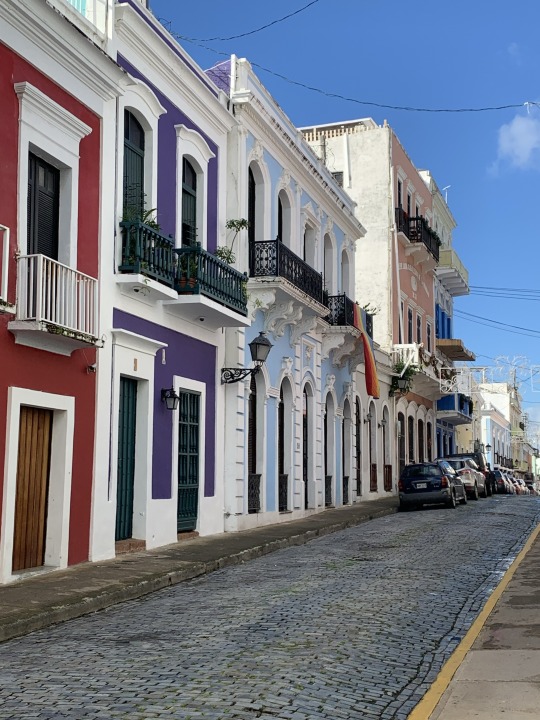
Above: Colorful buildings and cobblestone street in Old San Juan.
Below: A bar called “Aqui Se Puede,” which means “Here We Can,” the name seemed very apropos for our endeavors in Puerto Rico.

Our training at El Bastion commenced with a lovely physical warmup led by Alejandra Martorell which drew heavily on developmental movement, a methodology that focuses on training and expanding one’s proprioception and fine motor skills (chiefly in babies), and body contact/weight sharing. Everyone seemed most intrigued by the vestibular portion of the warm up, in which we made ourselves dizzy in order to reorient ourselves and holistically awaken our bodies. Our time with Alejandra was then followed by an introduction to mask work with Deborah Hunt. Before we ever gazed upon a mask, we practiced the simple task of pretending to be skilled fisherman throwing a fifty pound net into the sea, all the while exercising the “magic if” and carefully observing our peers movement qualities. After many attempts at throwing the net, carefully stealing from our peers, and accumulating the knowledge, we were finally able to try out the masks. Deborah set out a series of masks from which we each selected one that seemed to call to us. We then took the masks to our own private part of the space, studied the emotion on its face, and transformed our bodies and movement patterns to match the mask.

Above: Students engage in a physical warmup using partnering and weight sharing techniques.

Above: Students move through the beginning stages of the “flocking” exercise.
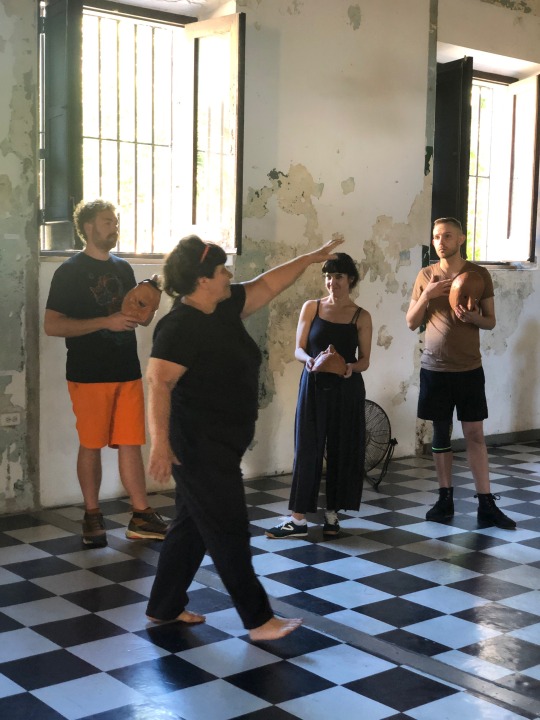
Above: Artist Deborah Hunt gives instructions to students during an introduction lesson on mask work.
In the afternoon, we began our exploration of Applied Theatre with Javier in an intense conversation about the pedagogies of Paulo Freire and Augusto Boal, the nature of education, the necessity of building a safe space, and then moved through a handful of Boal’s exercises.
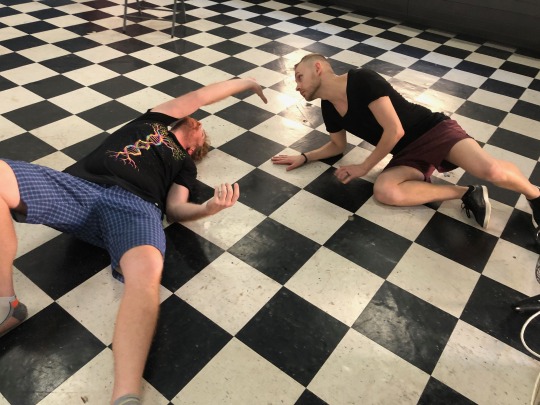
Above: JW and Daniel participate in the “magician” exercise.

Above: The whole groups participates in the centipede exercise.
On Wednesday morning, the participants focusing on mask work joined Deborah at the studio Casa Taller, while those working on physical theatre met Alejandra at El Bastion. As I was in the group at Casa Taller, I will speak to that experience, which was quite rigorous and surprisingly physically exhausting. We began the session with a tour of Casa Taller, which was then followed by a series of warm up stretches in the upstairs studio—beginning with our feet and working our way up the body, ultimately ending with facial and eye muscle stretches, discerning between “big eyes” and “bright eyes.” We moved into an exploration of different centers of physical lead (knees, thighs, belly, chest, head, etc), which we used to locomote through space while exploring different character archetypes. This is an exercise derived from the work of French theatre practitioner Jacques Lecoq. Once we had warmed up and explored different characters, we moved into mask work, again letting different masks speak to us, putting them on, and transforming our bodies to match their qualities. Eventually, we moved into the study of counter masks, which is the alter ego of the mask that embodies, in some ways, its opposite, though in reality it is a hidden emotional quality belonging to the mask.
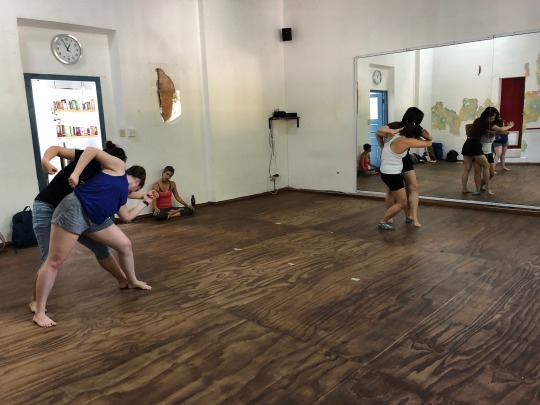
Above: Physical Theatre students work with Alejandra in the dance studio at El Bastion.
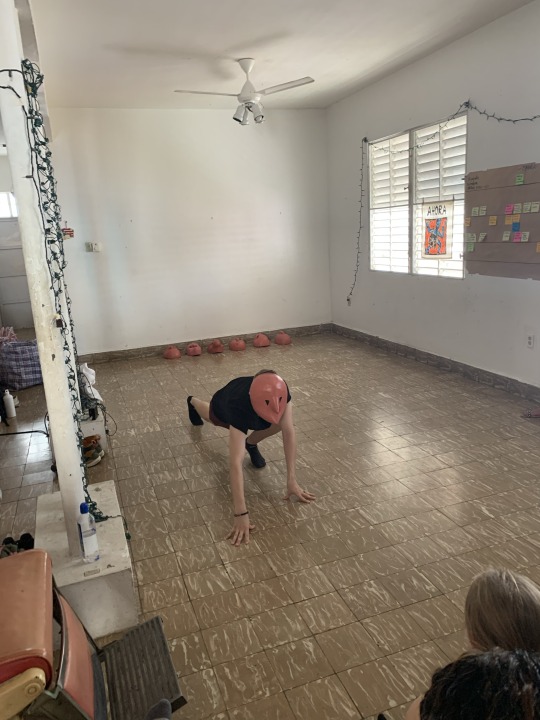
Above: Student Daniel Leeman Smith explores the possibilities of a mask in front of the class.
In the afternoon, we returned to El Bastion, where we joined the physical theatre students for another session of applied theatre with Javier. In this session we continued our discussion of the nature of education and the oppression of conformity that is often thrust upon students. We moved through several of Boal’s exercises, which address power dynamics and reframe the ways in which participants think about certain experiences by providing them alternative views. Perhaps the most exciting activity was the creation of still images based on impossible tasks. The participants were split into two groups which then devised images in which the person making the “proposal” (offering an idea or suggestion) had to be lifted off of the ground while maintaining the picture. One group presented the image of sleeping on a cloud, while the other presented the image of jumping into the sky and never coming down.
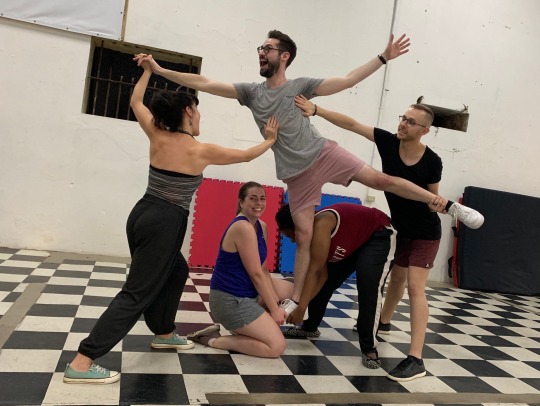
Above: Aaron holds the pose of “jumping into the clouds and never coming down” with the support of Carey, Kasey, Shari, and Daniel.
In the evening, post dinner, we returned to El Bastion for a public performance of work by our teachers Alejandra Martorell and Javier Cardona Otero, which was followed by a stirring talkback with the audience. Alejandra’s work was centered on the history of dance in Puerto Rico, and the renowned teacher Petra Bravo, while Javier’s performance was centered on his identity as a person of color who is also queer and from Puerto Rico, and what it is like to shed the labels and hurt that others force upon us, while also exploring the complicity of the audience in the perpetuation of oppression.
Three days of the program has passed, and already it seems like we have been here for a month, and I mean that in absolutely the best way. I am looking forward to continued growth, to performing with our teachers in the festival of San Sebastián at the end of next week, and to further supporting our Puerto Rican brothers and sisters.
Until next time.
Signing off.
Daniel Leeman Smith
NOTE: Videos are posted below with captions.
vimeo
Above: Students participate in a partnering and weight sharing exercise led by Alejandra.
vimeo
Above: Student Daniel Leeman Smith explores character through body and mask work.
vimeo
Above: Aaron explores the mask and counter mask of one of Deborah’s creations.
vimeo
Above: Group 1 performs the impossible task of “jumping into the clouds and never coming down.”
Below: Group 2 performs the impossible task of “sleeping on a cloud.”
vimeo
1 note
·
View note
Text
Day 20, Monday July 22, 2019
Day two in DC – I woke up and walked across the street to have breakfast. Considering everything was either shut or had closed early since the day before was Sunday (strange enough, most of things are not open on this day of the week). I was meant to meet with Casey Smith after breakfast at the Folger Shakespeare Library.

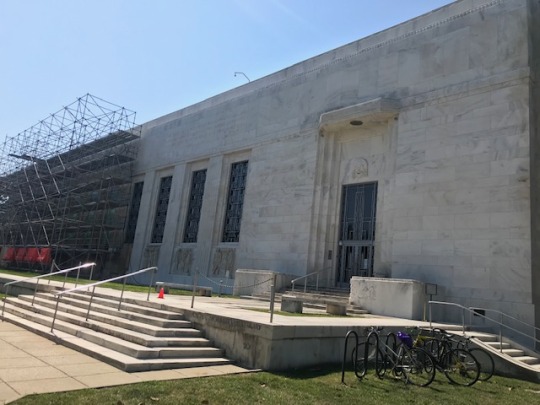
I walked into the library and asked to meet with Casey, the man behind the counter opened up a large book and went through it looking to see if the name existed, but it did not. I was not sure as to how I was meant to identify and contact a man I had not seen, without a number to call on (moments like these I am reminded how technology has completely ruined us with utter convenience and laziness!) I walked out and quickly called Abbie, and just as I was leaving her a voice note, a man walked up the stairs of the library and looked straight at me, walked into the library and turned back around and introduced himself to me – it was Casey (what a relief, I thought to myself – I hate being late for meetings).
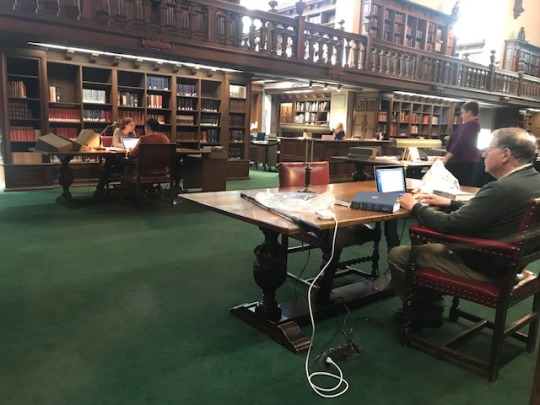
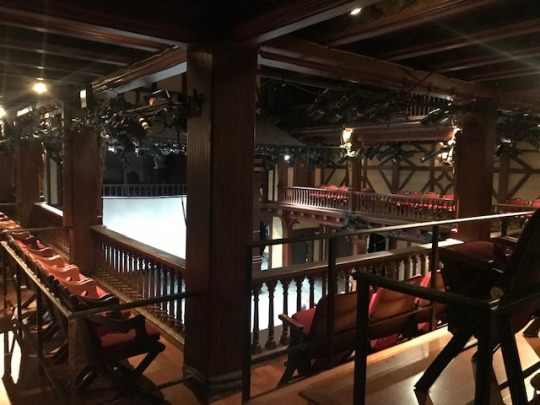
We went inside and sat in the corridor outside the main library room, as we talked I noticed an exhibit regarding the Library surrounded us. He told me about his association with Apexart and about his fellowship programme that he had just returned from Kampala, Uganda. We both sat and shared our experiences, if was great to hear his stories. He showed me around the library and snuck me into the globe theatre room, that had been recreated from the original and I quickly had a look around. The Folger Shakespeare Library is an independent research library on Capitol Hill. It is known to have the largest collection of the printed works of William Shakespeare, and is a primary repository for rare materials from the early modern period.



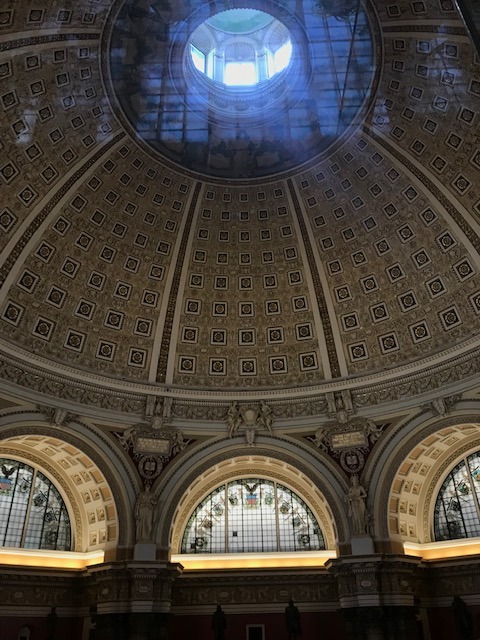

As we talked more, we walked we walked over to the Library of Congress, and took the underground tunnel to Jefferson and Madison buildings. The tunnel was such an amazing experience, to know that there were so many buildings on Capitol Hill that were connected this way. We explored the Jefferson building first, saw the main library, and the beautiful dome that cupped the room, with stained-glass windows the fell under the curve.
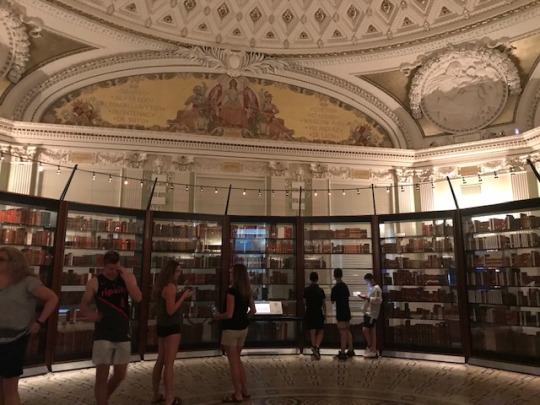
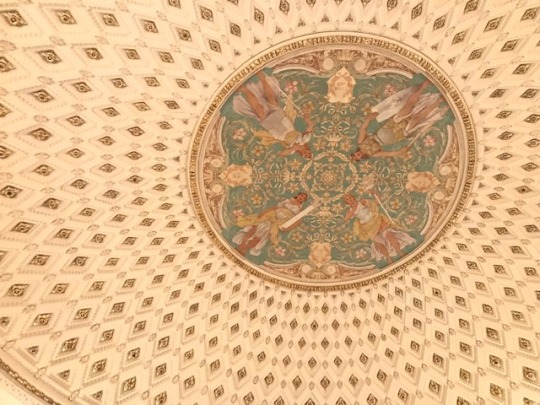

Then we went over to Thomas Jefferson’s Library, it was the reconstruction of of his original library. The books had been arranged in an order that Jefferson described as ‘sometimes analytical, sometimes chronological, and sometimes a combination of both.” The books were divided into categories of “Memory”, “Reason”, and “Imagination” - which Jefferson interpreted as”History”, “Philosophy” and “Fine-Arts” - and further divided into forty-four chapters.

There was another exhibit that we walked through, “Shall Not Be Denied”, women fight for the vote.


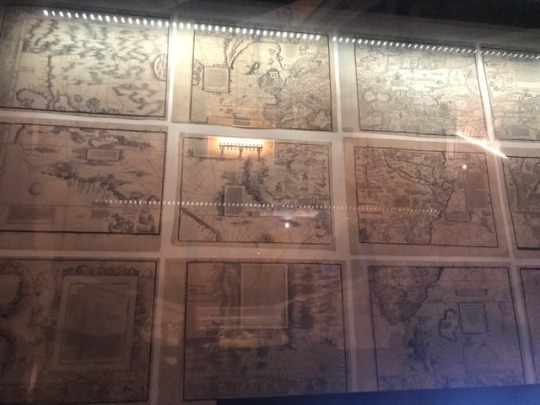
Another exhibit or manuscripts and maps - I have such a weakness for old maps and manuscripts - I couldn't resist and asked Casey to stay see a few more minutes while I had a look.
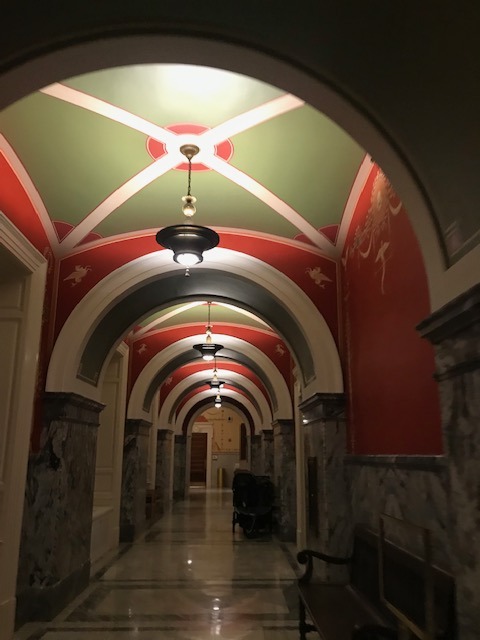

Casey, showed me around and we saw other rooms within the building and walked down long halls - it was a space I would love to get lost in and explore more.
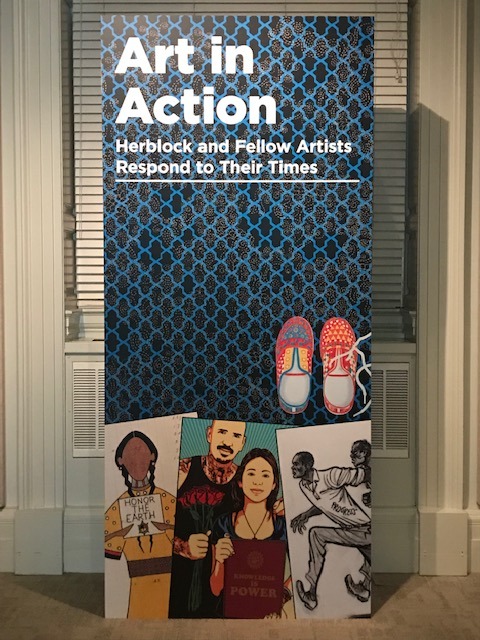
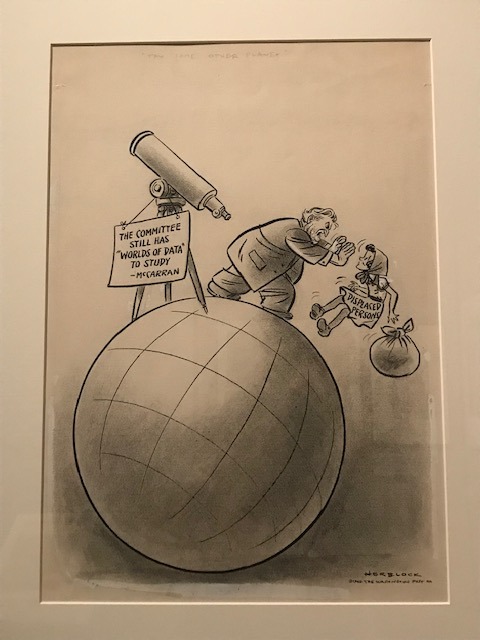

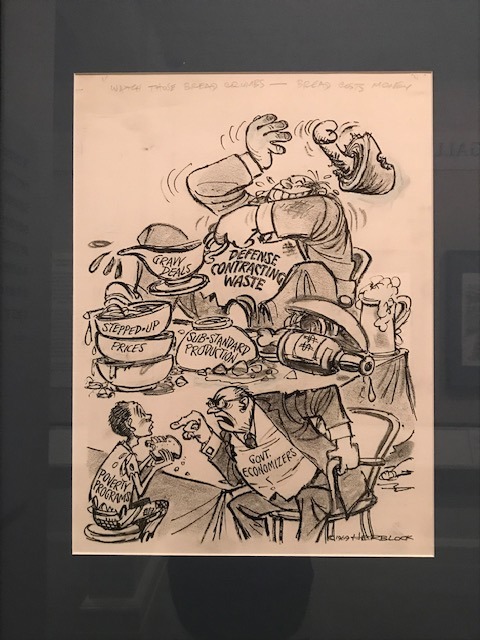

There was also an exhibit on “Art in Action”, Herblock and Fellow Artists Respond to Their Times. The was exhibition inspired by original drawings created for distribution in newspapers. Many of the themes were reflection’s on society’s most urgent concerns, that hope to create dialogue, along with civil rights, gender, and women’s issues, the environment, and many others.
We were running out of time and there was so much we had rushed through and seen - that it was almost lunch time. We talked more about over lunch at this bar that was close to the museums I was meant to go see after. We shared thoughts and ideas linked to our professions and the fellowship program. I also asked him to recommend the next activity, that was to select and explore any one Smithsonian Museum, which I had about two and a half hours to do before the storytelling night at the Bus Boys and Poets. He suggested I was through the National Gallery of Arts on Constitution Avenue, begin from the East building and take the tunnel to the West and make my way out and to Hirshhorn Museum and Sculpture Garden, the museum of choice.
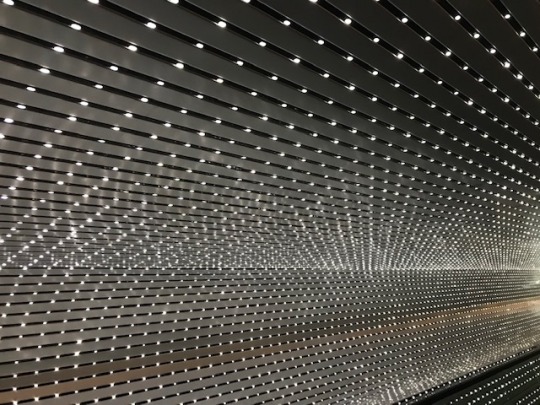
Skeptical at first thinking I would not have enough time to check everything off my list, I went ahead and took the risk and managed my time, I am so glad I did so, the National Gallery of Arts, was such a delights with works from the old masters, and ones that were stunning to finally see hanging on the walls in front of me.

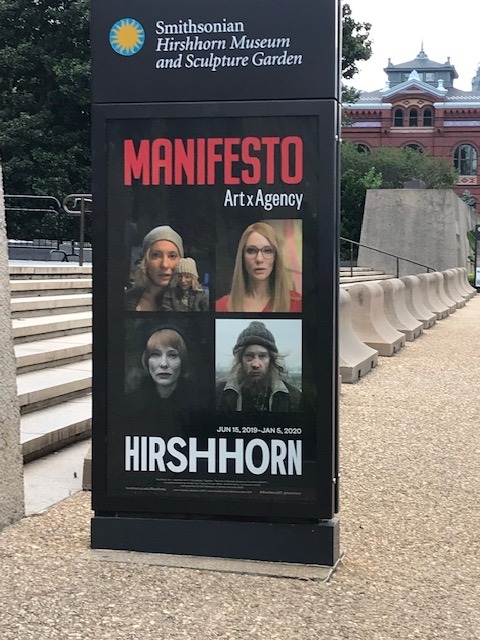
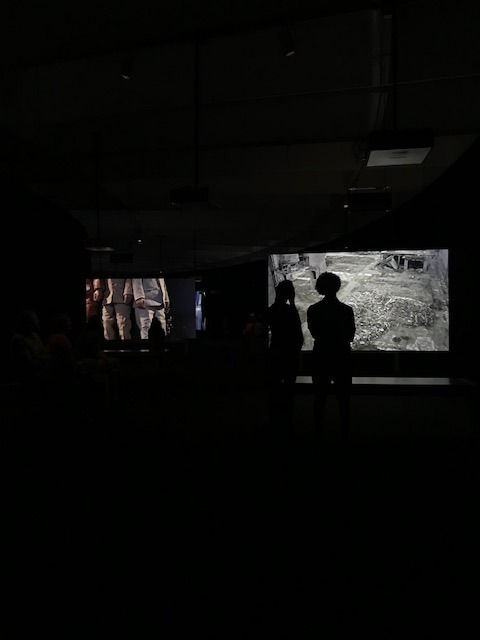

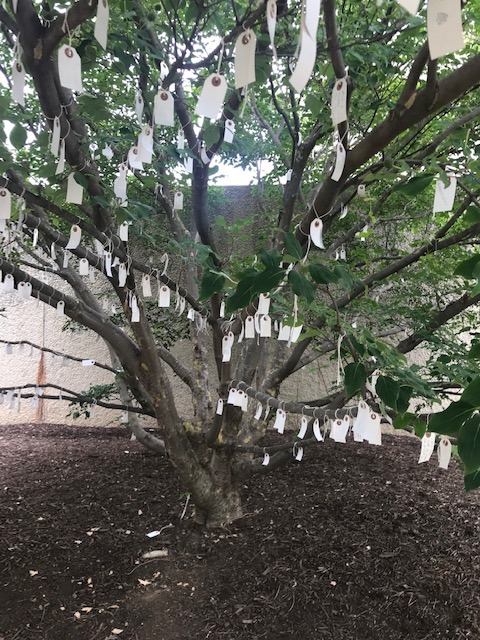

I made my way to Hirshhorn Museum, it was all a little rushed as I was on such a tight schedule but I saw everything, I made sure I missed nothing. The Hirshhorn Museum, a Brutalist building an architectural style that appeals to me greatly - what a treat! The most exciting part about the museum was, Manifesto: Art x Agency is a group exhibition that examines the art historical impact of artist manifestos from the 20th century to present day. I quickly walked over to the sculpture park and made my way to the bus stop.
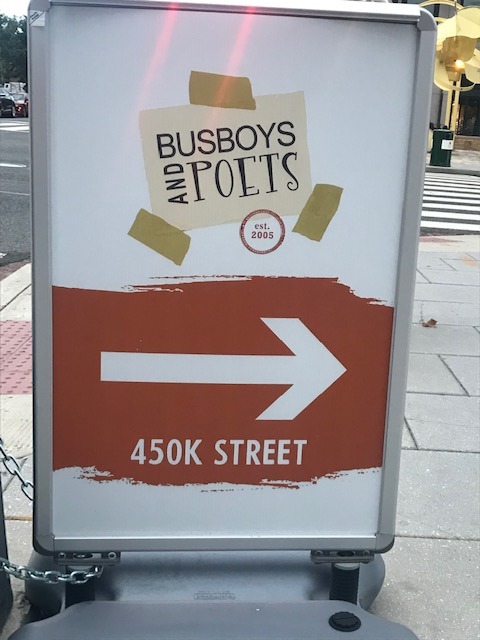

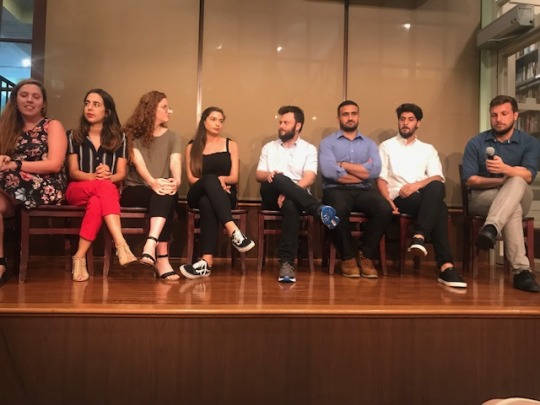
The Bus Boys and Poets was next on my list, storytelling night, and I had some time to catch happy hour - a few bites of Sushi, in ChinaTown D.C. I was not sure what I would have been expecting at storytelling night, to my surprise, they were stories told by young Israeli’s and Palestinian’s who had experienced the Israeli-Palestinian conflict first-hand. Their mission is to equip a new generation of Palestinian and Israeli leaders with the tools to become more effective agents of change through activism by changing the old story of futility, NSL fellows will hope to create a New Story of a possibility for a better Israel and Palestine. I left the venue with such warmth and inspiration, but my night was not to end here.


The next and last stop, was the late night bookstore, Kramerbooks & Afterwords Cafe. The bookstore opened in 1976, and was the first bookstore/café in Washington DC at the time. It was also, the only thing open at that time - D.C. sleeps too early, and does not make enough noise as you walk the streets to make your way back to your hotel - anytime post 9:00 pm, is a quite night. Oh D.C. I cannot wait for the morning to make my way back to where I seemed to have left my heart - New York City!
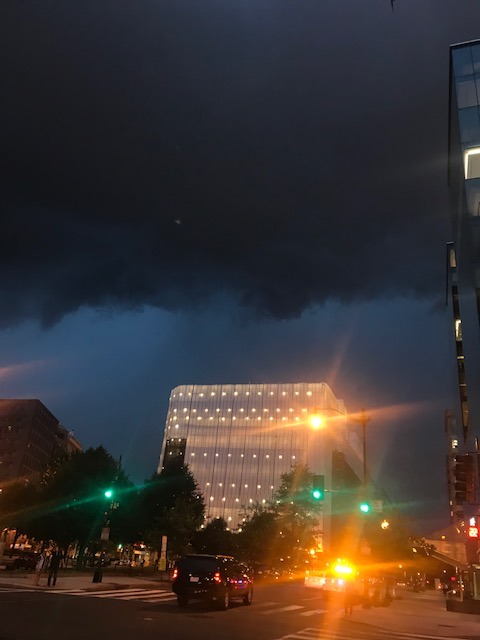
#washington#d.c.#folger shakespeare library#congresslibrary#nationalgalleryofart#smithsonian#museum#constitutionavenue#busboysandpoets#storytelling#agentsofchange#kiran ahmad#inbound from karachi
0 notes
Text
Flight and First day in Seoul
6.24.17~6.26.17
Our flight to Toronto left Columbus around 10:30. It was a fairly small flight, seating no more than 50 people. It was a pretty fast and easy flight, which was lucky because the bathroom was broken on that plane, so that could have been disastrous.
We got into Toronto and the airport may have looked small from the outside but the inside was very big, fancy and artsy; they had mini art galleries and shopping boutiques; there was a coach store and a Victoria secret store. Our connecting flight to Seoul was delayed by about 25 minutes so we all decided to get some snacks and whatnot since we were all hangry.
After about an hour and a half we boarded the connecting flight to Seoul and the take off preparations/safety instructions were very interesting; they were repeated in about 5 languages: English and french because we were in Canada, and then Korean, Chinese and Japanese because we were flying into Seoul. i can’t really remember, but there might have been Spanish too, for some reason. For about the first few hours we were very excited about the flight: the food, the mini television screens that had everything you could want on them. We all watched a movie together but towards the end of that one I was starting to doze off every now and then. During that movie we got our first meal which was a dinner. It was surprisingly very good, especially for being airplane food. The main part was rice with marinated beef, cabbage and lettuce. There was also a salad, bread, and a brownie.
At this point it already felt like it had been forever since we had been on the plane even though it had only been roughly 3 hours, so I decided to try and get some sleep even though we had all been playing on staying up so that we could been on the time zone when we got there. It was not a very deep or comfortable sleep but I did what I could. When I woke up I looked through some more movies and shows and found some episodes of the middle so I watched all of those. I then found an episode of fairly odd parents and watched that. With nothing much else to do I watched the latest bourne movie. Somewhere in the middle of that we got a small snack that had a mini sandwich, pretzels, some type of cracker/cookie, and I ended up getting some coffee to help me stay up. I finished the bourne movie and finally picked a Korean movie to watch. Id heard that it was really good so I decided to watch it…I ended up crying at the end, it was sooo sad…even though it was in the comedy section. towards the last few hours of the flight we got a breakfast and that was even better than the dinner. We got an omelet with sausage and potatoes and a spinach sauce. There was also a fruit cup and bread.
The descent and landing was a bit rough; there was a lot of turbulence, probably the most I have ever felt. There were a few times that you could actually feel the plane drop for a second or two and you could feel your stomach drop. It was almost like we were on a roller coaster. The landing itself went pretty smoothly though.
After we landed we had about 3 hours until the shuttle bus left to take us to the dorms so we exchanged currency, got some food and other little things we needed to do. at that point we were all just so exhausted and wanted to get back and sleep as soon as possible. once we got on the shuttle we had about an hour drive from Incheon airport back to the dorms which are about half an hour outside the very middle of Seoul. The drive there was very interesting, the way people drive here is insane, especially the bus drivers. People just weave in and out, and change lanes so fast and seemingly without a care. When we got to around the campus the driver had no idea where our specific building was or where to drop us off so he just stopped the bus in the middle of the road to call someone and ask where to go…that was very mind boggling. When we eventually figured out where to go, walking to the building was a whole other adventure in itself. I don’t think there is a flat piece of ground anywhere in this city, so we had to lug our bags up and down multiple hills to get to the dorm. On one very steep hill one girl accidentally let go of her bag and it went flying down the street and almost took someone out. that gave me so much second hand embarrassment, it’ll last me enough for a lifetime.
We got to the dorm around 10pm and had to do some stuff for check in and whatnot. Once we got to the rooms we realized there were several things that we were all missing, so we all went down to the convenience store that is right around the corner. Let me tell you, the convenience stores in America have nothing on the ones here, they are amazing. They literally have everything you could need and everything is so cheap. They have an entire section just dedicated to different types of ramen and they even have a ramen making station, complete with a microwave. They know what they're doing here. One big thing was that none of the rooms had toilet paper so we bought two giant packs to share with pretty much the entire hallway, but we have not really given them to anyone yet so I currently have about 15 rolls of toilet paper sitting under my desk.
Once we got everything we headed back to the rooms because everyone was pretty tired. I ended up just taking a shower and then going to sleep. Another thing that is awesome is the shower. The whole bathroom itself is pretty much the shower; the floor in the bathroom is about an inch or two below the floor in the rest of the room, and there is a drain in the shower but also in the middle of the floor outside of the shower door. That way, it doesn’t matter if you get water everywhere…it stays in the bathroom and drains.
Waking up the next day was kinda hard because we had to meet the program staff outside the building at 8am sharp to head to our orientation at the program office in the city. The trek there was the first time we were all going to be taking public transportation to the city, and the transit system here is very intimidating at first. In the Seoul metropolitan area, I believe there is a total of 18 subway lines and I don’t even want to think about the buses. Despite it being scary, the transit system is sooo nice and it works so well, so much better than in the US. To ride the subway and buses you have to buy a card, called a “T-Money” card. You basically just load money onto that card every now and then to scan and pay at the stations. Whats really nice is that if you need to take the bus after the subway, it doesn’t charge you for the bus if you get on it within 30 minutes of getting off the subway.
So getting to the office wasn’t too hard but it was really frustrating. The third party program that we went through that brought us to Korea University had a total of 66 students in it. taking 66 american students on the subway is very complicated and very headache inducing. Especially when a lot of these students are heavily reinforcing the stereotype of loud obnoxious Americans by being so loud to the point of being disrespectful. But we mad it there in one piece without being scolded so I guess that’s a mission accomplished. From the subway we had to walk quite a ways to get to the building and it was scorching hot. From what I recall it was around 85 degrees with 80% humidity: I was literally dripping sweat. While we were all dying of heat, there were so many people that we saw walking that were in pants or long sleeves that looked perfectly fine, not a drop of sweat on them.
Once we got to the building they told us that the office was on the 11th floor, which was somewhat shocking. That is one very cool thing about the city, everything is just stacked on top of each other. Since Korea itself does not have a lot of land, (apparently the entire country is smaller than Minnesota), things are built upwards instead of outwards. The building however only had one elevator and only took like 6 people at a time, so at some point we just decided to take the stairs, which was a bad idea. By the time we got to the top, I felt very American. I was sweating buckets, breathing like I’d run a marathon and it made me realize how long it’s been since I last exercised.
The orientation itself wasn’t too interesting, just going over stuff we needed to know about classes and safety and whatnot, and it lasted way too long. After we got done, they took us to Gwanghwamun market that was nearby for lunch. We didn’t have a lot of time so we found a little place to just stop by and get some food at. We got some ddeokboki which is spicy rice cake and I got naengmyun which is a buckwheat noodle soup. It took longer than expected so we had to leave before we could finish all the food so we felt pretty bad, but we were gonna be late if we didn’t.
after lunch we headed to Gwanghwamun square that is a big plaza in the middle of an eight lane highway that leads up to Gyeongbok Palace. In the square, there are two statues, one of Admiral Yi Sun Shin and one of King Sejong, who invented hangul, the written alphabet during the Joseon dynasty. Across from the square in the main gate of Gyeongbok palace, which was the royal palace of the Joseon dynasty and was built in 1395. It was really just incredible to see this beautiful old palace right in the middle of the city among huge modern buildings. Inside the palace it was amazing to see a lot people in hanbok, which is the traditional Korean dress. It seemed like a lot of people, especially couples go there to take pictures in their hanboks. The architecture was absolutely breathtaking and it was hard to take in how big the whole place was. It really made me wonder about what it would have been like when it was built and what life was like inside of it. everything about it was just so beautiful and incredible, it was so amazing to be able to walk around and experience it.
one funny thing was we actually met someone from ohio while we were walking around. We wanted to take a group picture next to one of the buildings and the person we asked to take our picture was from here. He was actually a part of the broadway tour that was performing the musical Chicago in seoul, so that was just very interesting to meet someone coincidentally like that.
After touring the palace, we went to a shop that rented out hanboks and had sessions for people to try them on and take pictures. It was definitely a new and interesting experience, but it was towards the end of the day so we all were tired and sweaty and probably smelled really bad. but after we finished there, we were done with group activities so they just released us into the city to do whatever and then find our own way back. Amanda has a friend who lives in seoul and owns a brewery/restraurant so we headed to one of his restaurants in Hyundai Mall for dinner around 6. I ordered some chicken and ended up getting what seemed like 2 whole chickens, I think there was around 20 wings, so I definitely did not finish them all. While we were eating we saw a mini stand that was serving drinks in lightbulbs. It was the cutest thing and we simply could not pass it up. It was called “Bulb Smoothie” and for some reason that just cracked us up. The guy working the stand was very cute and charming so that made it even better hehe. We ended up staying until the mall closed at 9 and then made the long ride back to the dorms and pretty much knocked out as soon as we got in our rooms. We had early morning the next day for another orientation so we all wanted some good sleep.
I think i’ll save the next day for a different post so this one doesn’t turn into a novel, although it’s already pretty long by now. So if you made it this far, all the way to the end I applaud you.
-Bea
2 notes
·
View notes